Teotihuacan


Teotihuacan
TEOTIHUACAN: Pyramids of the Moon and the Sun from the Citadel / Pirámides de la Luna y el Sol desde la Ciudadela
In the first century, Central Mexico saw the rise of the powerful culture of Teotihuacán. The giant city of Teotihuacán was the center of this culture, which would dominate the political history of ancient Mexico for the next 800 years. With an area of 30 square kilometers and a population of 250,000 inhabitants, Teotihuacán was the largest city of the period and one of the largest cities in the world. The people of Teotihuacán built monumental temples, streets, marketplaces and palaces and decorated them with splendid relief, murals and ground paintings.
One of the most important temples was the Temple of the Feathered Serpent. Originally painted in bright colors this temple was part of the ciudadela or citadel, a complex, which served as dwellings and administration buildings for the lords of Teotihuacán.
TEOTIHUACAN: Pyramids of the Moon and the Sun from the Citadel / Pirámides de la Luna y el Sol desde la Ciudadela
In the first century, Central Mexico saw the rise of the powerful culture of Teotihuacán. The giant city of Teotihuacán was the center of this culture, which would dominate the political history of ancient Mexico for the next 800 years. With an area of 30 square kilometers and a population of 250,000 inhabitants, Teotihuacán was the largest city of the period and one of the largest cities in the world. The people of Teotihuacán built monumental temples, streets, marketplaces and palaces and decorated them with splendid relief, murals and ground paintings.
One of the most important temples was the Temple of the Feathered Serpent. Originally painted in bright colors this temple was part of the ciudadela or citadel, a complex, which served as dwellings and administration buildings for the lords of Teotihuacán.
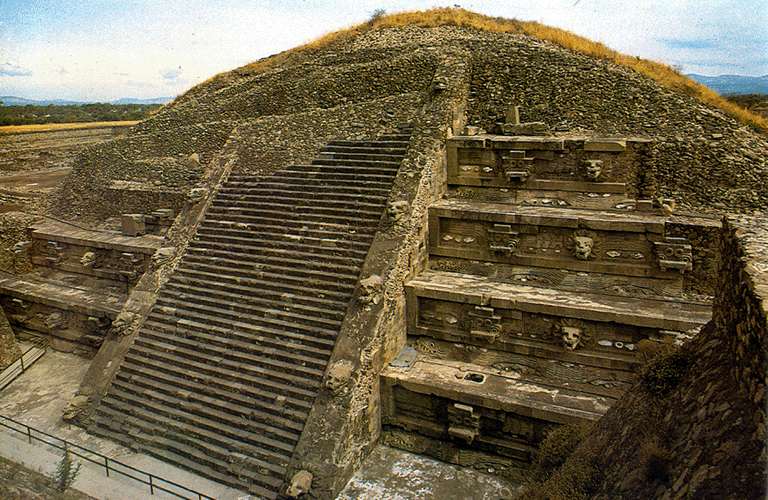
The Temple of the Feathered Serpent is the modern-day name for the third largest pyramid at Teotihuacan, a pre-Columbian site in central Mexico. This structure is notable partly due to the discovery in the 1980s of more than a hundred possibly-sacrificial victims found buried beneath the structure. The burials, like the structure, are dated to some time between 150 and 200 CE. The pyramid takes its name from representations of the Mesoamerican "feathered serpent" deity which covered its sides. These are some of the earliest-known representations of the feathered serpent, often identified with the much-later Aztec god Quetzalcoatl The structure is also known as the Temple of Quetzalcoatl, and the Feathered Serpent Pyramid.
Location
The Temple of the Feathered Serpent is located at the southern end of the Avenue of the Dead, Teotihuacan's main thoroughfare, within the Ciudadela complex. The Ciudadela (Spanish, "citadel") is a structure with high walls and a large courtyard surrounding the temple. The Ciudadela’s courtyard is massive enough that it could house the entire adult population of Teotihuacán within its walls, which was estimated to be one hundred thousand people at its peak. Within the Ciudadela there are several monumental structures, including the temple, two mansions north and south of the temple, and the Adosada platform. Built in the 4th century, the Adosada platform is located just in front (west) of the Temple of the Feathered Serpent, obscuring its view.
Location
The Temple of the Feathered Serpent is located at the southern end of the Avenue of the Dead, Teotihuacan's main thoroughfare, within the Ciudadela complex. The Ciudadela (Spanish, "citadel") is a structure with high walls and a large courtyard surrounding the temple. The Ciudadela’s courtyard is massive enough that it could house the entire adult population of Teotihuacán within its walls, which was estimated to be one hundred thousand people at its peak. Within the Ciudadela there are several monumental structures, including the temple, two mansions north and south of the temple, and the Adosada platform. Built in the 4th century, the Adosada platform is located just in front (west) of the Temple of the Feathered Serpent, obscuring its view.
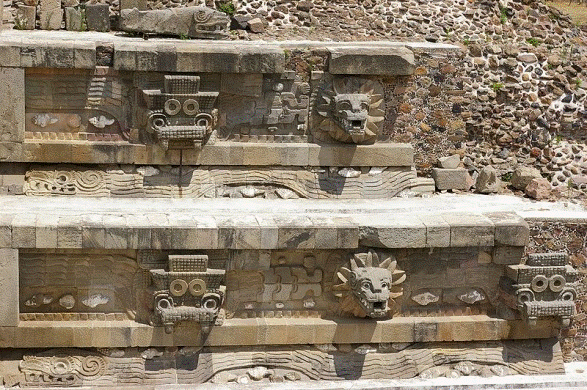
Detail of the pyramid, showing the alternating "Tlaloc" (left) and feathered serpent (right) heads. Note the long undulating feathered serpents in profile under the heads.
Architecture
The Feathered Serpent Pyramid is a six-level step pyramid built in the talud-tablerostyle. The outside edges of each level are decorated with feathered serpent heads alternating with those of another snake-like creature, often identified as Tlaloc. Nevertheless, Mary Ellen Miller and Karl Taube claim that these heads may represent a "war serpent",while Michael D. Coe claims, somewhat similarly, that they probably represent the "fire serpent" wearing a headdress with the Teotihuacan symbol for war. In the eyes of these figures there is a spot for obsidian glass to be put in, so when the light hits, its eyes would glimmerIn antiquity the entire pyramid was painted – the background here was blue with carved sea shells providing decoration. Under each row of heads are bas-reliefs of the full feathered serpent, in profile, also associated with water symbols. These and other designs and architectural elements are more than merely decorative, suggesting "strong ideological significance", although there is no consensus just what that significance is. Some interpret the pyramid's iconography as cosmological in scope – a myth of the origin of time or of creation – or as calendrical in nature. Others find symbols of rulership, or war and the military.
Today the pyramid is largely hidden by the Adosada platform hinting at political restructurisation of Teotihuacan during the fourth century CE, perhaps a "rejection of autocratic rule" in favour of a collective leadership. Following excavations in the early 20th century, a section of a façade on the monument's west side was discovered. This section is believed to date from the late 3rd century. Fantastic and rare carvings on the surfaces show depictions of the feathered serpent deity, other gods, and seashells on panels on either side of a staircase.
Condition and conservation
Since the structure has been been exposed to the elements for the entire duration of its history, rain and groundwater, crystallization of soluble salts on the surface, erosion, and biological growth have caused deterioration and loss of stone on the surface. Tourist visitation also accelerated the deterioration. In 2004, the Temple of Quetzalcoatl was listed in the 2004 World Monuments Watch by the World Monuments Fund. The organization provided assistance for conservation in cooperation with the Instituto Nacional de Antropología e Historia and with help from American Express.
Architecture
The Feathered Serpent Pyramid is a six-level step pyramid built in the talud-tablerostyle. The outside edges of each level are decorated with feathered serpent heads alternating with those of another snake-like creature, often identified as Tlaloc. Nevertheless, Mary Ellen Miller and Karl Taube claim that these heads may represent a "war serpent",while Michael D. Coe claims, somewhat similarly, that they probably represent the "fire serpent" wearing a headdress with the Teotihuacan symbol for war. In the eyes of these figures there is a spot for obsidian glass to be put in, so when the light hits, its eyes would glimmerIn antiquity the entire pyramid was painted – the background here was blue with carved sea shells providing decoration. Under each row of heads are bas-reliefs of the full feathered serpent, in profile, also associated with water symbols. These and other designs and architectural elements are more than merely decorative, suggesting "strong ideological significance", although there is no consensus just what that significance is. Some interpret the pyramid's iconography as cosmological in scope – a myth of the origin of time or of creation – or as calendrical in nature. Others find symbols of rulership, or war and the military.
Today the pyramid is largely hidden by the Adosada platform hinting at political restructurisation of Teotihuacan during the fourth century CE, perhaps a "rejection of autocratic rule" in favour of a collective leadership. Following excavations in the early 20th century, a section of a façade on the monument's west side was discovered. This section is believed to date from the late 3rd century. Fantastic and rare carvings on the surfaces show depictions of the feathered serpent deity, other gods, and seashells on panels on either side of a staircase.
Condition and conservation
Since the structure has been been exposed to the elements for the entire duration of its history, rain and groundwater, crystallization of soluble salts on the surface, erosion, and biological growth have caused deterioration and loss of stone on the surface. Tourist visitation also accelerated the deterioration. In 2004, the Temple of Quetzalcoatl was listed in the 2004 World Monuments Watch by the World Monuments Fund. The organization provided assistance for conservation in cooperation with the Instituto Nacional de Antropología e Historia and with help from American Express.
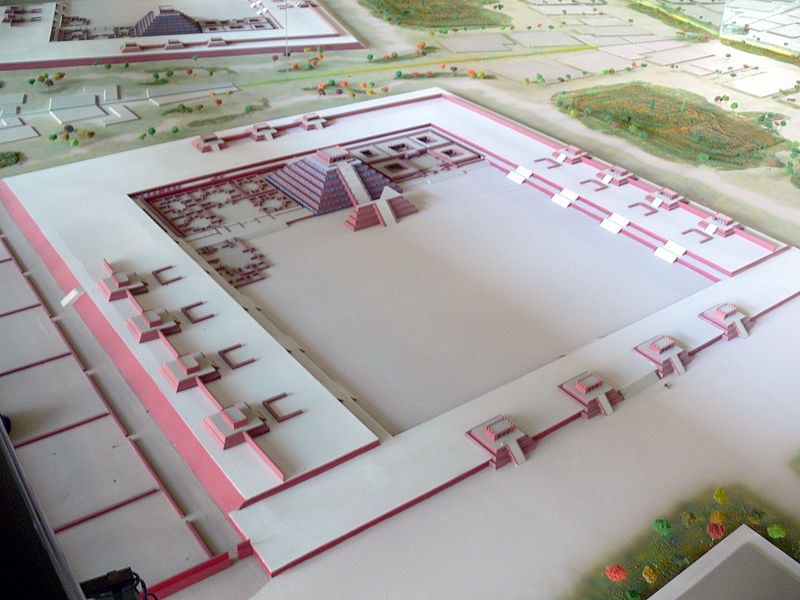
A reconstruction of the Ciudadela. The Temple of the Feathered Serpent can be seen at the upper center, with the Adosada directly in front of it.
Burials at the pyramid
Two hundred or more sacrificial burials were found at the pyramid, believed to be carried out as part of the dedication of the temple. The burials are grouped in various locations, the significance of which is not yet understood. While there are burials of both men and women, the males outnumber the females. The males were accompanied by the remains of weapons and accoutrements, such as necklaces of human teeth, that lead researchers to conclude that they were warriors, probably warriors in service to Teotihuacan rather than captives from opposing armies. The richness of the burial goods generally increases toward the center of the pyramid. At least three degrees of status have been identified, although there is no indication of a dead ruler or other obvious focal point.
Recent discoveries
On Thursday, May 26th 2011, Researchers from Mexico's National University reported that a tunnel structure had been found beneath the Temple of the Feathered Serpent using a radar device. Archaeologists there claim they have found what appears to be a series of symbols along the tunnel, 15 meters beneath the ground and 130 meters long, running eastwards and terminating in several sealed funeral chambers beneath the pyramid. The significance or orientation of the symbols is not yet understood, though it is thought they might be connected to imagery of the Mesoamerican underworld. Excavations are ongoing, and researchers are hopeful that orientation of the tunnel and position of the chambers indicate that they may contain the remains of early rulers or other high status individuals at Teotihuacan. Reseachers reported that the tunnel was believed to have been sealed in 200 CE.
Relation to the calendar
There was an apparent correlation between the Temple of the Feathered Serpent and the calendar. The pyramid also is thought to contain two hundred and sixty feathered serpent heads between the platforms. Each of these feathered serpents also contains an open area in its mouth. This open area is big enough to put a place holder in. Thus, it is believed that the people of Teotihuacán would move this place marker around the pyramid to represent the ritual calendar. When a spiritual day would arrive the people would gather within the walls of the Ciudadela and celebrate the ritual.[
Political influences
The Temple of the Feathered Serpent was not only a religious center but also a political center as well. The rulers of Teotihuacán were not only the leaders of men; they were also the spiritual leaders of the city. The two mansions near the pyramid are thought to have been occupied by powerful families. An interesting feature of the Feathered Serpent Pyramid is that there are examples of a shift in power or ideology in Teotihuacán and for the Pyramid itself. The construction of the Adosada platform came much later than the Feathered Serpent Pyramid. The Adosada platform is built directly in front of the pyramid and blocks its front view. Thus, it is thought that the political leaders lost favor or that the ideology of the Feathered Serpent Pyramid lost virtue, and so was covered up by the Adosada.
Burials at the pyramid
Two hundred or more sacrificial burials were found at the pyramid, believed to be carried out as part of the dedication of the temple. The burials are grouped in various locations, the significance of which is not yet understood. While there are burials of both men and women, the males outnumber the females. The males were accompanied by the remains of weapons and accoutrements, such as necklaces of human teeth, that lead researchers to conclude that they were warriors, probably warriors in service to Teotihuacan rather than captives from opposing armies. The richness of the burial goods generally increases toward the center of the pyramid. At least three degrees of status have been identified, although there is no indication of a dead ruler or other obvious focal point.
Recent discoveries
On Thursday, May 26th 2011, Researchers from Mexico's National University reported that a tunnel structure had been found beneath the Temple of the Feathered Serpent using a radar device. Archaeologists there claim they have found what appears to be a series of symbols along the tunnel, 15 meters beneath the ground and 130 meters long, running eastwards and terminating in several sealed funeral chambers beneath the pyramid. The significance or orientation of the symbols is not yet understood, though it is thought they might be connected to imagery of the Mesoamerican underworld. Excavations are ongoing, and researchers are hopeful that orientation of the tunnel and position of the chambers indicate that they may contain the remains of early rulers or other high status individuals at Teotihuacan. Reseachers reported that the tunnel was believed to have been sealed in 200 CE.
Relation to the calendar
There was an apparent correlation between the Temple of the Feathered Serpent and the calendar. The pyramid also is thought to contain two hundred and sixty feathered serpent heads between the platforms. Each of these feathered serpents also contains an open area in its mouth. This open area is big enough to put a place holder in. Thus, it is believed that the people of Teotihuacán would move this place marker around the pyramid to represent the ritual calendar. When a spiritual day would arrive the people would gather within the walls of the Ciudadela and celebrate the ritual.[
Political influences
The Temple of the Feathered Serpent was not only a religious center but also a political center as well. The rulers of Teotihuacán were not only the leaders of men; they were also the spiritual leaders of the city. The two mansions near the pyramid are thought to have been occupied by powerful families. An interesting feature of the Feathered Serpent Pyramid is that there are examples of a shift in power or ideology in Teotihuacán and for the Pyramid itself. The construction of the Adosada platform came much later than the Feathered Serpent Pyramid. The Adosada platform is built directly in front of the pyramid and blocks its front view. Thus, it is thought that the political leaders lost favor or that the ideology of the Feathered Serpent Pyramid lost virtue, and so was covered up by the Adosada.
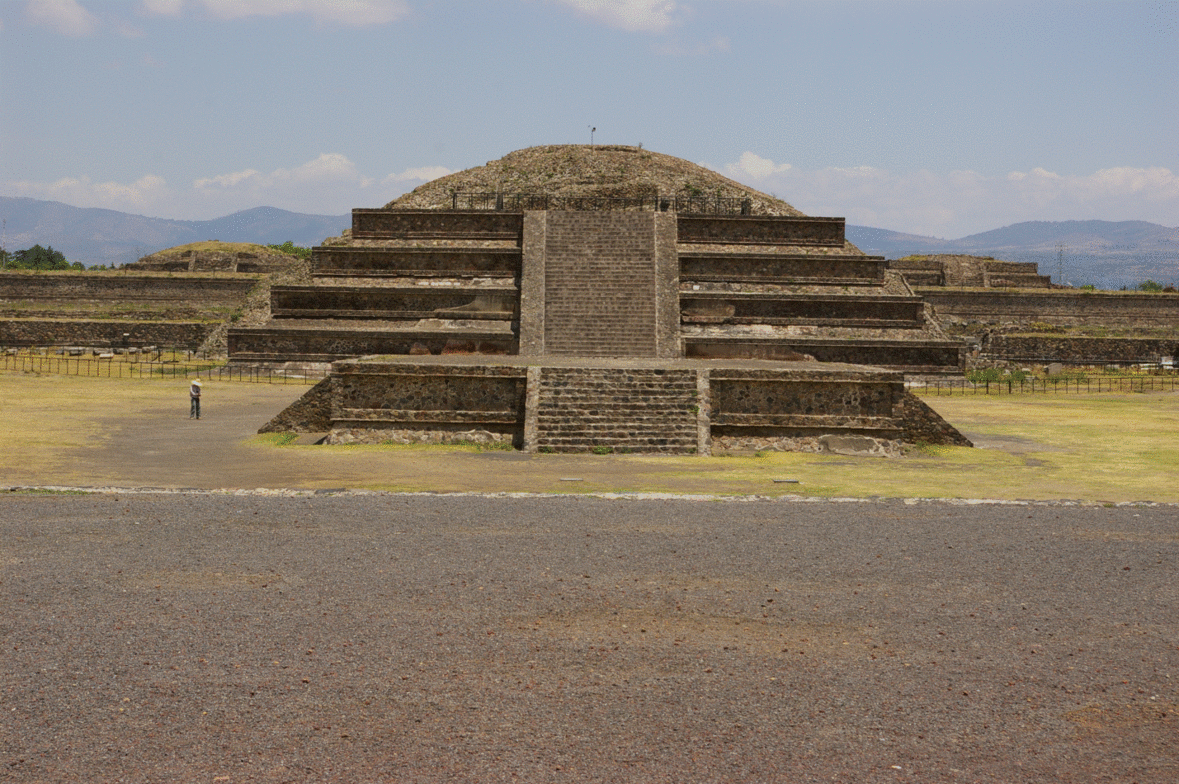



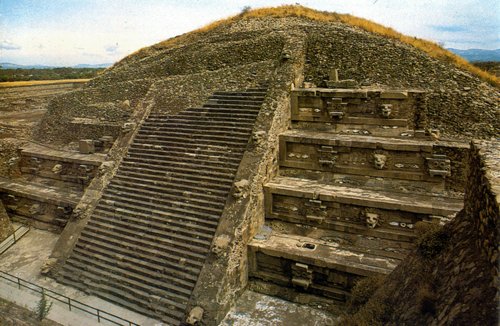
Temple of the Feathered Serpent (TeotihuacanThe Temple of the Feathered Serpent is the modern-day name for the third largest pyramid at Teotihuacan. The structure is particularly notable due to the 200 or more sacrificial victims found buried beneath the structure. Scientists date the burials to some time between 150 and 200 CE. The pyramid’s name comes from representations of the Mesoamerican “feathered serpent” deity covering the sides of the building. These are thought to be some of the earliest-known representations of the feathered serpent, often identified with the much-later Aztec god Quetzalcoatl. The structure is also known as the Temple of Quetzalcoatl, and the Feathered Serpent Pyramid.
The Feathered Serpent Pyramid is a six-level step pyramid built in the talud-tablero style. Feathered serpent heads alternating with those of another snake-like creature, often identified with Tlaloc, the lightning/rain deity, adorn the outer edges of each level of the structure. Mary Ellen Miller and Karl Taube claim the heads represent a "war serpent", while Michael D. Coe claims, that the heads probably represent the "fire serpent" wearing a headdress with the Teotihuacan symbol for war. In the eyes of these figures there is a spot for obsidian glass, causing the eyes to glimmer with light. In antiquity, the builders probably painted entire pyramid – the background most likely blue decorated with carved sea shells.
Under each row of heads bas-reliefs of the full feathered serpent, in profile, also exist. These and other designs and architectural elements suggest a "strong ideological significance" for the building overall; there is no consensus just what that significance is. Some interpret the pyramid's iconography as cosmological – a myth of the origin of time or of creation represented in stone – or a calendrical timekeeper. Others find symbols of rulership, war and the military.
On Thursday, May 26th 2011, researchers from Mexico's National University reported the discovery of a tunnel structure beneath the Temple of the Feathered Serpent using a radar device. Archaeologists claimed also the discovery of what appears to be a series of symbols along the tunnel, 15 meters beneath the ground and 130 meters long, running eastwards and terminating in several sealed potential “funeral”chambers beneath the pyramid. The significance or orientation of the symbols is not yet understood.
Excavations remain ongoing, and researchers hope that the orientation of the tunnel and position of the chambers indicate potential remains of early rulers or other high status individuals at Teotihuacan
The Feathered Serpent Pyramid is a six-level step pyramid built in the talud-tablero style. Feathered serpent heads alternating with those of another snake-like creature, often identified with Tlaloc, the lightning/rain deity, adorn the outer edges of each level of the structure. Mary Ellen Miller and Karl Taube claim the heads represent a "war serpent", while Michael D. Coe claims, that the heads probably represent the "fire serpent" wearing a headdress with the Teotihuacan symbol for war. In the eyes of these figures there is a spot for obsidian glass, causing the eyes to glimmer with light. In antiquity, the builders probably painted entire pyramid – the background most likely blue decorated with carved sea shells.
Under each row of heads bas-reliefs of the full feathered serpent, in profile, also exist. These and other designs and architectural elements suggest a "strong ideological significance" for the building overall; there is no consensus just what that significance is. Some interpret the pyramid's iconography as cosmological – a myth of the origin of time or of creation represented in stone – or a calendrical timekeeper. Others find symbols of rulership, war and the military.
On Thursday, May 26th 2011, researchers from Mexico's National University reported the discovery of a tunnel structure beneath the Temple of the Feathered Serpent using a radar device. Archaeologists claimed also the discovery of what appears to be a series of symbols along the tunnel, 15 meters beneath the ground and 130 meters long, running eastwards and terminating in several sealed potential “funeral”chambers beneath the pyramid. The significance or orientation of the symbols is not yet understood.
Excavations remain ongoing, and researchers hope that the orientation of the tunnel and position of the chambers indicate potential remains of early rulers or other high status individuals at Teotihuacan
Pyramid of the Moon
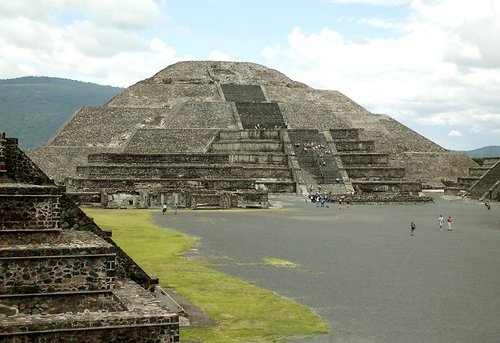
The Pyramid of the Moon is the second largest pyramid in Teotihuacan after the Pyramid of the Sun. The structure is located in the northern part of Teotihuacan and mimics the contours of the mountain Cerro Gordo, just north of the site. Some call the pyramid Tenan, in Nahuatl, meaning "mother or protective stone." The Pyramid of the Moon covers a structure older than the Pyramid of the Sun, existing prior to 200 AD.
Scientists think the Pyramid's construction fell between 200 and 450 AD, which completed the bilateral symmetry of the complex. A slope in front of the staircase gives access to the Avenue of the Dead. Archaeologists believe that a platform atop the pyramid saw use as a ceremonial place in honor of the Great Goddess of Teotihuacan, the goddess of water, fertility, the earth, and creation. The platform and the sculpture found at the pyramid's bottom are thus dedicated to The Great Goddess.
Opposite the Great Goddess's altar is the Plaza of the Moon. The Plaza contains a central altar and an original construction with internal divisions, consisting of four rectangular and diagonal bodies that formed what is known as the "Teotihuacan Cross."
Recently, archaeologists excavated beneath the Pyramid of the Moon. Tunnels dug into the structure revealed that the pyramid underwent at least six renovations and each new addition was larger and covered the previous structure.
Piramide de la Luna - Pyramid of the Moon:
Scientists think the Pyramid's construction fell between 200 and 450 AD, which completed the bilateral symmetry of the complex. A slope in front of the staircase gives access to the Avenue of the Dead. Archaeologists believe that a platform atop the pyramid saw use as a ceremonial place in honor of the Great Goddess of Teotihuacan, the goddess of water, fertility, the earth, and creation. The platform and the sculpture found at the pyramid's bottom are thus dedicated to The Great Goddess.
Opposite the Great Goddess's altar is the Plaza of the Moon. The Plaza contains a central altar and an original construction with internal divisions, consisting of four rectangular and diagonal bodies that formed what is known as the "Teotihuacan Cross."
Recently, archaeologists excavated beneath the Pyramid of the Moon. Tunnels dug into the structure revealed that the pyramid underwent at least six renovations and each new addition was larger and covered the previous structure.
Piramide de la Luna - Pyramid of the Moon:
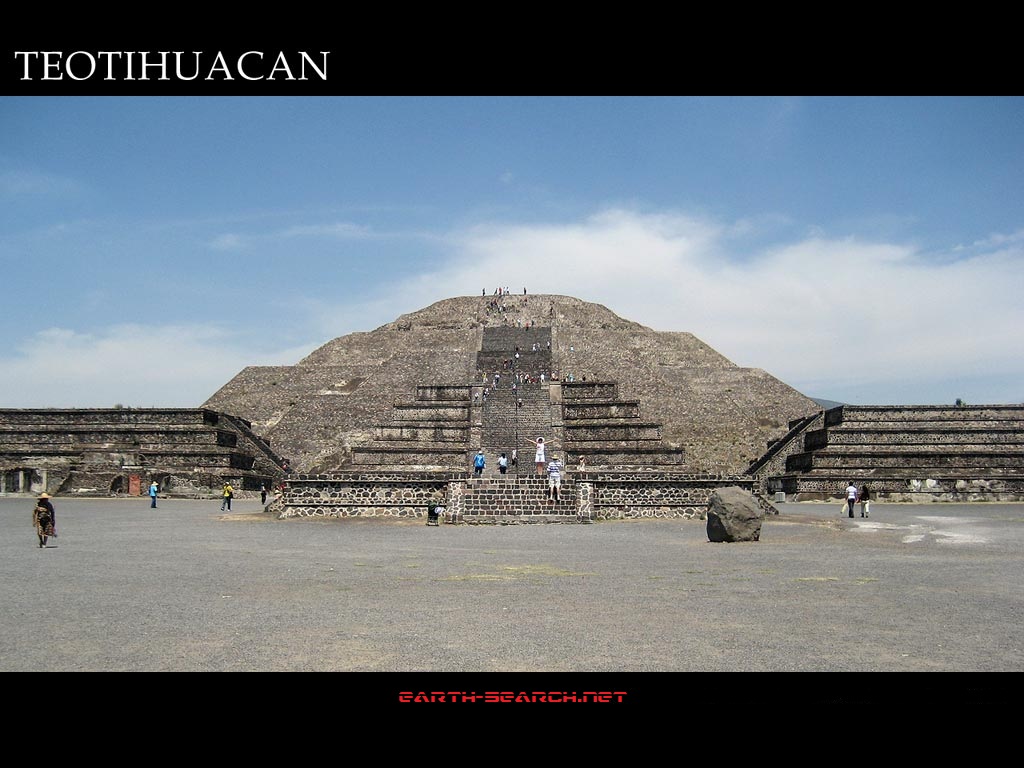
The Pyramid of the moon at Teotihuacan appears to be as tall as the Pyramid of the Sun due to the fact that it is built on higher ground. This pyramid was built slightly later than the Pyramid of the Sun, perhaps around the time the first was finished. The top of the Pyramid of the Moon provides the best overall view of Teotihuacan. The sight of the ruins stretching both sides of the mile long Avenue of the Dead opens ones eyes to how truly great this city once was.
Pyramid of the Moon
Although this pyramid is smaller than that of the Sun, it was constructed on higher ground and its peak is roughly at the same height. Here there are four tiers, and some of the steps are so large that climbing the pyramid requires much effort. It is worth at least climbing to the first platform though, for the view directly down the Calle de los Muertos is highly memorable.
Although this pyramid is smaller than that of the Sun, it was constructed on higher ground and its peak is roughly at the same height. Here there are four tiers, and some of the steps are so large that climbing the pyramid requires much effort. It is worth at least climbing to the first platform though, for the view directly down the Calle de los Muertos is highly memorable.
The Moon Pyramid is located at the northern end of the Avenue of the Dead, which was the main axis of the city. The pyramid, facing south, was built as the principal monument of the Moon Pyramid complex. The five-tiered platform was attached to the front of the Moon Pyramid.
The Pyramid of the Moon is smaller and faces a plaza at the northern end of the avenue. No cave or other feature has been discovered in its interior. Its form may be patterned on that of the sacred mountain to the north, the Cerro Gordo. The summit provides about the same range of view as you from its larger neighbor because the moon pyramid is built on higher ground. The perspective straight down the Avenue of the Dead is magnificent (and featured in the photo at the top of this article).
The plaza fronted by the Pyramid of the Moon is surrounded by little temples and by the Palace of Quetzalpapalotl or Quetzal-Mariposa (Quetzal-Butterfly) on the left (west) side. The Palace of Quetzalpapalotl lay in ruins until the 1960s, when restoration work began. Today, it reverberates with its former glory, as figures of Quetzal-Mariposa (a mythical, exotic bird-butterfly) appear painted on walls or carved in the pillars of the inner court. Behind the Palace of Quetzalpapalotl is the Palace of the Jaguars, complete with murals showing jaguars and some frescoes
The plaza fronted by the Pyramid of the Moon is surrounded by little temples and by the Palace of Quetzalpapalotl or Quetzal-Mariposa (Quetzal-Butterfly) on the left (west) side. The Palace of Quetzalpapalotl lay in ruins until the 1960s, when restoration work began. Today, it reverberates with its former glory, as figures of Quetzal-Mariposa (a mythical, exotic bird-butterfly) appear painted on walls or carved in the pillars of the inner court. Behind the Palace of Quetzalpapalotl is the Palace of the Jaguars, complete with murals showing jaguars and some frescoes
Pyramid of the Sun
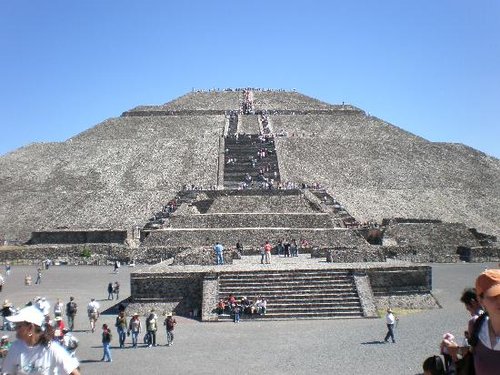
The Pyramid of the Sun is the largest building in Teotihuacan and one of the largest in greater Mesoamerica. Found along the Avenue of the Dead, in between the Pyramid of the Moon and the Ciudadela, and in the shadow of the massive mountain Cerro Gordo, the pyramid is part of a large complex in the heart of the city. The name Pyramid of the Sun comes from the Aztecs, a people that visited the city of Teotihuacán centuries after the original inhabitants abandoned the site; the name given to the pyramid by the Teotihuacanos is unknown. Teotihuacan literally means, in the Nahua native languages, “The Place where Men became gods.” Little is actually known about the site due to limited organic finds and artifacts.
The orientation of the structure may hold anthropological clues to the function of the pyramid. The Pyramid of the Sun is oriented slightly northwest of the horizon point of the setting sun on two days a year, August 12 and April 29. The day of August 12 is significant because the day also marks the date of the beginning of the present era and the initial day of the Maya long count calendar, 4 Ahau, 8 Cumku, or 3314 BC. Archaeologists state that the site thrived around 100 AD or so, but no clear evidence exists to suggest that the buildings at the site rose up around that time. In addition, many important astrological events linked with agriculture can be viewed from atop the pyramid, probably lending the structure its name, as the sun represented a vital symbol to agriculturally driven societies (light provided food for plants (photosynthesis), but too much sun with no rain caused drought).
Scientists discovered that the pyramid actually lay atop a man-made tunnel leading to a "cave" located six meters down beneath the center of the structure. Originally, archaeologists speculated the cave comprised a naturally formed lava tube and interpreted the site as the place of Chicomoztoc, the place of human origin according to long standing Nahua legends. Recent excavations suggest that the space is man-made, possibly serving as a royal tomb, although no proof exists to indicate that idea. Recently scientists used muon detectors to try to find other chambers within the interior of the pyramid.
The Teotihuacan site is one of the most visited archaeological sites in Mexico. An entire diorama layout of the city lies open to the public at the site museum
The orientation of the structure may hold anthropological clues to the function of the pyramid. The Pyramid of the Sun is oriented slightly northwest of the horizon point of the setting sun on two days a year, August 12 and April 29. The day of August 12 is significant because the day also marks the date of the beginning of the present era and the initial day of the Maya long count calendar, 4 Ahau, 8 Cumku, or 3314 BC. Archaeologists state that the site thrived around 100 AD or so, but no clear evidence exists to suggest that the buildings at the site rose up around that time. In addition, many important astrological events linked with agriculture can be viewed from atop the pyramid, probably lending the structure its name, as the sun represented a vital symbol to agriculturally driven societies (light provided food for plants (photosynthesis), but too much sun with no rain caused drought).
Scientists discovered that the pyramid actually lay atop a man-made tunnel leading to a "cave" located six meters down beneath the center of the structure. Originally, archaeologists speculated the cave comprised a naturally formed lava tube and interpreted the site as the place of Chicomoztoc, the place of human origin according to long standing Nahua legends. Recent excavations suggest that the space is man-made, possibly serving as a royal tomb, although no proof exists to indicate that idea. Recently scientists used muon detectors to try to find other chambers within the interior of the pyramid.
The Teotihuacan site is one of the most visited archaeological sites in Mexico. An entire diorama layout of the city lies open to the public at the site museum
Piramide del Sol - Pyramid of the Sun:
The Pyramid of the Sun at Teotihuacan was built in the first century AD. It has a base ten feet shorter (on each side) than the Great Pyramid of Cheops, and a volume of 2.5 million tones of stone and earth used in its construction. The alignment of this pyramid was designed to coincide with the two days a year (May 19th and July 25th) when the Sun would be directly over the top of the pyramid at noon. The East facade directly faces the rising Sun, and the West facade directly faces the Sun as it sets. In 1971 archeologists stumbled across a clover leaf shaped cave (closed to the public) believed to have been formed by a subterranean spring. Speculation abounds about this area being used as some kind of inner sanctuary or sacred place.
The Pyramid of the Sun at Teotihuacan was built in the first century AD. It has a base ten feet shorter (on each side) than the Great Pyramid of Cheops, and a volume of 2.5 million tones of stone and earth used in its construction. The alignment of this pyramid was designed to coincide with the two days a year (May 19th and July 25th) when the Sun would be directly over the top of the pyramid at noon. The East facade directly faces the rising Sun, and the West facade directly faces the Sun as it sets. In 1971 archeologists stumbled across a clover leaf shaped cave (closed to the public) believed to have been formed by a subterranean spring. Speculation abounds about this area being used as some kind of inner sanctuary or sacred place.
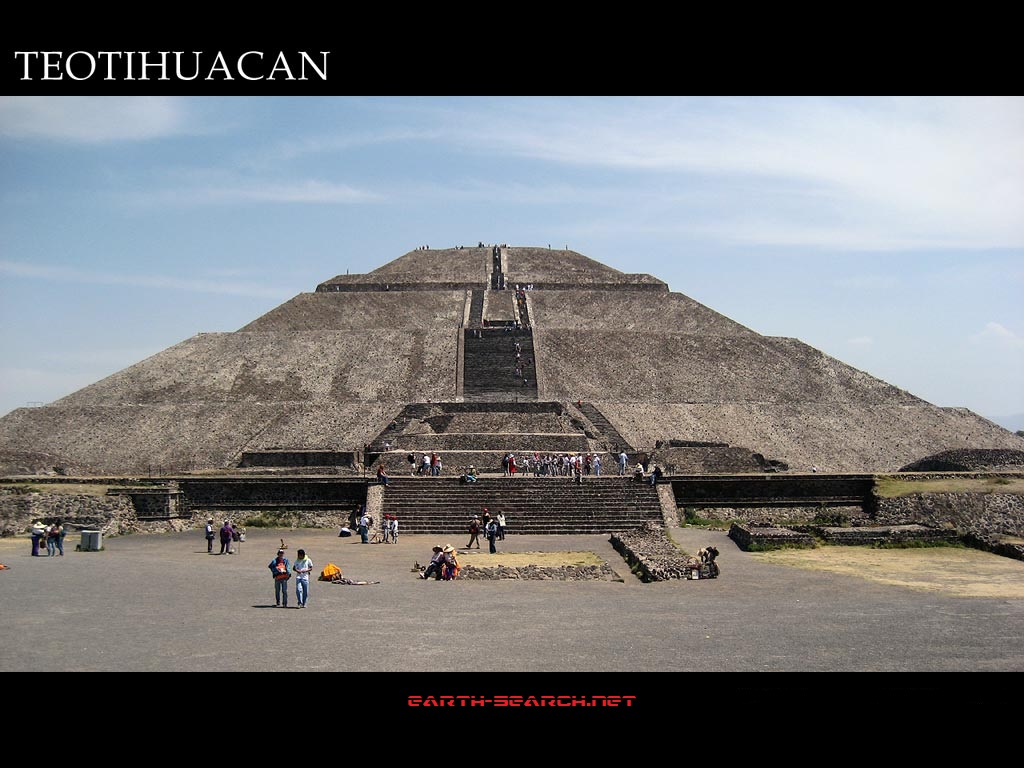
Temple of Quetzalcoatl / Piramide de Quetzalcoatl

Temple of Quetzalcoatl, view of inner and outer pyramid (it was rebuilt 7 times)
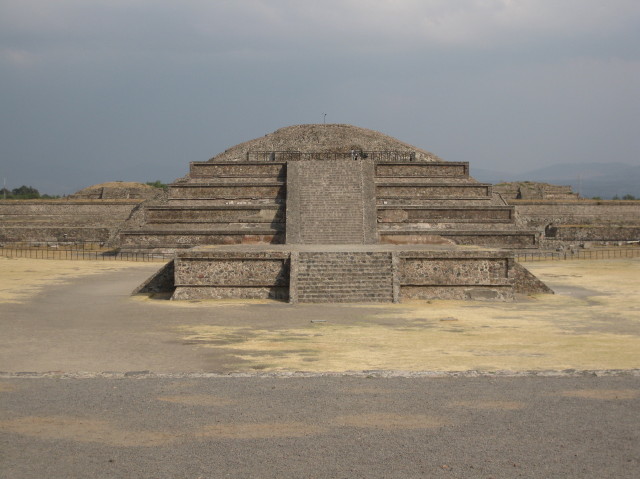
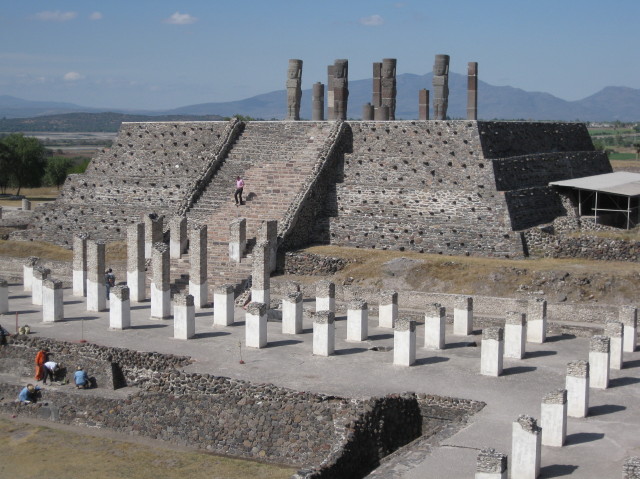
Pyramid B at Tula, also known as the Temple of Quetzalcoatl.
The four basalt warrior columns, also known as atlantes, on top of the Pyramid B at Tula.



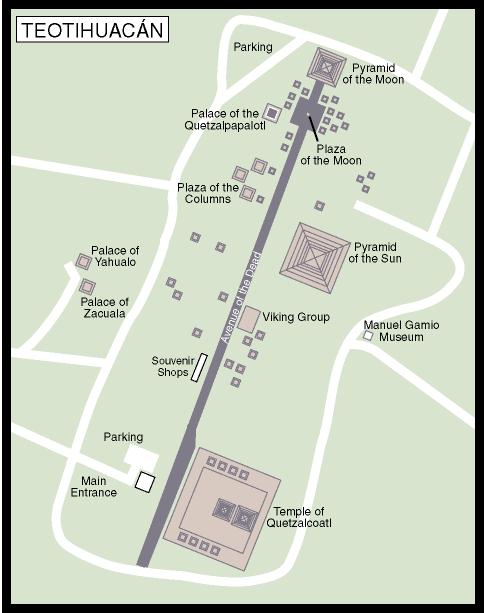
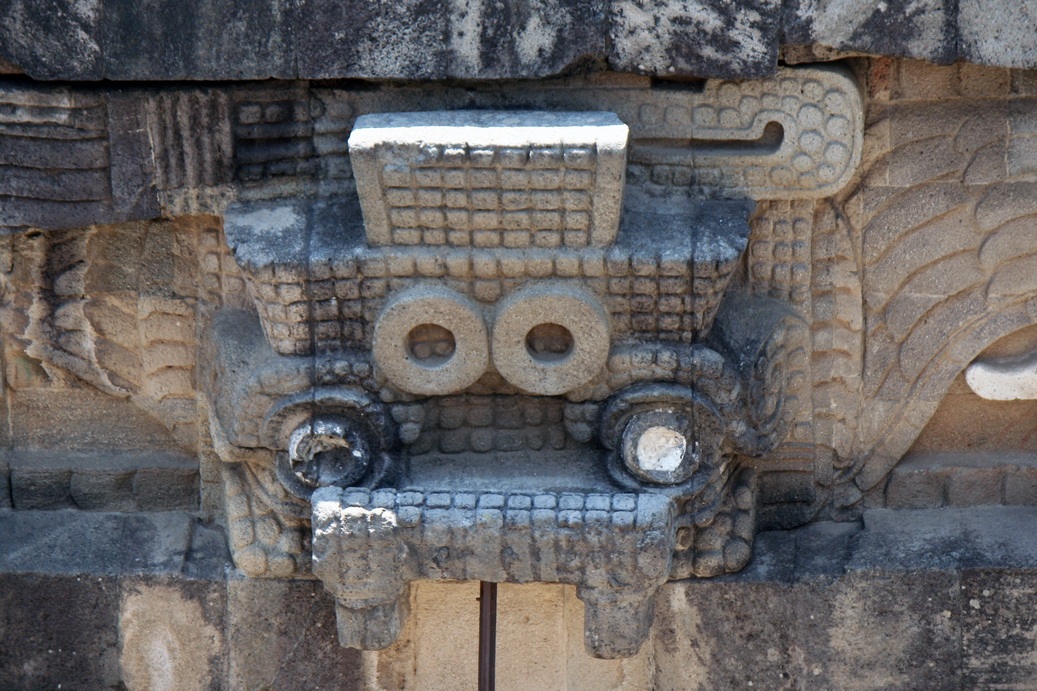

To the Aztecs, Teotihuacan was a holy place, where the sun, moon and universe were created. It was they who gave Teotihuacan its name, meaning "The place where men become gods". They also named the Calle de los Muertos, thinking (wrongly) that the many ruined temples and monuments along the "road" were burial places of early rulers. However, the city never regained its concentration of population.
In time earth and grass covered the great pyramids, until they appeared little more than large hills on the landscape. Cortés passed through the area in the 16th century and paid little attention to what structures were visible. It was not until the 19th century that proper excavation and restoration was begun.
The Citadel and Temple of Quetzalcoatl. The main entrance and visitors’ center is directly opposite the La Ciudadela (The Citadel). This large sunken plaza was the city’s administrative center; you’ll see the foundations of several rooms and buildings around the perimeter. Its name was given by the Spanish, who mistook the perimeter platform and pyramid remains for a fortress and towers.
At the eastern end of the plaza, furthest from the visitors’ center, is the Temple of Quetzalcoatl. On approach you will see a four tier pyramid, with steep steps up the nearest side. This construction completely covered a previous pyramid and temple, but excavations on the eastern side have revealed a section of this original building. To see this, walk around the railed platform.
The exposed four-tier (originally six) pyramid has protruding sculptures of serpents alternating with masks of Tlaloc, god of rain and maize. The serpents have plumes or feathers around their necks (Quetzalcoatl being the ‘plumed serpent’) and their bodies curve from the left of the head, ending in a rattle. The Tlaloc masks have corn-cob faces, with big circular eyes and two fangs. Carvings of shells and snails around the masks are earth and water symbols. Originally these would all have been painted in bright colors; green plumes and obsidian eyes for the serpent, white fangs and red jaws for Tlaloc. Some traces of paint can still be seen.
In time earth and grass covered the great pyramids, until they appeared little more than large hills on the landscape. Cortés passed through the area in the 16th century and paid little attention to what structures were visible. It was not until the 19th century that proper excavation and restoration was begun.
The Citadel and Temple of Quetzalcoatl. The main entrance and visitors’ center is directly opposite the La Ciudadela (The Citadel). This large sunken plaza was the city’s administrative center; you’ll see the foundations of several rooms and buildings around the perimeter. Its name was given by the Spanish, who mistook the perimeter platform and pyramid remains for a fortress and towers.
At the eastern end of the plaza, furthest from the visitors’ center, is the Temple of Quetzalcoatl. On approach you will see a four tier pyramid, with steep steps up the nearest side. This construction completely covered a previous pyramid and temple, but excavations on the eastern side have revealed a section of this original building. To see this, walk around the railed platform.
The exposed four-tier (originally six) pyramid has protruding sculptures of serpents alternating with masks of Tlaloc, god of rain and maize. The serpents have plumes or feathers around their necks (Quetzalcoatl being the ‘plumed serpent’) and their bodies curve from the left of the head, ending in a rattle. The Tlaloc masks have corn-cob faces, with big circular eyes and two fangs. Carvings of shells and snails around the masks are earth and water symbols. Originally these would all have been painted in bright colors; green plumes and obsidian eyes for the serpent, white fangs and red jaws for Tlaloc. Some traces of paint can still be seen.
Teotihuacán’s greatest art forms were architecture and mural paintings. Facades of pyramids and interiors of palaces, temples, and homes were frequently decorated with splendid frescoes. The fragment shown here was part of a cycle painted on the interior walls of an aristocratic palace. It shows a rain priest walking or dancing in profile and wearing an elaborate headdress and costume. His speech-scroll, adorned with seashells and plants, indicates that he is praying for water and agricultural prosperity, which were highly valued in his society.
The ancient city of Teotihuacan is the most visited of Mexico’s archaeological sites and a must-see if you’re in Mexico City. The site is impressive for its scale, both in the size of the Pyramid of the Sun (the third largest pyramid in the world) and the majesty of the Calle de los Muertos (Street of the Dead) – originally 4km long and flanked by temples, palaces and platforms Look for amazingly well preserved murals in the Palace of the Jaguars or the Palace of the Quetzal-butterfly and bold sculptures in the Temple of Quetzalcoatl.Teotihuacan ( which acually means “place of those who have the road of the gods”) was, at its height in the first half of the 1st millennium CE (Common Era), the largest city in the Americas. The name Teotihuacan is also used to refer to the civilization that this city was the center of, which at its greatest extent included much of central Mexico. Its influence spread throughout Mesoamerica; evidence of Teotihuacano presence, if not outright political and economic control, can be seen at numerous sites in Veracruz and the Maya region.
Teotihuacan was a large settlement by 150BC, its importance probably arising from a cave system with religious significance, located underneath the present day Pyramid of the Sun. As other settlements in the area diminished, Teotihuacan flourished and became a religious and economic center, controlling the region’s production of obsidian (the black stone used to make weapons and utensils).
Between 1AD and 250AD the ceremonial core was completed, including the Pyramids of the Sun and Moon and the Calle de los Muertos. The massive pyramid structures were painted red and must have been an awe-inspiring sight. Trading relationships were established with Monte Alban in Oaxaca and the gulf coast – there is little evidence of any hostility during the years of prosperity. (You will not see any depictions of warfare or human sacrifice in the carvings and murals at Teotihuacan, unlike many contemporary cities in Mexico).
Major expansion in population and housing occurred between 250-450AD. As many as 200,000 inhabitants have been estimated and at least 2000 “houses” counted. Most of these buildings were home to large family groups or artisan communes. There were even delegations from other cities – a group of craftsmen from Monte Alban is known to have shared a workshop here. The prosperity continued to 650AD and around this time it was the sixth largest city in the world.
In 400AD, with around 200,000 inhabitants Teotihuacan was the sixth largest city in the world – 300 years later it was found virtually abandoned
However, in 650AD, a great fire swept through the city, devastating many communities. For some unknown reason a swift decline ensued and there was no massive reconstruction exercise. Several theories prevail – invasion from a rival city taking advantage of temporary weakness, or a culmination of the erosion of natural resources by over-exploitation.
Whatever the cause, the population soon moved to other growing cities and Teotihuacan was virtually deserted. By the time the Aztecs arrived on the scene, the area was little more than an ancient ruin.
To the Aztecs, Teotihuacan was a holy place, where the sun, moon and universe were created. It was they who gave Teotihuacan its name, meaning “The place where men become gods”. They also named the Calle de los Muertos, thinking (wrongly) that the many ruined temples and monuments along the “road” were burial places of early rulers. However, the city never regained its concentration of population.
The ancient city of Teotihuacan is the most visited of Mexico’s archaeological sites and a must-see if you’re in Mexico City. The site is impressive for its scale, both in the size of the Pyramid of the Sun (the third largest pyramid in the world) and the majesty of the Calle de los Muertos (Street of the Dead) – originally 4km long and flanked by temples, palaces and platforms Look for amazingly well preserved murals in the Palace of the Jaguars or the Palace of the Quetzal-butterfly and bold sculptures in the Temple of Quetzalcoatl.Teotihuacan ( which acually means “place of those who have the road of the gods”) was, at its height in the first half of the 1st millennium CE (Common Era), the largest city in the Americas. The name Teotihuacan is also used to refer to the civilization that this city was the center of, which at its greatest extent included much of central Mexico. Its influence spread throughout Mesoamerica; evidence of Teotihuacano presence, if not outright political and economic control, can be seen at numerous sites in Veracruz and the Maya region.
Teotihuacan was a large settlement by 150BC, its importance probably arising from a cave system with religious significance, located underneath the present day Pyramid of the Sun. As other settlements in the area diminished, Teotihuacan flourished and became a religious and economic center, controlling the region’s production of obsidian (the black stone used to make weapons and utensils).
Between 1AD and 250AD the ceremonial core was completed, including the Pyramids of the Sun and Moon and the Calle de los Muertos. The massive pyramid structures were painted red and must have been an awe-inspiring sight. Trading relationships were established with Monte Alban in Oaxaca and the gulf coast – there is little evidence of any hostility during the years of prosperity. (You will not see any depictions of warfare or human sacrifice in the carvings and murals at Teotihuacan, unlike many contemporary cities in Mexico).
Major expansion in population and housing occurred between 250-450AD. As many as 200,000 inhabitants have been estimated and at least 2000 “houses” counted. Most of these buildings were home to large family groups or artisan communes. There were even delegations from other cities – a group of craftsmen from Monte Alban is known to have shared a workshop here. The prosperity continued to 650AD and around this time it was the sixth largest city in the world.
In 400AD, with around 200,000 inhabitants Teotihuacan was the sixth largest city in the world – 300 years later it was found virtually abandoned
However, in 650AD, a great fire swept through the city, devastating many communities. For some unknown reason a swift decline ensued and there was no massive reconstruction exercise. Several theories prevail – invasion from a rival city taking advantage of temporary weakness, or a culmination of the erosion of natural resources by over-exploitation.
Whatever the cause, the population soon moved to other growing cities and Teotihuacan was virtually deserted. By the time the Aztecs arrived on the scene, the area was little more than an ancient ruin.
To the Aztecs, Teotihuacan was a holy place, where the sun, moon and universe were created. It was they who gave Teotihuacan its name, meaning “The place where men become gods”. They also named the Calle de los Muertos, thinking (wrongly) that the many ruined temples and monuments along the “road” were burial places of early rulers. However, the city never regained its concentration of population.

Mural from the Tepantitla compound showing what has been identified as an aspect of the Great Goddess of Teotihuacan, from a reproduction in the National Museum of Anthropology in Mexico City.
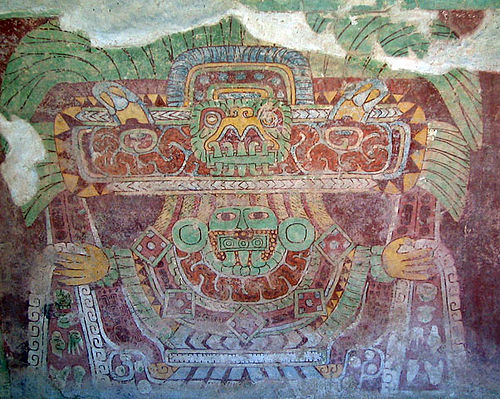
Actual mural from the Tetitla compound showing a similar portrait.
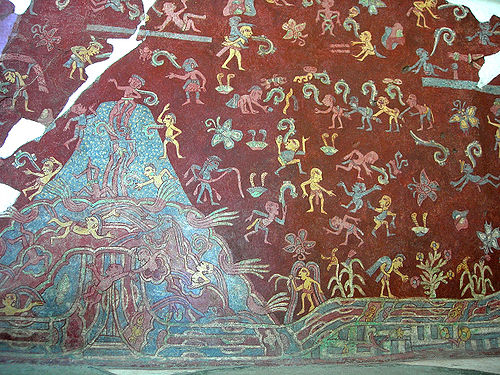
A portion of the actual mural from the Tepantitla compound which appears under the Great Goddess portrait. There are many interpretations of this scene.
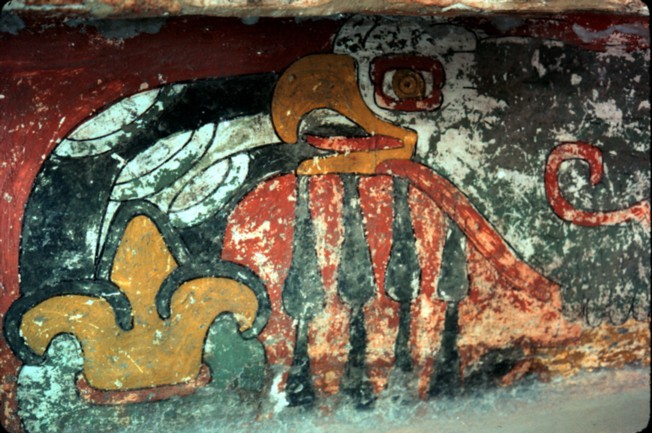
Teotihuacán Eagle Mural
In time earth and grass covered the great pyramids, until they appeared little more than large hills on the landscape. CortÃs passed through the area in the 16th century and paid little attention to what structures were visible. It was not until the 19th century that proper excavation and restoration was begun.
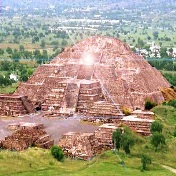
City Layout
The Citadel and Temple of Quetzalcoatl
The main entrance and visitors’ center is directly opposite the La Ciudadela (The Citadel). This large sunken plaza was the city’s administrative center; you’ll see the foundations of several rooms and buildings around the perimeter. Its name was given by the Spanish, who mistook the perimeter platform and pyramid remains for a fortress and towers.
At the eastern end of the plaza, furthest from the visitors’ center, is the Temple of Quetzalcoatl. On approach you will see a four tier pyramid, with steep steps up the nearest side. This construction completely covered a previous pyramid and temple, but excavations on the eastern side have revealed a section of this original building. To see this, walk around the railed platform.
The exposed four-tier (originally six) pyramid has protruding sculptures of serpents alternating with masks of Tláloc, god of rain and maize. The serpents have plumes or feathers around their necks (Quetzalcóatl being the ‘plumed serpent’) and their bodies curve from the left of the head, ending in a rattle. The Tláloc masks have corn-cob faces, with big circular eyes and two fangs. Carvings of shells and snails around the masks are earth and water symbols. Originally these would all have been painted in bright colors; green plumes and obsidian eyes for the serpent, white fangs and red jaws for Tláloc. Some traces of paint can still be seen.
Calle de los Muertos
Leaving the citadel, walk up the Calle de los Muertos towards the Pyramid of the Moon. On the left you’ll pass the “Edificios Superpuestos” (superimposed buildings) where excavations have unearthed living quarters below the present level, filled in with rubble in order to build the second stage.
Pyramid of the Sun
Early reconstruction work by Leopoldo Batres in the early 20th century has unfortunately removed evidence of the true appearance of the pyramid, including its original height. It is now around 215 feet (65 m) high with five tiers, though the fourth and fifth tier were divided by Batres and there were probably only four original, roughly even tiers. Directly under the Pyramid of the Sun is a tunnel which leads to caves used for religious ceremonies
Climb the steps to the top of the pyramid; most of the tiers have small steps that are relatively easier on the legs than those of the Pyramid of the Moon. At the top there would almost certainly have been a temple, of which no trace remains. The view, however, is tremendous and well worth the climb.
Directly under the pyramid is the cave system that is believed to have determined its location. An man-made entrance was discovered in 1971 at the perimeter of the pyramid, with steep stone steps cut into the walls of a shaft 23 feet (7m) deep. From the bottom, a tunnel leads to the natural caves, extended to form four rooms. Here various artifacts were found which indicate early use, probably for religious purposes (caves and water sources, which this was likely to be, were seen as holy places)
The Citadel and Temple of Quetzalcoatl
The main entrance and visitors’ center is directly opposite the La Ciudadela (The Citadel). This large sunken plaza was the city’s administrative center; you’ll see the foundations of several rooms and buildings around the perimeter. Its name was given by the Spanish, who mistook the perimeter platform and pyramid remains for a fortress and towers.
At the eastern end of the plaza, furthest from the visitors’ center, is the Temple of Quetzalcoatl. On approach you will see a four tier pyramid, with steep steps up the nearest side. This construction completely covered a previous pyramid and temple, but excavations on the eastern side have revealed a section of this original building. To see this, walk around the railed platform.
The exposed four-tier (originally six) pyramid has protruding sculptures of serpents alternating with masks of Tláloc, god of rain and maize. The serpents have plumes or feathers around their necks (Quetzalcóatl being the ‘plumed serpent’) and their bodies curve from the left of the head, ending in a rattle. The Tláloc masks have corn-cob faces, with big circular eyes and two fangs. Carvings of shells and snails around the masks are earth and water symbols. Originally these would all have been painted in bright colors; green plumes and obsidian eyes for the serpent, white fangs and red jaws for Tláloc. Some traces of paint can still be seen.
Calle de los Muertos
Leaving the citadel, walk up the Calle de los Muertos towards the Pyramid of the Moon. On the left you’ll pass the “Edificios Superpuestos” (superimposed buildings) where excavations have unearthed living quarters below the present level, filled in with rubble in order to build the second stage.
Pyramid of the Sun
Early reconstruction work by Leopoldo Batres in the early 20th century has unfortunately removed evidence of the true appearance of the pyramid, including its original height. It is now around 215 feet (65 m) high with five tiers, though the fourth and fifth tier were divided by Batres and there were probably only four original, roughly even tiers. Directly under the Pyramid of the Sun is a tunnel which leads to caves used for religious ceremonies
Climb the steps to the top of the pyramid; most of the tiers have small steps that are relatively easier on the legs than those of the Pyramid of the Moon. At the top there would almost certainly have been a temple, of which no trace remains. The view, however, is tremendous and well worth the climb.
Directly under the pyramid is the cave system that is believed to have determined its location. An man-made entrance was discovered in 1971 at the perimeter of the pyramid, with steep stone steps cut into the walls of a shaft 23 feet (7m) deep. From the bottom, a tunnel leads to the natural caves, extended to form four rooms. Here various artifacts were found which indicate early use, probably for religious purposes (caves and water sources, which this was likely to be, were seen as holy places)
Palaces of the Jaguar and Quetzal-butterfly
Approaching the Pyramid of the Moon from the Sun, a grand plaza opens up at the base of the pyramid. Several platforms and smaller pyramids surround the plaza, each pyramid with a central staircase originally leading to a temple.
On the left hand side are the remains of palaces, some with murals and carvings still visible. The Palace of the Jaguar has murals of jaguars with feathered headdresses, whilst in the Palace of the Quetzal-butterfly are carved pillars depicting a hybrid bird-butterfly. The eyes of these creatures were set with obsidian and some still pieces are still intact.
These palaces were elaborately decorated and are assumed to have been the homes of high priests. Other murals can be seen in residential areas outside of the main complex; at Tepantitla behind the Palace of the Sun and also at Tetila and Atetelco, west of the main site.
Teotihaucan Travel Tips
Wear comfortable shoes because Teotihuacan is vast. Even exploring just the highlights requires substantial walking.
Another physical exertion: The high altitude can make step climbing fatiguing.
Summer middays can be sweltering, so come early or late to avoid the heat (and crowds).
Early is preferable to late because thunderstorms occur more frequently in the afternoon.
In the wintertime, the temperature can become nippy and a bit raw.
Teotihuacan is best photographed in the early morning and late afternoon light (for contrasting shadows).
The population estimates of Teotihuacan in its glory days generally range between 75,000 to 200,000. Those figures would make it one of the world’s largest cities in its time.
After its prime time (from around 200 BC to 350 AD), Teotihuacan slowly deteriorated physically and in spirit over the next several centuries, then died.
The Teotihuacan moniker was coined by the invading Aztecs, relative newbies. They did not take possession of the complex until a relatively short time before Cortez invaded Mexico in the 16th century. That was nearly a millennium after the original builders abandoned their religious and commercial center.
The Aztecs used the top of the Pyramid of the Sun as an altar for sacrificing captives of war to the solar god. The hapless souls were marched huffing and puffing up the 247 steep steps to have their hearts ceremoniously ripped out by a priest and their heartless bodies unceremoniously tossed down the sheer sides of the Pyramid of the Sun.
The Avenue of the Dead was the main street of Teotihuacan. It ran for more than 2.5 km, beginning at the Moon Plaza to the north and extending beyond the Ciudadela and the Great Compound complexes to the south.
The avenue divided the city into two sections. Apartment compounds with pyramidal constructions were arranged on both sides of the avenue, often symetrically and sharing the same orientation. This highly planned city-layout suggests that the avenue may have been planned since its earliest phases of urbanization.
As originally built, the Sun Pyramid was approximately 215 by 215 m at the base, and about 63 m high. It was significantly enlarged at least twice in later periods, resulting in a final size of 225 m along each side. The pyramid was located on the east side of the Avenue of the Dead in the northern half of the city. If the area of monumental construction between the Moon Pyramid and the San Juan Canal is regarded as the central zone of the city, the Sun Pyramid is located at its middle. In addition to its geographic centrality, the importance of the pyramid is indicated by a cave located under the structure. It is believed by certain scholars that the cave was used for ritual activities, and why the pyramid was constructed where it is today.
The Ciudadela is a huge enclosure located at the geographic center of the city. It measures about 400 m on a side (i.e. about 160,000 m2), and the interior space is surrounded by four large platforms surmounted by pyramids. The main plaza had a capacity of about 100,000 persons without much crowding. One of the main functions of this closed huge space may have been ritual performance.
(Information from the University of Arizona)
Approaching the Pyramid of the Moon from the Sun, a grand plaza opens up at the base of the pyramid. Several platforms and smaller pyramids surround the plaza, each pyramid with a central staircase originally leading to a temple.
On the left hand side are the remains of palaces, some with murals and carvings still visible. The Palace of the Jaguar has murals of jaguars with feathered headdresses, whilst in the Palace of the Quetzal-butterfly are carved pillars depicting a hybrid bird-butterfly. The eyes of these creatures were set with obsidian and some still pieces are still intact.
These palaces were elaborately decorated and are assumed to have been the homes of high priests. Other murals can be seen in residential areas outside of the main complex; at Tepantitla behind the Palace of the Sun and also at Tetila and Atetelco, west of the main site.
Teotihaucan Travel Tips
Wear comfortable shoes because Teotihuacan is vast. Even exploring just the highlights requires substantial walking.
Another physical exertion: The high altitude can make step climbing fatiguing.
Summer middays can be sweltering, so come early or late to avoid the heat (and crowds).
Early is preferable to late because thunderstorms occur more frequently in the afternoon.
In the wintertime, the temperature can become nippy and a bit raw.
Teotihuacan is best photographed in the early morning and late afternoon light (for contrasting shadows).
The population estimates of Teotihuacan in its glory days generally range between 75,000 to 200,000. Those figures would make it one of the world’s largest cities in its time.
After its prime time (from around 200 BC to 350 AD), Teotihuacan slowly deteriorated physically and in spirit over the next several centuries, then died.
The Teotihuacan moniker was coined by the invading Aztecs, relative newbies. They did not take possession of the complex until a relatively short time before Cortez invaded Mexico in the 16th century. That was nearly a millennium after the original builders abandoned their religious and commercial center.
The Aztecs used the top of the Pyramid of the Sun as an altar for sacrificing captives of war to the solar god. The hapless souls were marched huffing and puffing up the 247 steep steps to have their hearts ceremoniously ripped out by a priest and their heartless bodies unceremoniously tossed down the sheer sides of the Pyramid of the Sun.
The Avenue of the Dead was the main street of Teotihuacan. It ran for more than 2.5 km, beginning at the Moon Plaza to the north and extending beyond the Ciudadela and the Great Compound complexes to the south.
The avenue divided the city into two sections. Apartment compounds with pyramidal constructions were arranged on both sides of the avenue, often symetrically and sharing the same orientation. This highly planned city-layout suggests that the avenue may have been planned since its earliest phases of urbanization.
As originally built, the Sun Pyramid was approximately 215 by 215 m at the base, and about 63 m high. It was significantly enlarged at least twice in later periods, resulting in a final size of 225 m along each side. The pyramid was located on the east side of the Avenue of the Dead in the northern half of the city. If the area of monumental construction between the Moon Pyramid and the San Juan Canal is regarded as the central zone of the city, the Sun Pyramid is located at its middle. In addition to its geographic centrality, the importance of the pyramid is indicated by a cave located under the structure. It is believed by certain scholars that the cave was used for ritual activities, and why the pyramid was constructed where it is today.
The Ciudadela is a huge enclosure located at the geographic center of the city. It measures about 400 m on a side (i.e. about 160,000 m2), and the interior space is surrounded by four large platforms surmounted by pyramids. The main plaza had a capacity of about 100,000 persons without much crowding. One of the main functions of this closed huge space may have been ritual performance.
(Information from the University of Arizona)
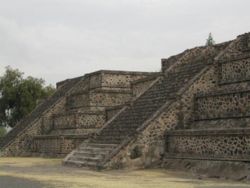
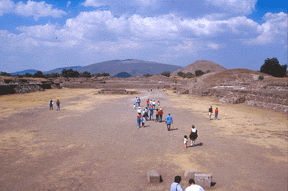
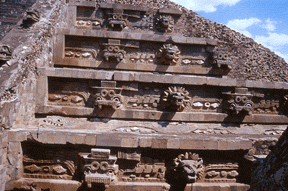
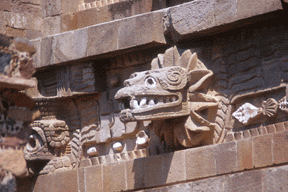
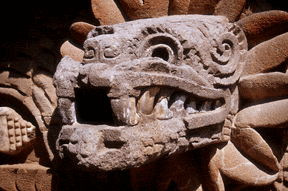
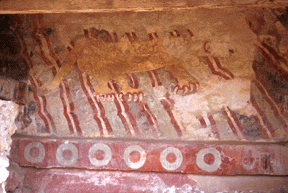

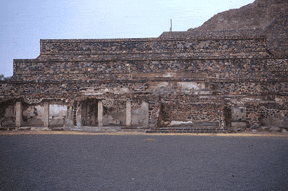
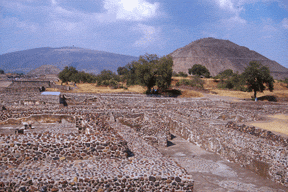
Approaching the major temple sites
The Temple of the Feathered Serpent has a facade with a series of repeating images
Feaethered serpents are the most prominent images on the facade
In some cases, one can still see the remnants of the white paint that was used to emphasize the teeth
In one of the rooms beside the Luna temple is a preserved mural of a jaguar
In addition to the feathered serpent, the reliefs depict marine snails and an apple snail from fresh water
This is the location of the central living areas where about 100,000 people lived.
On top of the rooms, there are courtyards that may be upper story rooms.
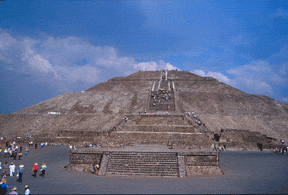
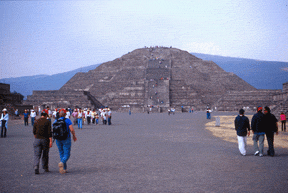
The largest of the temples is dedicated to the sun and called Sol.
The smaller of the two temples is dedicated to the moon and is called Luna.
On this temple, the stairs are very steep and at frequent intervals there are facades possibly originally with murals.

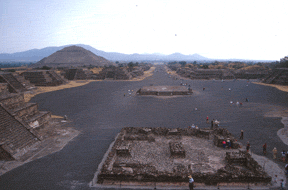
From the top of Luna, one can see the full extent of the plaza and the view of Sol in the distance.
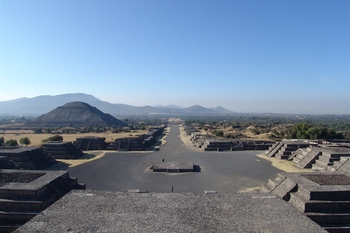
Teotihuacán,
View of the Avenue of the Dead (center) and Pyramid of the Sun (left)
from the Temple of the Moon, Teotihuacán.
from the Temple of the Moon, Teotihuacán.
Teotihuacán ("teh-oh-tee-wa-KHAN") is an ancient sacred site located 30 miles northeast of Mexico City, Mexico. It is a very popular side trip from Mexico City, and for good reason. The ruins of Teotihuacán are among the most remarkable in Mexico and some of the most important ruins in the world.
Teotihuacán means "place where gods were born," reflecting the Aztec belief that the gods created the universe here. Constructed around 300 AD, the holy city is characterized by the vast size of its monuments, carefully laid out on geometric and symbolic principles. Its most monumental structures are the Temple of Quetzalcoatl, the Pyramid of the Sun (the third-largest pyramid in the world) and the Pyramid of the Moon.
Teotihuacán means "place where gods were born," reflecting the Aztec belief that the gods created the universe here. Constructed around 300 AD, the holy city is characterized by the vast size of its monuments, carefully laid out on geometric and symbolic principles. Its most monumental structures are the Temple of Quetzalcoatl, the Pyramid of the Sun (the third-largest pyramid in the world) and the Pyramid of the Moon.
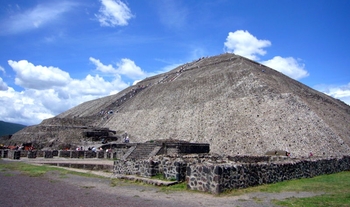
The early history of Teotihuacán is shrouded in mystery. Little is known about its ancient builders, including their name, precise religious beliefs, or language. The city became the epicenter of culture and commerce for ancient Mesoamerica, surpassing Rome in size, yet its inhabitants suddenly abandoned it for unknown reasons.
People first moved to the area around 500 BC. Sometime after 100 BC, construction of the enormous Pyramid of the Sun commenced. Teotihuacán's rise thus coincided with that of classical Rome, and with the beginning of cultures in Mexico's Yucatán Peninsula, Oaxaca, and Puebla.
At its zenith around 500 AD, Teotihuacán's magnificent pyramids and palaces covered 12 square miles (31 sq km) and the city was larger in size and population than Rome. Through trade and other contact, Teotihuacán's influence was felt as far south as the Yucatán and Guatemala.
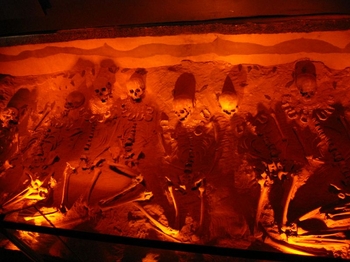

Teotihuacános were formidable warriors and that their aim in warfare was not conquest of territory but the capture of prisoners who were sacrificed to avert the end of the world.
According to the mythology shared by most ancient peoples of Central America, the world had undergone four cycles or "suns." They lived in the fifth sun, which was already old. Thus they expected the end of the world at any moment, which was expected to happen by earthquakes.
In an effort to postpone this cataclysmic event, humans were sacrificed by the thousands. Humans also seem to have been sacrificed to dedicate a new or expanded building. In the Pyramid of the Sun, the corner of each step contained skeletons of children. Discovered below the Temple of Quetzalcoatl were three burial pits full of skeletons.
According to the mythology shared by most ancient peoples of Central America, the world had undergone four cycles or "suns." They lived in the fifth sun, which was already old. Thus they expected the end of the world at any moment, which was expected to happen by earthquakes.
In an effort to postpone this cataclysmic event, humans were sacrificed by the thousands. Humans also seem to have been sacrificed to dedicate a new or expanded building. In the Pyramid of the Sun, the corner of each step contained skeletons of children. Discovered below the Temple of Quetzalcoatl were three burial pits full of skeletons.
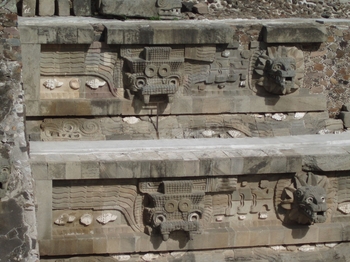
Pyramid of the Feathered Serpent withgods Tlaloc and Quetzalcoatl.
It appears that the primary deity at Teotihuacán was a female, called the "Spider Woman" by scholars. There are also depictions of other female deities, including a Water Goddess. According to archaeoastronomer John B. Carlson, the cult of the planet Venus that determined wars and human sacrifices elsewhere in Mesoamerica was prominent at Teotihuacán as well. Ceremonial rituals were timed with the appearance of Venus as the morning and evening star. The symbol of Venus at Teotihuacán appears as a star or half star with a full or half circle.
Other important deities at Teotihuacán included: the Rain God (called Tlaloc by the Aztecs); Quetzalcoatl, the Feathered Serpent; the Sun God and Moon Goddess; and Xipe Totec (Our Lord the Flayed One, associated with renewed vegetation). Incense burners have been found related to the Old Fire God, a creator divinity possibly associated with the Spider Woman.
For reasons that are not known for certain, the inhabitants of Teotihuacán gradually abandoned their great city around 700 AD. Scholars believe the decline was probably caused by overpopulation and depletion of natural resources.
About 50 years after its abandonment, Teotihuacán was destroyed by fire, leaving some of its greatest monuments buried under millions of tons of earth. It is possible that the city was deliberately burned by its former inhabitants, or by invaders that regarded the religion of Teotihuacán as a false one - the Toltecs have been suggested as possible culprits.
Other important deities at Teotihuacán included: the Rain God (called Tlaloc by the Aztecs); Quetzalcoatl, the Feathered Serpent; the Sun God and Moon Goddess; and Xipe Totec (Our Lord the Flayed One, associated with renewed vegetation). Incense burners have been found related to the Old Fire God, a creator divinity possibly associated with the Spider Woman.
For reasons that are not known for certain, the inhabitants of Teotihuacán gradually abandoned their great city around 700 AD. Scholars believe the decline was probably caused by overpopulation and depletion of natural resources.
About 50 years after its abandonment, Teotihuacán was destroyed by fire, leaving some of its greatest monuments buried under millions of tons of earth. It is possible that the city was deliberately burned by its former inhabitants, or by invaders that regarded the religion of Teotihuacán as a false one - the Toltecs have been suggested as possible culprits.
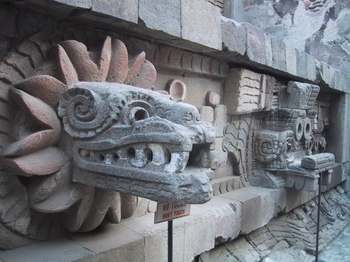
Quetzalcoatl and Tlaloc
It was the Aztecs who gave Teotihuacán its name, when they arrived here in about 1320. The name means "City of Gods," and they believed the gods had gathered here to create the sun and moon after the last world ended. Teotihuacán was highly revered by the Aztecs and used as a pilgrimage center from their base in Tenochtitlán, modern Mexico City.
Already astonished at the size and sophistication of Mexico City (Tenochtitlán), we can only imagine the reaction of Fernando Cortes and his men when they stumbled upon the great ceremonial center of Teotihuacán in 1520. Legend has it that one of the reasons the Aztecs were defeated so quickly by the outnumbered Spaniards was that they mistook him for Quetzalcoatl, who was expected to arrive from the Atlantic in the form of a bearded white man.
What to See
Today, what remains are the rough stone structures of the three pyramids and sacrificial altars, and some of the grand houses, all of which were once covered in stucco and painted with brilliant frescoes (mainly in red).
Already astonished at the size and sophistication of Mexico City (Tenochtitlán), we can only imagine the reaction of Fernando Cortes and his men when they stumbled upon the great ceremonial center of Teotihuacán in 1520. Legend has it that one of the reasons the Aztecs were defeated so quickly by the outnumbered Spaniards was that they mistook him for Quetzalcoatl, who was expected to arrive from the Atlantic in the form of a bearded white man.
What to See
Today, what remains are the rough stone structures of the three pyramids and sacrificial altars, and some of the grand houses, all of which were once covered in stucco and painted with brilliant frescoes (mainly in red).
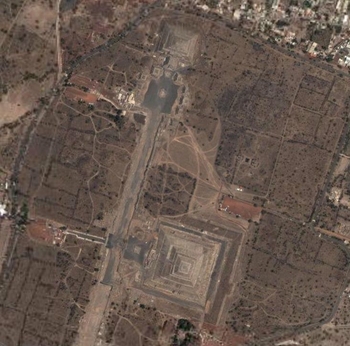
Aerial view of Teotihuacán, oriented north. The Pyramid of the Moon is
at the top; the larger Pyramid of the Sun on the bottom. See below for
an interactive view. Image © Google Earth
at the top; the larger Pyramid of the Sun on the bottom. See below for
an interactive view. Image © Google Earth
The whole city of Teotihuacán seems to be aligned astronomically. It is consistently oriented 15 to 25 degrees east of true north, and the front wall of the Pyramid of the Sun is exactly perpendicular to the point on the horizon where the sun sets on the equinoxes. The rest of the ceremonial buildings were laid out at right angles to the Pyramid of the Sun. The Avenue of the Dead points at the setting of the Pleiades. Another alignment is to the dog star Sirius, sacred to the ancient Egyptians, which has led some to suggest a link between the great pyramids of Egypt and Mexico.
The main thoroughfare, which archaeologists call the Avenue of the Dead (Calzada de los Muertos), runs two miles roughly north to south. The Pyramid of the Moon is at the northern end, and the Citadel (Ciudadela) is on the southern part. It was once thought that the Avenue ended with the Citadel, but it is now known that is actually twice the length and the city was divided into quarters.
The great street was several kilometers long in its prime, but only a kilometer or two has been uncovered and restored. The Avenue of the Dead got its forbidding name from the Aztecs, who wrongly believed the little temples on either side of the avenue were tombs.
The main thoroughfare, which archaeologists call the Avenue of the Dead (Calzada de los Muertos), runs two miles roughly north to south. The Pyramid of the Moon is at the northern end, and the Citadel (Ciudadela) is on the southern part. It was once thought that the Avenue ended with the Citadel, but it is now known that is actually twice the length and the city was divided into quarters.
The great street was several kilometers long in its prime, but only a kilometer or two has been uncovered and restored. The Avenue of the Dead got its forbidding name from the Aztecs, who wrongly believed the little temples on either side of the avenue were tombs.
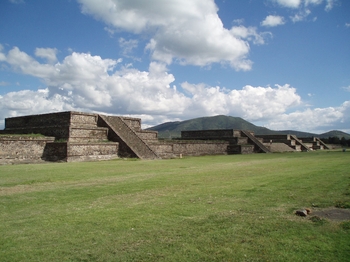
Temples line the Avenue of the Dead
As you stroll north along the Avenue toward the Pyramid of the Moon, look on the right for a bit of wall sheltered by a modern corrugated roof. Beneath the shelter, the wall still bears a painting of a jaguar. Imagine the breathtaking spectacle the Avenue must have been when all the paintings were intact!
The Spaniards named the Ciudadela, or Citadel, at the southern end of the Avenue of the Dead. This immense sunken square was not a fortress at all, despite its impressive walls. Rather, it was the grand setting for the Feathered Serpent Pyramid and the Temple of Quetzalcoatl. The feathered serpent is featured in the Ciudadela, but whether it was worshipped as Quetzalcoatl or a similar god isn't known for certain.
The Temple of Quetzalcoatl is not nearly as large as the Pyramids of the Sun and Moon, but instead it enjoys a central location, lavish offerings and fine decoration. The facade of the temple features fine, large carved serpents' heads jutting out from collars of feathers carved in the stone walls; these weigh 4 tons. Other feathered serpents are carved in relief low on the walls.
The Spaniards named the Ciudadela, or Citadel, at the southern end of the Avenue of the Dead. This immense sunken square was not a fortress at all, despite its impressive walls. Rather, it was the grand setting for the Feathered Serpent Pyramid and the Temple of Quetzalcoatl. The feathered serpent is featured in the Ciudadela, but whether it was worshipped as Quetzalcoatl or a similar god isn't known for certain.
The Temple of Quetzalcoatl is not nearly as large as the Pyramids of the Sun and Moon, but instead it enjoys a central location, lavish offerings and fine decoration. The facade of the temple features fine, large carved serpents' heads jutting out from collars of feathers carved in the stone walls; these weigh 4 tons. Other feathered serpents are carved in relief low on the walls.

The Temple of Quetzalcoatl is topped with a pyramid, known as the Feathered Serpent Pyramid. Archaeologists have tunneled deep inside the Feathered Serpent Pyramid and found more than 200 ceremonially buried skeletons of warriors, interred with precise detail and position. In addition, a single slain captive was placed at each of the pyramid's four corners.
The Pyramid of the Sun, on the east side of the Avenue of the Dead, is the third-largest pyramid in the world (surpassed only by the Great Pyramid of Cholula and the Great Pyramid of Cheops in Egypt). It is the biggest restored pyramid in the Western Hemisphere and an awesome sight.
The purpose of the Pyramid of the Sun is not entirely understood, but it is built on top of a sacred cave shaped like a four-leafed clover. Given the grand pyramid above, this cave was probably regarded as the very place where the gods created the world. The cave is not open to the public.
The Pyramid of the Sun, on the east side of the Avenue of the Dead, is the third-largest pyramid in the world (surpassed only by the Great Pyramid of Cholula and the Great Pyramid of Cheops in Egypt). It is the biggest restored pyramid in the Western Hemisphere and an awesome sight.
The purpose of the Pyramid of the Sun is not entirely understood, but it is built on top of a sacred cave shaped like a four-leafed clover. Given the grand pyramid above, this cave was probably regarded as the very place where the gods created the world. The cave is not open to the public.
Jaguar mural, Avenue of the Dead.

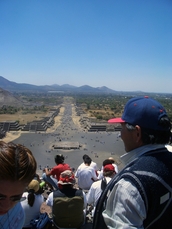
Pyramid of the Feathered Serpent (Alexandre Bourdeu); crowds atop
the Pyramid of the Sun (Murat Arslanoglu
the Pyramid of the Sun (Murat Arslanoglu
The first part of the Pyramid of the Sun was probably built around 100 BC, and the temple that used to crown the pyramid was completed about 400 years later (300 AD). By the time the pyramid was discovered and restoration was begun in the 20th century, the temple had disappeared, and the pyramid was just a mass of rubble covered with bushes and trees. It's a worthwhile 248-step climb to the top. The view is extraordinary and the sensation exhilarating.
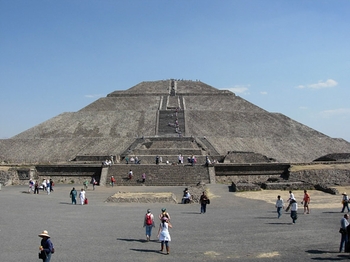
The on-site Museo Teotihuacán is a good place to start a visit. This state-of-the-art museum features interactive exhibits and a glass floor on which visitors walk above models of the pyramids. On display are findings of recent digs, including several tombs, with skeletons wearing necklaces of human and simulated jawbones, and newly-discovered sculptures.
Keep in mind that Teotihuacán is located at an altitude of more than 7,000 feet (2,121m). Take it slow, bring sunblock and water, and be prepared for almost daily afternoon showers in the summer.
Vendors at the site sell drinks and snacks, but many visitors choose to bring a picnic lunch, which almost any hotel or restaurant in the city will prepare. There is also a restaurant in the Museo Teotihuacán.
Keep in mind that Teotihuacán is located at an altitude of more than 7,000 feet (2,121m). Take it slow, bring sunblock and water, and be prepared for almost daily afternoon showers in the summer.
Vendors at the site sell drinks and snacks, but many visitors choose to bring a picnic lunch, which almost any hotel or restaurant in the city will prepare. There is also a restaurant in the Museo Teotihuacán.
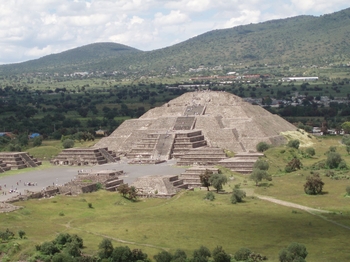
The Pyramid of the Moon from atop the Pyramid of the Sun.
Getting There
Driving to San Juan Teotihuacán on the toll Highway 85D or the free Highway 132D takes about an hour. Head north on Insurgentes to leave the city. Highway 132D passes through picturesque villages but can be slow due to the surfeit of trucks and buses. Highway 85D, the toll road, is less attractive but faster.
If you prefer to explore solo or want more or less time than an organized tour allows, consider hiring a private car and driver for the trip. They can easily be arranged through your hotel or at the Secretary of Tourism (SECTUR) information module in the Zona Rosa; they cost about $10 to $15 an hour. The higher price is generally for a sedan with an English-speaking driver who doubles as a tour guide. Rates can also be negotiated for the entire day.
Buses leave daily every half hour (5am-10pm) from the Terminal Central de Autobuses del Norte; the trip takes 1 hour. When you reach the Terminal Norte, look for the AUTOBUSES SAHAGUN sign at the far northwest end, all the way down to the sign 8 ESPERA. Be sure to ask the driver where you should wait for returning buses, how frequently buses run, and especially the time of the last bus back.
A small trolley-train that takes visitors from the entry booths to various stops within the site, including the Teotihuacán museum and cultural center, runs only on weekends and costs 60¢ per person.
Driving to San Juan Teotihuacán on the toll Highway 85D or the free Highway 132D takes about an hour. Head north on Insurgentes to leave the city. Highway 132D passes through picturesque villages but can be slow due to the surfeit of trucks and buses. Highway 85D, the toll road, is less attractive but faster.
If you prefer to explore solo or want more or less time than an organized tour allows, consider hiring a private car and driver for the trip. They can easily be arranged through your hotel or at the Secretary of Tourism (SECTUR) information module in the Zona Rosa; they cost about $10 to $15 an hour. The higher price is generally for a sedan with an English-speaking driver who doubles as a tour guide. Rates can also be negotiated for the entire day.
Buses leave daily every half hour (5am-10pm) from the Terminal Central de Autobuses del Norte; the trip takes 1 hour. When you reach the Terminal Norte, look for the AUTOBUSES SAHAGUN sign at the far northwest end, all the way down to the sign 8 ESPERA. Be sure to ask the driver where you should wait for returning buses, how frequently buses run, and especially the time of the last bus back.
A small trolley-train that takes visitors from the entry booths to various stops within the site, including the Teotihuacán museum and cultural center, runs only on weekends and costs 60¢ per person.
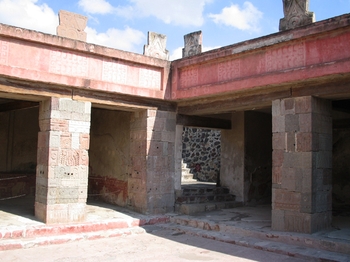
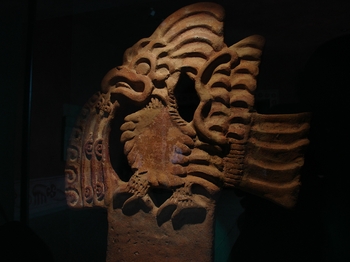
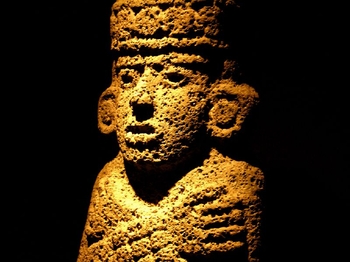
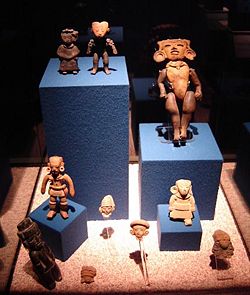
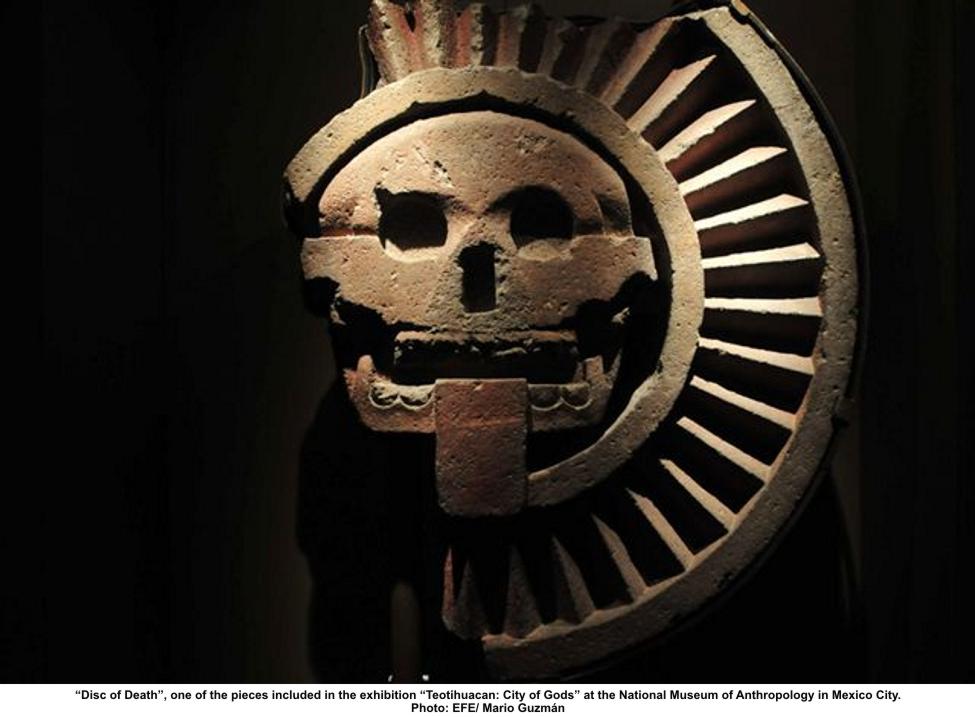
Archaeologists have discovered a 1,800 year old tunnel that leads to a system of galleries 12 meters below Teotihuacan’s Temple of Quetzalcoatl, the Feathered Serpent, in Mexico.
Spanning an area of more than 83 square kilometres , Teotihuacan is one of the largest archaeological sites in Mexico and is a UNESCO World Heritage Site . The city had nearly 250,000 inhabitants when it was at its height in the early 1st millennium AD. It also contains some of the largest pre-Columbian pyramids in the New World.
Spanning an area of more than 83 square kilometres , Teotihuacan is one of the largest archaeological sites in Mexico and is a UNESCO World Heritage Site . The city had nearly 250,000 inhabitants when it was at its height in the early 1st millennium AD. It also contains some of the largest pre-Columbian pyramids in the New World.

Archaeologists hope that the galleries they detected are actually the tombs of Teotihuacan’s rulers. “For a long time local and foreign archaeologists have attempted to locate the graves of the ancient city’s rulers, but the search has been fruitless,” said project director Sergio Chaves Gomez. “That’s why every day our expectations are increasing, as there are many chances that they are sitting inside a large tomb or offering.”
The tunnel is accessed by a vertical shaft of almost 5 by 5 metres wide and runs 14 metres deep, which gives access to a corridor nearly 100 metres long ending in a series of rock-cut galleries – which may be the tombs of Teotihuacan’s rulers.
The entrance to the underground passage – which runs under the Temple of the Feathered Serpent,the most important building of Teotihuacan’s Citadel – is located only a few metres away from the temple itself .
A small opening was made and the scanner captured the first images. Angel Mora, from the CNMH Technological Support Unit, and engineer Juan Carlos Garcia, scanner operator, mentioned that when introducing the laser only a 37-meter length was registered for the tunnel. According to Mora, this indicates that “the beam bumped into something, maybe rocks, a landside, or a change of level”.
Although the archaeologists still have two metres to dig before they reach the tunnel’s floor, the images will help them plan how to enter the tunnel. So far, about 200 tons of soil and debris have been removed from the tunnel and nearly 60,000 fragments of artifacts have been recovered.
It is not known why or when exactly the tunnel was closed. Yet, the excavation of the shaft has already offered some clues, says Gomez. He adds, “several indications suggest that access to the underground passage was closed between 200 and 250 AD, probably after depositing something inside.”
The archaeologists now know for certain that the tunnel already existed when the Citadel and the Temple of the Feathered Serpent were constructed. When the tunnel was closed, large stones were thrown in to block its access. It is thought this happened around the same date of a large structure – because of its shape – thought to be a ball court.
The tunnel is accessed by a vertical shaft of almost 5 by 5 metres wide and runs 14 metres deep, which gives access to a corridor nearly 100 metres long ending in a series of rock-cut galleries – which may be the tombs of Teotihuacan’s rulers.
The entrance to the underground passage – which runs under the Temple of the Feathered Serpent,the most important building of Teotihuacan’s Citadel – is located only a few metres away from the temple itself .
A small opening was made and the scanner captured the first images. Angel Mora, from the CNMH Technological Support Unit, and engineer Juan Carlos Garcia, scanner operator, mentioned that when introducing the laser only a 37-meter length was registered for the tunnel. According to Mora, this indicates that “the beam bumped into something, maybe rocks, a landside, or a change of level”.
Although the archaeologists still have two metres to dig before they reach the tunnel’s floor, the images will help them plan how to enter the tunnel. So far, about 200 tons of soil and debris have been removed from the tunnel and nearly 60,000 fragments of artifacts have been recovered.
It is not known why or when exactly the tunnel was closed. Yet, the excavation of the shaft has already offered some clues, says Gomez. He adds, “several indications suggest that access to the underground passage was closed between 200 and 250 AD, probably after depositing something inside.”
The archaeologists now know for certain that the tunnel already existed when the Citadel and the Temple of the Feathered Serpent were constructed. When the tunnel was closed, large stones were thrown in to block its access. It is thought this happened around the same date of a large structure – because of its shape – thought to be a ball court.
Quick Facts
Site Information
Names: Teotihuacán; City of Gods
Location: Mexico City, Mexico
Faith: Indigenous
Denomination: Original/Primary: Unknown
Current/Secondary: Aztec
Dedication: various gods including the Spider Woman, a water goddess, a rain god, and the Feathered Serpent
Categories: Temples; City Ruins ; World Heritage Sites
Date: c.100 BC-500 AD
Size: Site area: 31 sq. km (12 sq. miles)
Pyramid of the Sun: 700 ft (215 m), and 200 ft (60 m) high
Features: Astronomical Alignment
Status: ruins
Visitor Information
Coordinates: 19.690817° N, 98.846708° W (view on Google Maps)
Lodging: View hotels near this location
Phone: 59-4956-0276 or 59-4956-0052
Opening hours: Daily 7am to 5pm
Cost: Admission $4.80. Video camera fee $3.50.
Site Information
Names: Teotihuacán; City of Gods
Location: Mexico City, Mexico
Faith: Indigenous
Denomination: Original/Primary: Unknown
Current/Secondary: Aztec
Dedication: various gods including the Spider Woman, a water goddess, a rain god, and the Feathered Serpent
Categories: Temples; City Ruins ; World Heritage Sites
Date: c.100 BC-500 AD
Size: Site area: 31 sq. km (12 sq. miles)
Pyramid of the Sun: 700 ft (215 m), and 200 ft (60 m) high
Features: Astronomical Alignment
Status: ruins
Visitor Information
Coordinates: 19.690817° N, 98.846708° W (view on Google Maps)
Lodging: View hotels near this location
Phone: 59-4956-0276 or 59-4956-0052
Opening hours: Daily 7am to 5pm
Cost: Admission $4.80. Video camera fee $3.50.
Note: This information was accurate when published and we do our best to keep it updated, but details such as opening hours can change without notice. To avoid disappointment, please check with the site directly before making a special trip.
View of the Pyramid of the Sun from the Citadel
The citadel is an enormous, rectangular building complex at the south end, and on the east side of the Avenue of the Dead. It is organized around a sunken square courtyard, about 400 meters on a side, surrounded by two tiers of masonry terraces supporting two step temple platforms, 4 each on the north west and south sides for a total of 12 temples. The eastern half of the sunken courtyard is taken up by the magnificent Pyramid of Quetzalcoatl. This view is looking north from the sunken courtyard of the Citadel, to the Pyramid of the Sun, rising like a massive magical mountain, in the distance to the north.
The citadel is an enormous, rectangular building complex at the south end, and on the east side of the Avenue of the Dead. It is organized around a sunken square courtyard, about 400 meters on a side, surrounded by two tiers of masonry terraces supporting two step temple platforms, 4 each on the north west and south sides for a total of 12 temples. The eastern half of the sunken courtyard is taken up by the magnificent Pyramid of Quetzalcoatl. This view is looking north from the sunken courtyard of the Citadel, to the Pyramid of the Sun, rising like a massive magical mountain, in the distance to the north.
Stone Masks on the Pyramid of Quetzalcoatl
The Pyramid of Quetzalcoatl is a large, temple platform, almost 100 meters square, that stands in the eastern half of the sunken courtyard of the Citadel. Built in several successive phases, the interior of the mound has been excavated to reveal the west facade of the original temple, from the period of Teotihuacan in 250 AD. There are 9 stepped platforms on the west face of the pyramid, constructed with the typical sloping talud base and horizontal tablero frieze, lined with rows of alternating stone mosaic masks of Quetzalcoatl, the feathered serpent half-god, and Tlaloc, the god of rain, with his goggle eyes and protruding snout.
The Pyramid of Quetzalcoatl is a large, temple platform, almost 100 meters square, that stands in the eastern half of the sunken courtyard of the Citadel. Built in several successive phases, the interior of the mound has been excavated to reveal the west facade of the original temple, from the period of Teotihuacan in 250 AD. There are 9 stepped platforms on the west face of the pyramid, constructed with the typical sloping talud base and horizontal tablero frieze, lined with rows of alternating stone mosaic masks of Quetzalcoatl, the feathered serpent half-god, and Tlaloc, the god of rain, with his goggle eyes and protruding snout.
Funerary mask found in one of the tombs
Teotihuacan was a center for very fine ceramic manufacturing, and the city exported it's wares throughout the highlands of Mexico and Central America. There were extensive trade routes and regional centers and contacts with cultures as far away as the south-western U.S. and the great centers of culture in the Yucatan and Guatemala, and on the west coast of South America. The ceramic mask was made as a faceplate for the burial of an important personage. It has oval holes for eyes, over-sized earplugs with large, round disks, and a flared mustache over the mouth. The face is decorated with burnt orange and yellow glazes.
Teotihuacan was a center for very fine ceramic manufacturing, and the city exported it's wares throughout the highlands of Mexico and Central America. There were extensive trade routes and regional centers and contacts with cultures as far away as the south-western U.S. and the great centers of culture in the Yucatan and Guatemala, and on the west coast of South America. The ceramic mask was made as a faceplate for the burial of an important personage. It has oval holes for eyes, over-sized earplugs with large, round disks, and a flared mustache over the mouth. The face is decorated with burnt orange and yellow glazes.
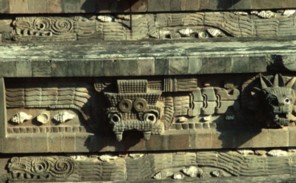
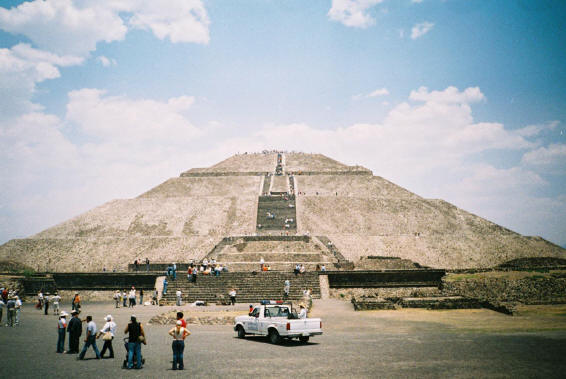

Courtyard Palace of the Quetzalpapalotl
The Palace of Quetzalpapalotl is one of many such palace structures in the center of the city. These were typically square or rectangular complexes, located on raised platforms and terraces, organized around interior courtyards and plazas. Thought to have been the royal residence of Teotihuacan, the Palace of Quetzalpapalotl, the quetzal butterfly, is located south-west of the Plaza of the Moon, on the west side of the Avenue of the Dead. It has a large, square patio, lined with columns decorated with bird and butterfly motifs.
The Palace of Quetzalpapalotl is one of many such palace structures in the center of the city. These were typically square or rectangular complexes, located on raised platforms and terraces, organized around interior courtyards and plazas. Thought to have been the royal residence of Teotihuacan, the Palace of Quetzalpapalotl, the quetzal butterfly, is located south-west of the Plaza of the Moon, on the west side of the Avenue of the Dead. It has a large, square patio, lined with columns decorated with bird and butterfly motifs.

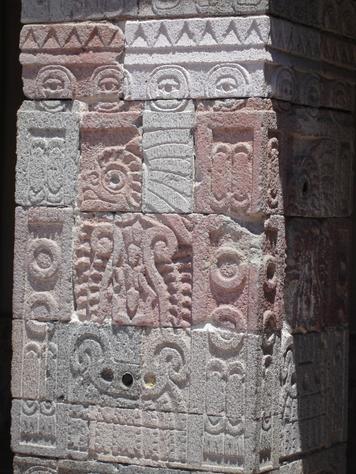
Monumental Stone Feathered Serpent Head
This is a close-up view of one of the gigantic stone feathered serpent heads from the terraces on the west facade of the original Pyramid of Quetzalcoatl from about 250 AD. The figure of the half-god Quetzalcoatl, figured prominently in the cosmological hierarchy of Teotihuacan, as it did in most other Meso-American cultures. It combines the ground and the sky with the image of the bird and the snake, in the story of a stranger from afar, who has the potential to attain divinity through his travels and tribulations.
This is a close-up view of one of the gigantic stone feathered serpent heads from the terraces on the west facade of the original Pyramid of Quetzalcoatl from about 250 AD. The figure of the half-god Quetzalcoatl, figured prominently in the cosmological hierarchy of Teotihuacan, as it did in most other Meso-American cultures. It combines the ground and the sky with the image of the bird and the snake, in the story of a stranger from afar, who has the potential to attain divinity through his travels and tribulations.




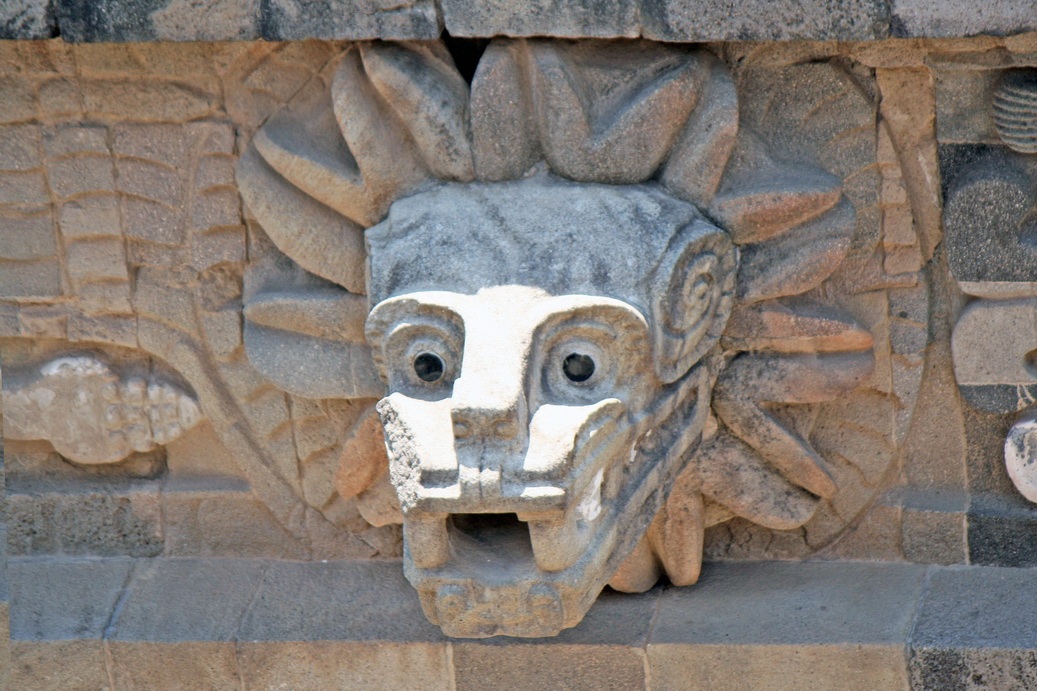
Pyramid of the Moon at Night in Laser Light
Those who stay at the site, can attend the laser sound and light shows that are conducted in the evenings, and get a chance to view the ancient structures in colored and sequenced lighting and with accompanying soundtrack and ceremonial chanting. This view shows the stepped terraces and stairways on the south side of the Pyramid of the Moon in blue lighting, and the platforms in the Plaza of the Moon lit in yellow.
Those who stay at the site, can attend the laser sound and light shows that are conducted in the evenings, and get a chance to view the ancient structures in colored and sequenced lighting and with accompanying soundtrack and ceremonial chanting. This view shows the stepped terraces and stairways on the south side of the Pyramid of the Moon in blue lighting, and the platforms in the Plaza of the Moon lit in yellow.
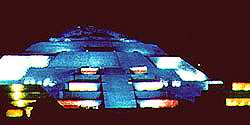
Pyramid of the Sun from the Pyramid of the Moon
This view is looking south from the upper terrace of the Pyramid of the Moon, and along the Avenue of the Dead, towards the Pyramid of the Sun, which towers over the center of the site, emulating the shapes of the mountains in the distance beyond. The Pyramid of the Sun is a huge earthen mound, 225 meters square and 142 meters high, that dates from about 100 AD. There are 248 steps leading up to the top of the pyramid on the west side, and the whole structure was originally covered with bright red plaster, which must have been radiant at sunset.
This view is looking south from the upper terrace of the Pyramid of the Moon, and along the Avenue of the Dead, towards the Pyramid of the Sun, which towers over the center of the site, emulating the shapes of the mountains in the distance beyond. The Pyramid of the Sun is a huge earthen mound, 225 meters square and 142 meters high, that dates from about 100 AD. There are 248 steps leading up to the top of the pyramid on the west side, and the whole structure was originally covered with bright red plaster, which must have been radiant at sunset.
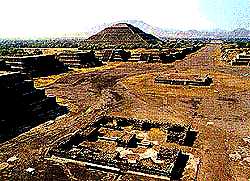
Ceremonial Stone Sundisk with Giant Skull
The sculpted stone sundisk was found in a subterranean grotto directly below the center of the Pyramid of the Sun, during excavations in 1971. It depicts a human skull with a chin piece, surrounded by the radiating disk of the sun, a powerful representation of the god of the sun, and of death, to whom the pyramid was dedicated. The sun stone bears strong resemblances to much later Aztec sculptures, such as the giant calendar stone.
The sculpted stone sundisk was found in a subterranean grotto directly below the center of the Pyramid of the Sun, during excavations in 1971. It depicts a human skull with a chin piece, surrounded by the radiating disk of the sun, a powerful representation of the god of the sun, and of death, to whom the pyramid was dedicated. The sun stone bears strong resemblances to much later Aztec sculptures, such as the giant calendar stone.
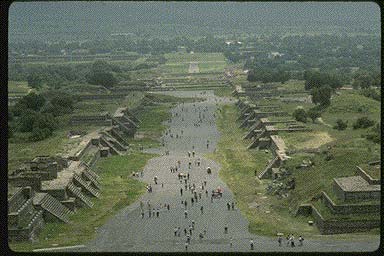
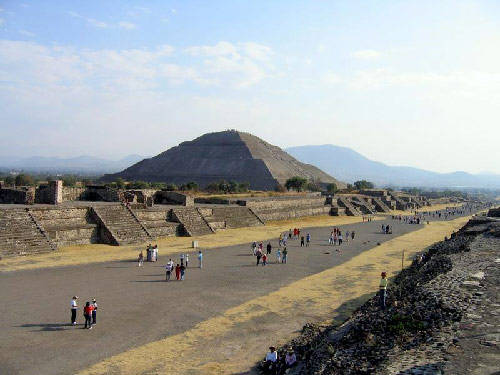


The Avenue of the dead - Running south from the Pyramid of the moon for about 3.2 km, where it was bisected by an east-west Avenue of equal length. Along it are a series of open courtyards', each up to 145m wide and lined with small platforms. (12).
The Avenue of the Dead was the main street of Teotihuacan. It ran south for more than 3km, beginning at the Moon Plaza and extending beyond the Ciudadela and the Great Compound complexes to the south. According to Millon (Cowgill 1992a:96; Millon 1981:221), the avenue continued even further south, terminating near the edge of the mountains on the distant horizon.
A large, long drainage channel ran under the floor of the avenue gathering rain water from neighbouring architectural units and draining it into Rio San Juan.
Teotihuacán Pyramids:
There are two larger pyramids and one smaller at Teotihuacan. The smaller one, called 'The Pyramid of Quetzalcoatl' or the 'Pyramid of the Feathered Serpent' is now considered to be the most important of the three. A series of tunnels have been found underneath it in 2010. They are thought to be the resting place of the Ruling elite.
The Avenue of the Dead was the main street of Teotihuacan. It ran south for more than 3km, beginning at the Moon Plaza and extending beyond the Ciudadela and the Great Compound complexes to the south. According to Millon (Cowgill 1992a:96; Millon 1981:221), the avenue continued even further south, terminating near the edge of the mountains on the distant horizon.
A large, long drainage channel ran under the floor of the avenue gathering rain water from neighbouring architectural units and draining it into Rio San Juan.
Teotihuacán Pyramids:
There are two larger pyramids and one smaller at Teotihuacan. The smaller one, called 'The Pyramid of Quetzalcoatl' or the 'Pyramid of the Feathered Serpent' is now considered to be the most important of the three. A series of tunnels have been found underneath it in 2010. They are thought to be the resting place of the Ruling elite.
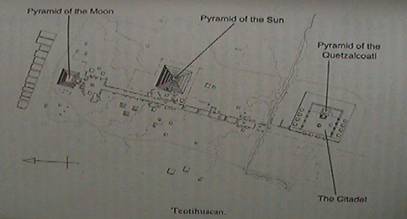
The layout is often compared to the pyramids at a Giza nd Orion.
(It is noticeable that there are several triple-circles in England which also share the same layout)
The Pyramid of the Sun:
The largest of the Teotihuacán pyramids, the pyramid of the sun was actually reconstructed as five stepped platforms. However, the forth platform seems to have been erroneously reconstructed by Batres following his heavy-handed excavations in 1907. The pyramid originally consisted of four stepped platforms, a surmounting temple, and the Adosada platform, which was built over what was originally the principal facade of the pyramid. No information about the temple itself is available, since, along with the upper-most portion of the pyramid, it has been completely destroyed.
The top storey temple containing a great image of the sun carved from a rough block of stone. In the breast was inlaid a star of the purest gold, which was later seized by the followers of Cortes
(It is noticeable that there are several triple-circles in England which also share the same layout)
The Pyramid of the Sun:
The largest of the Teotihuacán pyramids, the pyramid of the sun was actually reconstructed as five stepped platforms. However, the forth platform seems to have been erroneously reconstructed by Batres following his heavy-handed excavations in 1907. The pyramid originally consisted of four stepped platforms, a surmounting temple, and the Adosada platform, which was built over what was originally the principal facade of the pyramid. No information about the temple itself is available, since, along with the upper-most portion of the pyramid, it has been completely destroyed.
The top storey temple containing a great image of the sun carved from a rough block of stone. In the breast was inlaid a star of the purest gold, which was later seized by the followers of Cortes
A prehistoric structure had been buried beneath a much later mound immediately in front of it. The exposed temple still had traces of multicoloured paintings on the rows of rectangular panels superimposed on the sloping walls with sculpted serpent heads lining the sides of the stairway and facing blocks.

Several mass graves, excavated between 1982 and 1989, were found around and beneath the Temple of the Feathered Serpent (Quetzelcoatl) at the southern end of the site. The 137 people buried there were apparently sacrificed, their hands tied behind their backs, during the construction of the pyramid
Tunnel System Uncovered at the Pyramid of the Feathered Serpent.

'Following 8 months of investigative work, archaeologists of the National Institute of Anthropology and History (INAH) located, 12 meters below, the entrance to the tunnel that leads to galleries under the Feathered Serpent Temple, in Teotihuacan.
The tunnel passes under the Temple of the Feathered Serpent, the most important building of the Citadel, “and the entry was located a few meters from the pyramid. A vertical shaft of almost 5 meters by side is the access to the tunnel: it goes 14 meters deep, and the entrance leads to a nearly 100 meters long corridor that ends in a series of underground galleries excavated in the rock.
The tunnel was discovered in late 2003 by Sergio Gomez and Julie Gazzola, but its exploration has required several years of planning and managing the financial resources necessary to carry out research at the highest scientific level. So far, 200 tons of earth have been withdrawn, he said, while doing this we have found about 60,000 pieces of artefacts and pottery.
“Several indications suggest that access to the underground passage was closed between 200 and 250 AD, probably after depositing something inside. One of the hypotheses postulate that, within the large chamber detected by the GPR, we could locate the remains of important people in the city. ”
The investigations have led to know with certainty that this tunnel was made prior to the construction of the Temple of the Feathered Serpent and the Citadel. The tunnel is contemporary with a large architectural structure, which could be a ball game court, according to the form of the ground. According to the hypothesis about the meaning and symbolism of the tunnel, archaeologist Sergio Gomez, said the tunnel had to be linked to concepts related to the underworld, hence it is possible that in this place were carried out initiation rituals and the divine investiture of Teotihuacan rulers, since the power was acquired in these sacred spaces.
the excavation have permitted to recuperate thousands of small ornaments, made of shell, jade from Guatemala, serpentine, slate and obsidian, thrown by the people from Teotihuacan as offerings at the moment of closing the entrance. Several parts of a frieze that may have decorated a building prior to the Temple of the Feathered Serpent, and that was dismantled, have been found as well'.
The tunnel passes under the Temple of the Feathered Serpent, the most important building of the Citadel, “and the entry was located a few meters from the pyramid. A vertical shaft of almost 5 meters by side is the access to the tunnel: it goes 14 meters deep, and the entrance leads to a nearly 100 meters long corridor that ends in a series of underground galleries excavated in the rock.
The tunnel was discovered in late 2003 by Sergio Gomez and Julie Gazzola, but its exploration has required several years of planning and managing the financial resources necessary to carry out research at the highest scientific level. So far, 200 tons of earth have been withdrawn, he said, while doing this we have found about 60,000 pieces of artefacts and pottery.
“Several indications suggest that access to the underground passage was closed between 200 and 250 AD, probably after depositing something inside. One of the hypotheses postulate that, within the large chamber detected by the GPR, we could locate the remains of important people in the city. ”
The investigations have led to know with certainty that this tunnel was made prior to the construction of the Temple of the Feathered Serpent and the Citadel. The tunnel is contemporary with a large architectural structure, which could be a ball game court, according to the form of the ground. According to the hypothesis about the meaning and symbolism of the tunnel, archaeologist Sergio Gomez, said the tunnel had to be linked to concepts related to the underworld, hence it is possible that in this place were carried out initiation rituals and the divine investiture of Teotihuacan rulers, since the power was acquired in these sacred spaces.
the excavation have permitted to recuperate thousands of small ornaments, made of shell, jade from Guatemala, serpentine, slate and obsidian, thrown by the people from Teotihuacan as offerings at the moment of closing the entrance. Several parts of a frieze that may have decorated a building prior to the Temple of the Feathered Serpent, and that was dismantled, have been found as well'.
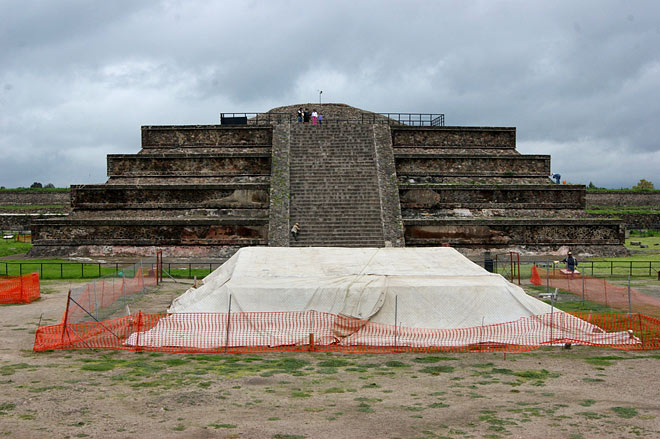
"It is possible," concluded Sergio Gómez, "that the tunnel discovered would have been the most important and sacred element around which the first constructions were undertaken on this site about 100 B.C., and where later on The Citadel was erected, which was the magnificent stage where rituals associated with the myths of creation and the beginning of the mythic time must have been performed."
The Mica Temple:
Following the discovery of mica in the Pyramid of the Sun, two more sheets, approx' 90 ft square, and laid directly on top of one another, were discovered beneath the stone paved floor of the Mica temple. Trace element testing showed it to originate 2000 miles away in Brazil. Similar finds of Mica have been found at some Mayan sites.
The first sheets of mica were found in between two of the upper levels of the Pyramid of the Sun. The discovery occurred in 1906, when the complex was restored. But the mica was removed and sold as soon as it had been excavated, by Leopoldo Batres, the man in charge of the project.
More recently, a “Mica Temple” has been discovered on the site, but this time, the mica has remained in situ. The temple sits around a patio about 300 metres south of the west face of the Pyramid of the Sun. Directly under a floor paved with heavy rock slabs, they found two massive sheets of mica. The sheets are 90 feet square and form two layers, one laid directly on top of the other. As it sits underneath a stone floor, its use was obviously not decorative, but functional.
Mica is a substance containing different metals, depending on the kind of rock formation in which it is found. The type of mica found at Teotihuacán indicates a type that is only found in Brazil, more than 2000 miles away. The same South American mica was found in Olmec sites. It is clear that its presence in Teotihuacán involved a lot of effort – and it thus must have played an important role
As yet there is no satisfactory explanation as to how the Mica sheets (up-to 30cm thick) were transported there over 2000 Miles, nor their significance or purpose in relation to the complex or pyramids.
According to most sources the mica is said to originate from a source in Brazil, over 2000miles distant (suggesting transport by boat), for Example, Childress says of it 'According to expert opinions the mica found at Teotihuacán is a type found only in faraway Brazil', While Fagan , calls it 'locally mined mica'. The jury is out on this one.
Mica is used by the electronics industry in capacitor construction, Thermal and electric insulation, Opaque to fast neutrons, and it acts as a moderator in nuclear reactions.
The Mica Temple:
Following the discovery of mica in the Pyramid of the Sun, two more sheets, approx' 90 ft square, and laid directly on top of one another, were discovered beneath the stone paved floor of the Mica temple. Trace element testing showed it to originate 2000 miles away in Brazil. Similar finds of Mica have been found at some Mayan sites.
The first sheets of mica were found in between two of the upper levels of the Pyramid of the Sun. The discovery occurred in 1906, when the complex was restored. But the mica was removed and sold as soon as it had been excavated, by Leopoldo Batres, the man in charge of the project.
More recently, a “Mica Temple” has been discovered on the site, but this time, the mica has remained in situ. The temple sits around a patio about 300 metres south of the west face of the Pyramid of the Sun. Directly under a floor paved with heavy rock slabs, they found two massive sheets of mica. The sheets are 90 feet square and form two layers, one laid directly on top of the other. As it sits underneath a stone floor, its use was obviously not decorative, but functional.
Mica is a substance containing different metals, depending on the kind of rock formation in which it is found. The type of mica found at Teotihuacán indicates a type that is only found in Brazil, more than 2000 miles away. The same South American mica was found in Olmec sites. It is clear that its presence in Teotihuacán involved a lot of effort – and it thus must have played an important role
As yet there is no satisfactory explanation as to how the Mica sheets (up-to 30cm thick) were transported there over 2000 Miles, nor their significance or purpose in relation to the complex or pyramids.
According to most sources the mica is said to originate from a source in Brazil, over 2000miles distant (suggesting transport by boat), for Example, Childress says of it 'According to expert opinions the mica found at Teotihuacán is a type found only in faraway Brazil', While Fagan , calls it 'locally mined mica'. The jury is out on this one.
Mica is used by the electronics industry in capacitor construction, Thermal and electric insulation, Opaque to fast neutrons, and it acts as a moderator in nuclear reactions.
Archaeoastronomy at Teotihuacan.
It is a curious fact that the city of Teotihuacán was meticulously laid out on a grid which is offset 15º.5 from the cardinal points. Its main avenue, the "Street of the Dead," runs from 15º.5 east of north to 15º.5 west of south, as does its most impressive structure, the Pyramid of the Sun, which is directly oriented to a point 15º.5 north of west.
The New World equivalent of the Gizeh pyramids may well be Teotihuacan, even in as much detail that its layout also mimics astronomical information, even that of Orion’s Belt.
It is a curious fact that the city of Teotihuacán was meticulously laid out on a grid which is offset 15º.5 from the cardinal points. Its main avenue, the "Street of the Dead," runs from 15º.5 east of north to 15º.5 west of south, as does its most impressive structure, the Pyramid of the Sun, which is directly oriented to a point 15º.5 north of west.
The New World equivalent of the Gizeh pyramids may well be Teotihuacan, even in as much detail that its layout also mimics astronomical information, even that of Orion’s Belt.
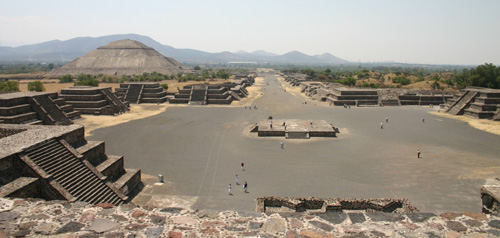
The citadel of Teotihuacan, The name means “place of the gods” or “where men were transformed into gods”, a name given by the Aztecs. It has lead to speculation that the structures were thus constructed by extra-terrestrial beings, or giants – if only because the central focus of the complex is a series of pyramids: the Pyramid of the Moon and the Pyramid of the Sun, whom together with the Temple of Quetzalcoatl, are the axis along which the city developed itself.
The actual central axis is the “Avenue of the Dead”, running from the plaza in front of Pyramid of the Moon past the two other features, and beyond, originally 4 km long. It was named Avenue of the Dead because of archaeological discoveries alongside it. Still, the name may betray a mythical aspect, as Stansbury Hagar suggested that the Avenue may be a representation of the Milky Way – normally seen as a Way of the Soul.
Hagat stated that the entire complex was a map of heaven: “It reproduced on earth a supposed celestial plan of the sky world where dwelt the deities and spirits of the dead.” His conclusions were in line with those of Hugh Harleston Jr., who mapped the complex in the 1960s and 1970s and believed that the entire complex was a precise scale-model of the solar system.
If the centre line of the Temple of Quetzalcoatl was taken as the position of the sun, markers laid out northwards from it along the axis of the Avenue seemed to indicated the correct orbital distances of the inner planets, the asteroid belt, Jupiter, Saturn (the Sun Pyramid), Uranus (the Moon Pyramid) and Neptune and Pluto, represented by two mounds further north. Harleston’s suggestion fuelled speculation of extra-terrestrial intervention in the Mayan civilisation, as the planet Uranus had only been discovered in 1787, Pluto as late as 1930. How did the Mayans have knowledge of this?
Hugh Harleston Jr. also concluded that the entire site was constructed according to a system of measurement that he named the STU, Standard Teotihuacan Unit, which is equals 1.059 meters. This unit features into the length of a side of the Pyramid of the Sun and the Pyramid of the Moon, as well as in the distance between the two pyramids...cont'd
The actual central axis is the “Avenue of the Dead”, running from the plaza in front of Pyramid of the Moon past the two other features, and beyond, originally 4 km long. It was named Avenue of the Dead because of archaeological discoveries alongside it. Still, the name may betray a mythical aspect, as Stansbury Hagar suggested that the Avenue may be a representation of the Milky Way – normally seen as a Way of the Soul.
Hagat stated that the entire complex was a map of heaven: “It reproduced on earth a supposed celestial plan of the sky world where dwelt the deities and spirits of the dead.” His conclusions were in line with those of Hugh Harleston Jr., who mapped the complex in the 1960s and 1970s and believed that the entire complex was a precise scale-model of the solar system.
If the centre line of the Temple of Quetzalcoatl was taken as the position of the sun, markers laid out northwards from it along the axis of the Avenue seemed to indicated the correct orbital distances of the inner planets, the asteroid belt, Jupiter, Saturn (the Sun Pyramid), Uranus (the Moon Pyramid) and Neptune and Pluto, represented by two mounds further north. Harleston’s suggestion fuelled speculation of extra-terrestrial intervention in the Mayan civilisation, as the planet Uranus had only been discovered in 1787, Pluto as late as 1930. How did the Mayans have knowledge of this?
Hugh Harleston Jr. also concluded that the entire site was constructed according to a system of measurement that he named the STU, Standard Teotihuacan Unit, which is equals 1.059 meters. This unit features into the length of a side of the Pyramid of the Sun and the Pyramid of the Moon, as well as in the distance between the two pyramids...cont'd

Except for the Ciudadela and the Great Compound, the major monumental constructions in the city were concentrated in its northern section along the Avenue of the Dead, as seen in this map. Many construction units along the avenue, as well as residential compounds, have been excavated and consolidated by projects of the National Institute of Anthropology and History in Mexico. The largest single construction, the Sun Pyramid, stands in the middle of the northern section of the Avenue of the Dead as the principal pyramid of the city, while the second largest pyramid, the Moon Pyramid, is located at the northern end of the Avenue of the Dead. The Ciudadela ("Citadel") has been extensively excavated by several projects as described in the Feathered Serpent Pyramid pages. However, the Great Compound, interpreted as probably enclosing the city's principal marketplace by Millon, has not been excavated, except for several test pits and a small portion in its northeastern corner. Rectangles on the map represent apartment compounds recorded by the Teotihuacan Mapping Project. Several residential complexes, such as Tetitla and Zacuala, seen in this map, are completely excavated, consolidated, and currently open to the public. These unique structures characterized one of the largest, most populous, and highly planned ceremonial centers in the New World.
During September, LivePuntaMita.com will be sharing with you 30 things we love most about Mexico, in honor of this month’s Independence celebrations.
During September, LivePuntaMita.com will be sharing with you 30 things we love most about Mexico, in honor of this month’s Independence celebrations.



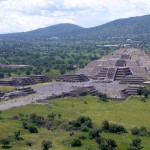


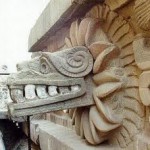
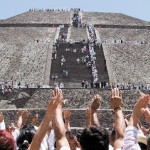
Teotihuacan “Citadel”
Pyramid of the Sun
Pyramid of the Moon
Teotihuacan View
Teotihuacan Rituals
Teotihuacan Map
Temple of Quetzalcoatl
Equinox Celebration
Measurement units of the Citadel in Teotihuacan, Mexico.
Satellite images provided by Google Earth have been used in this study to try and determine the units of measurement used in the planning of the enclosure known as the Citadel in the ancient city of Teotihuacan, Mexico.
This follows on from studies of measurement units in Teotihuacan
Satellite images provided by Google Earth have been used in this study to try and determine the units of measurement used in the planning of the enclosure known as the Citadel in the ancient city of Teotihuacan, Mexico.
This follows on from studies of measurement units in Teotihuacan

Hugh Harleston jnr found Teotihuacan to be built in measures of 1.059 metres which would be 2 x cubits of 20.85" making one hunab (compare to 2 x Egyptian Royal cubits of 20.625" making 1 hunab)
Prof Sugiyama proposed a unit of 830 mm for Teotihuacan. This would be a yard of 32.68" and very interestingly compares to the "megalithic yard" of 32.64" found by Prof A. Thom for the Megalithic Sites in Britain.
Prof Sugiyama quotes a study by Drewitt (1969, 1987) and Drucker (1971,1974, 1977's) which found a unit of 805 mm (31.692").
The Sumerian basic units were a "shusi" of 0.66", link of 12 shusi (7.92"), foot of 20 shusi (13.2") cubit of 30 shusi (19.8"), yard of 50 shusi (33.0") and double yard of 100 shusi (66.0").
For larger distances, the pole of 16.5 feet (15 Sumerian feet) was used, along with a chain of 66 feet (60 Sumerian feet which was 100 links) and furlong of 660 feet (600 Sumerian feet).
Looking back to Drewitt and Druckers figure of 805 mm (31.692") we can readily see that in place of a yard of 50 shusi,they have been calculating in yards of 48 shusi (4 x links) since 48 x 0.66" = 31.68" = 804.7 mm and their study in itself provides evidence of the use of "Sumerian" measurement units at Teotihuacan.
This study looks at the citadel for evidence of "Sumerian" units, but in actual fact, it seems that "Sumerian", "Egyptian" and "Mayan" units are all based on the same measurement foundation, a plot of 100 x 100 "Sumerian" cubits which when divided by 100, 96 or 48 gives "Sumerian", Egyptian" or Mayan" units respectively.
Prof Sugiyama proposed a unit of 830 mm for Teotihuacan. This would be a yard of 32.68" and very interestingly compares to the "megalithic yard" of 32.64" found by Prof A. Thom for the Megalithic Sites in Britain.
Prof Sugiyama quotes a study by Drewitt (1969, 1987) and Drucker (1971,1974, 1977's) which found a unit of 805 mm (31.692").
The Sumerian basic units were a "shusi" of 0.66", link of 12 shusi (7.92"), foot of 20 shusi (13.2") cubit of 30 shusi (19.8"), yard of 50 shusi (33.0") and double yard of 100 shusi (66.0").
For larger distances, the pole of 16.5 feet (15 Sumerian feet) was used, along with a chain of 66 feet (60 Sumerian feet which was 100 links) and furlong of 660 feet (600 Sumerian feet).
Looking back to Drewitt and Druckers figure of 805 mm (31.692") we can readily see that in place of a yard of 50 shusi,they have been calculating in yards of 48 shusi (4 x links) since 48 x 0.66" = 31.68" = 804.7 mm and their study in itself provides evidence of the use of "Sumerian" measurement units at Teotihuacan.
This study looks at the citadel for evidence of "Sumerian" units, but in actual fact, it seems that "Sumerian", "Egyptian" and "Mayan" units are all based on the same measurement foundation, a plot of 100 x 100 "Sumerian" cubits which when divided by 100, 96 or 48 gives "Sumerian", Egyptian" or Mayan" units respectively.
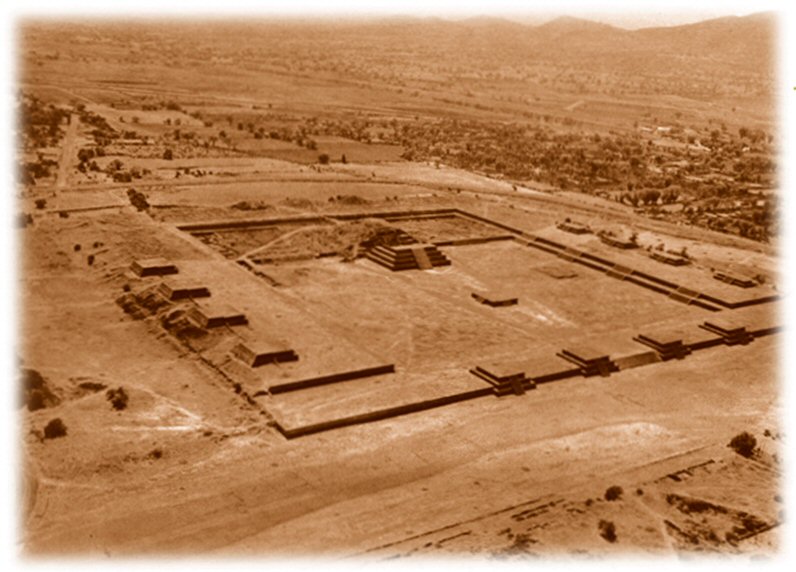

An early view of the Citadel, a name given by the Spanish conquistadors (ciudadela)
Model of Citadel

above, the Citadel today from Google Earth.
Some examples of measurements at the Citadel in Sumerian feet are given below.
Some examples of measurements at the Citadel in Sumerian feet are given below.
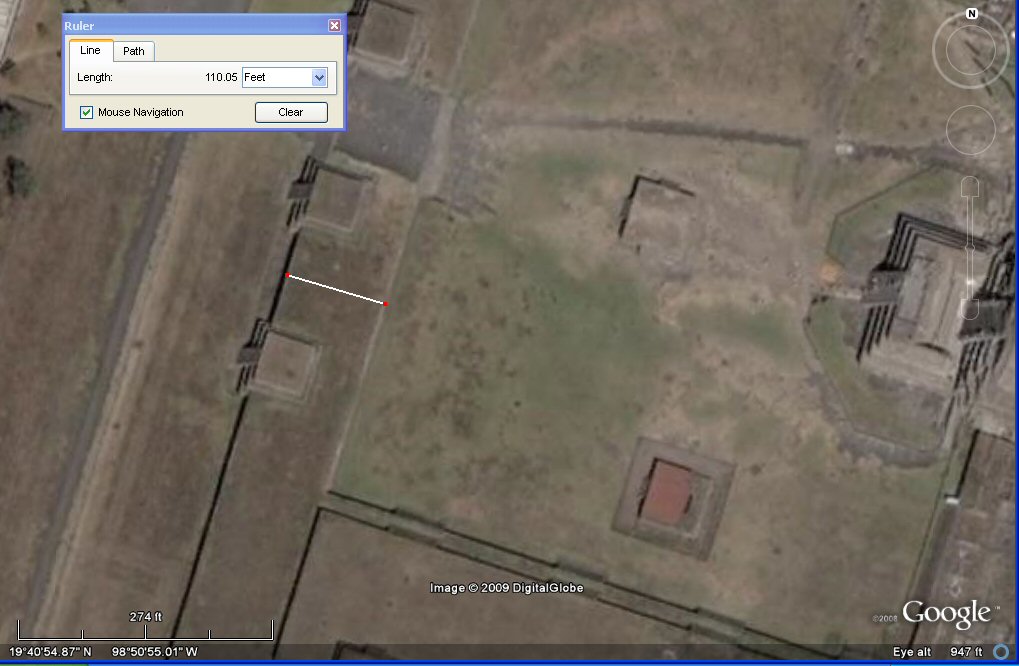

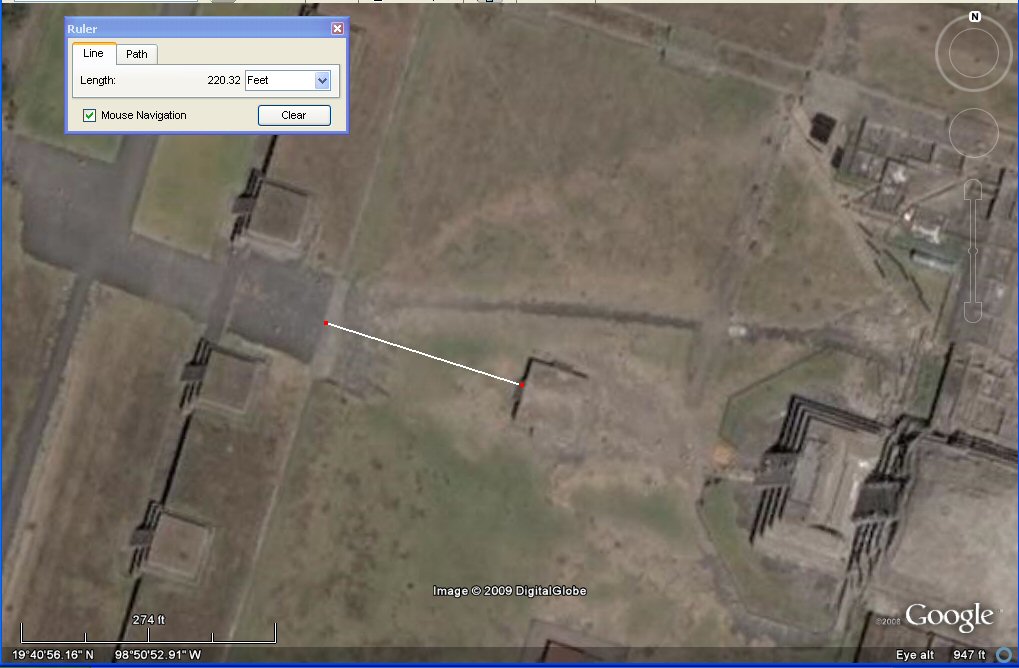
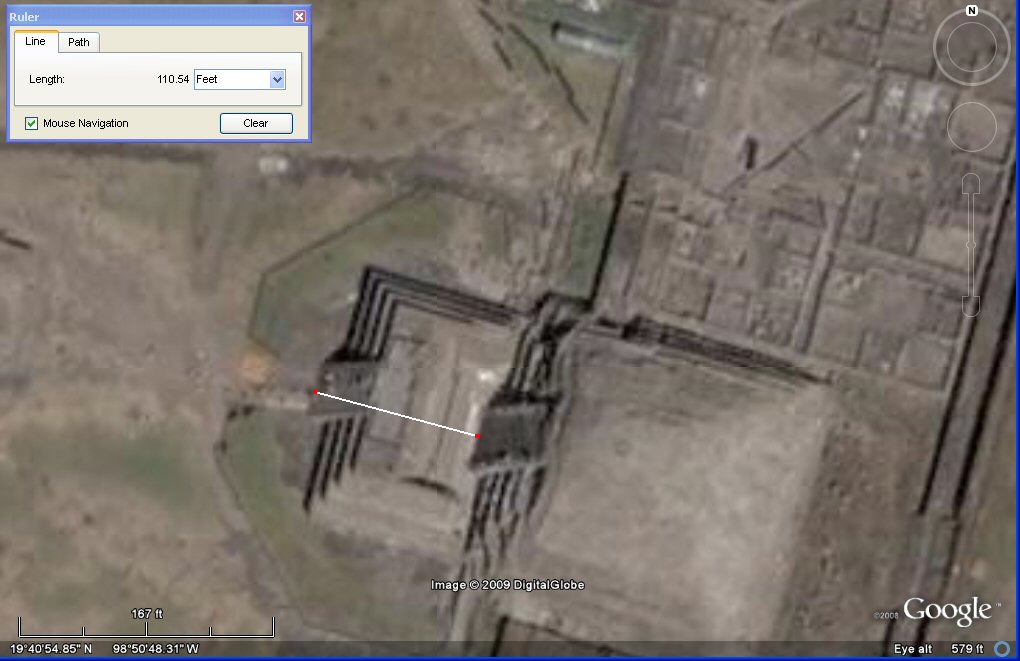
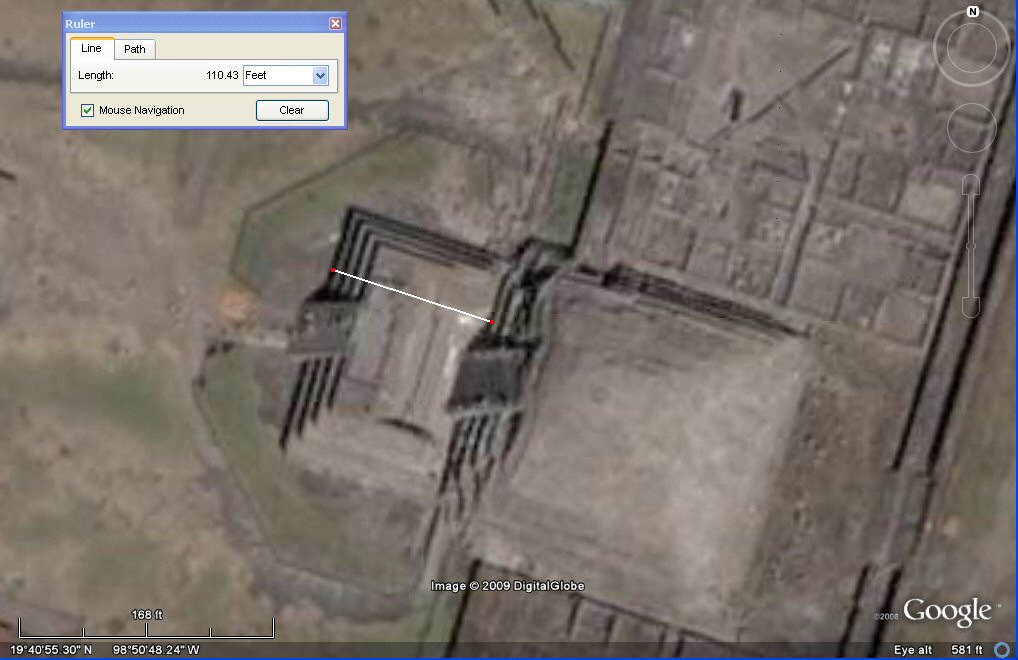

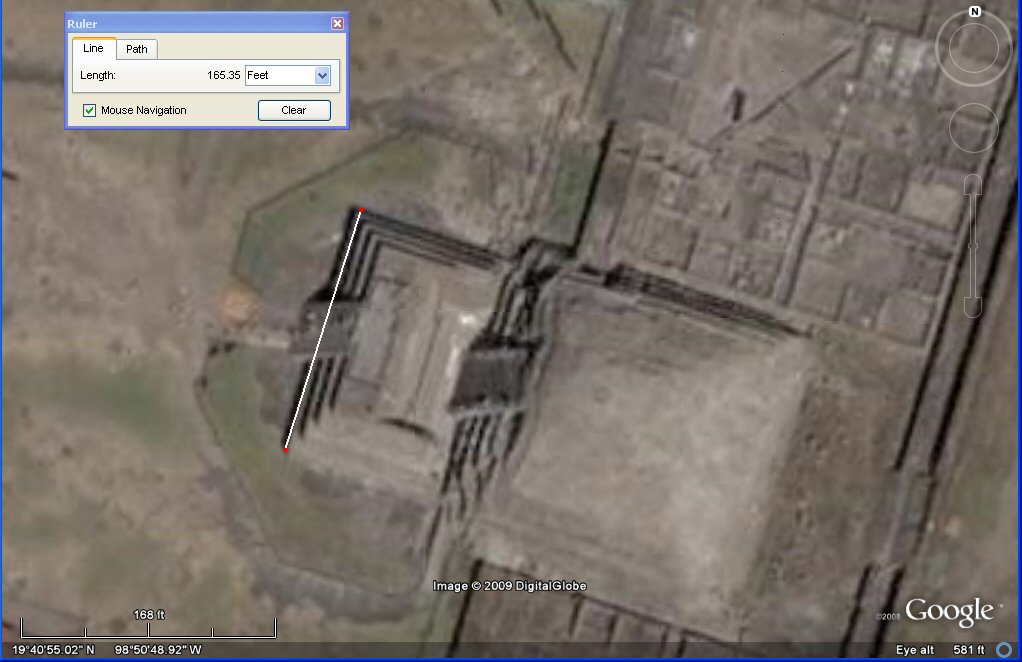

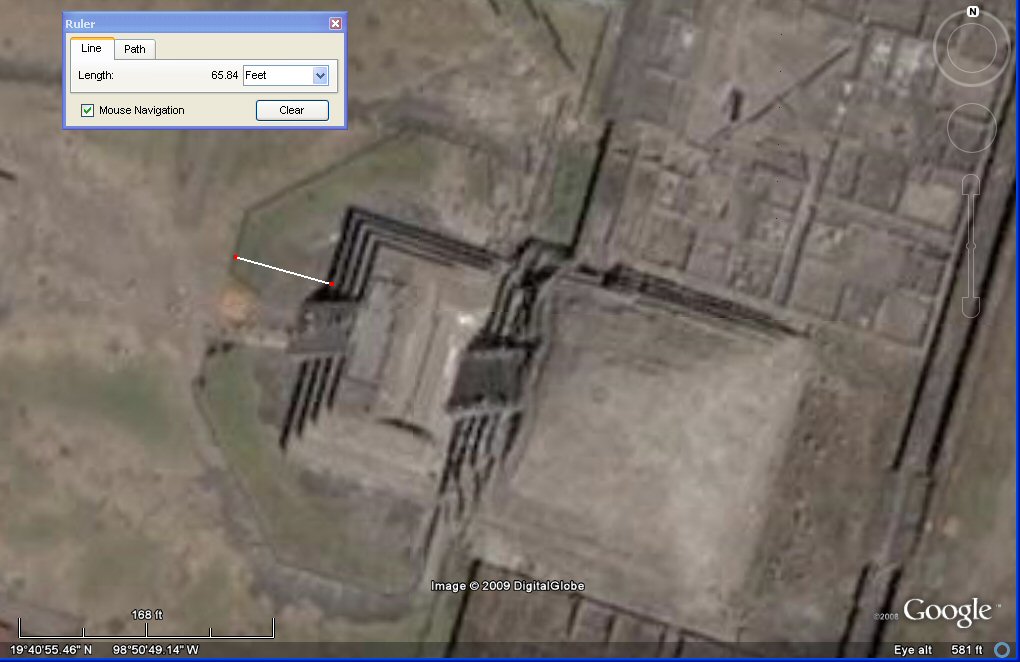
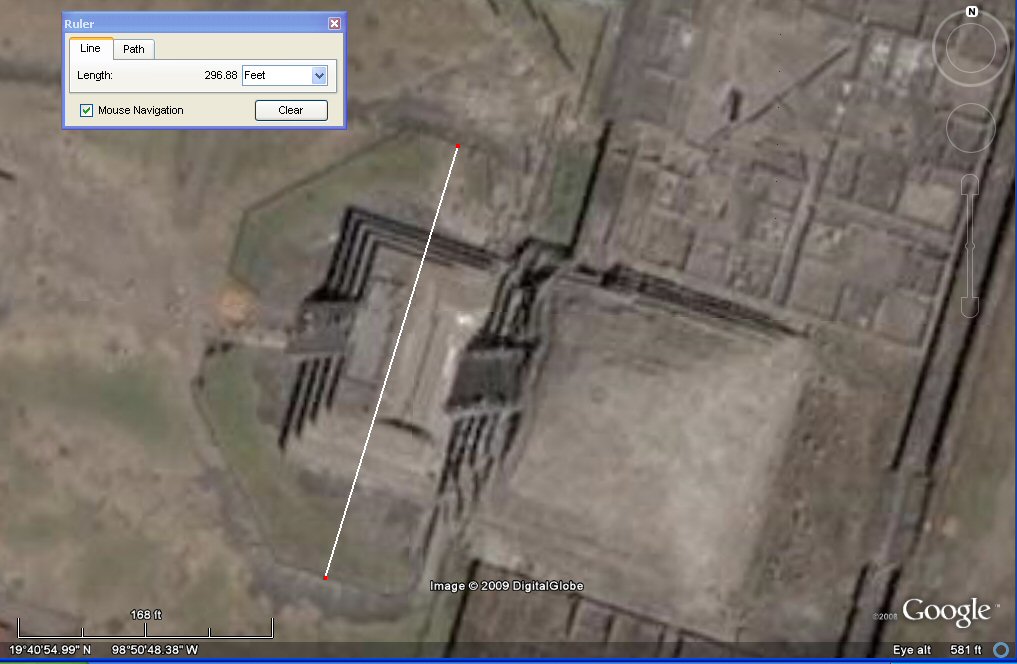

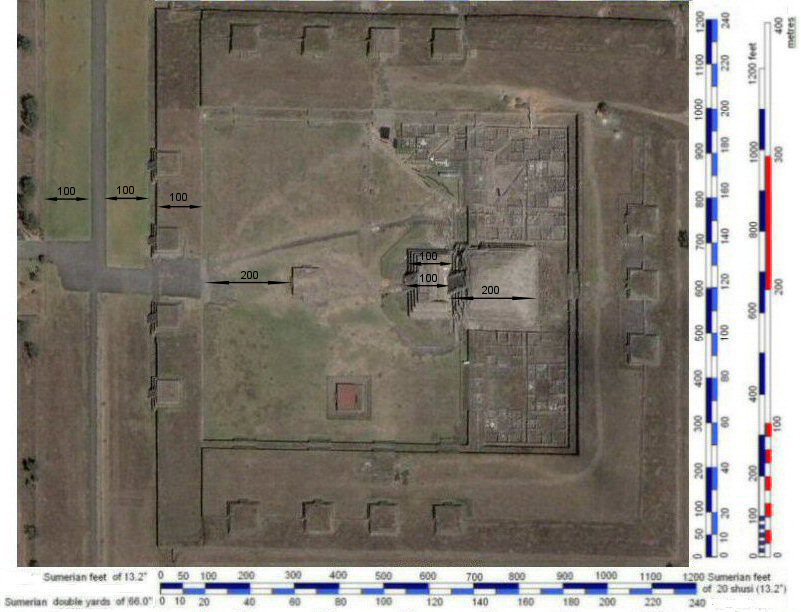
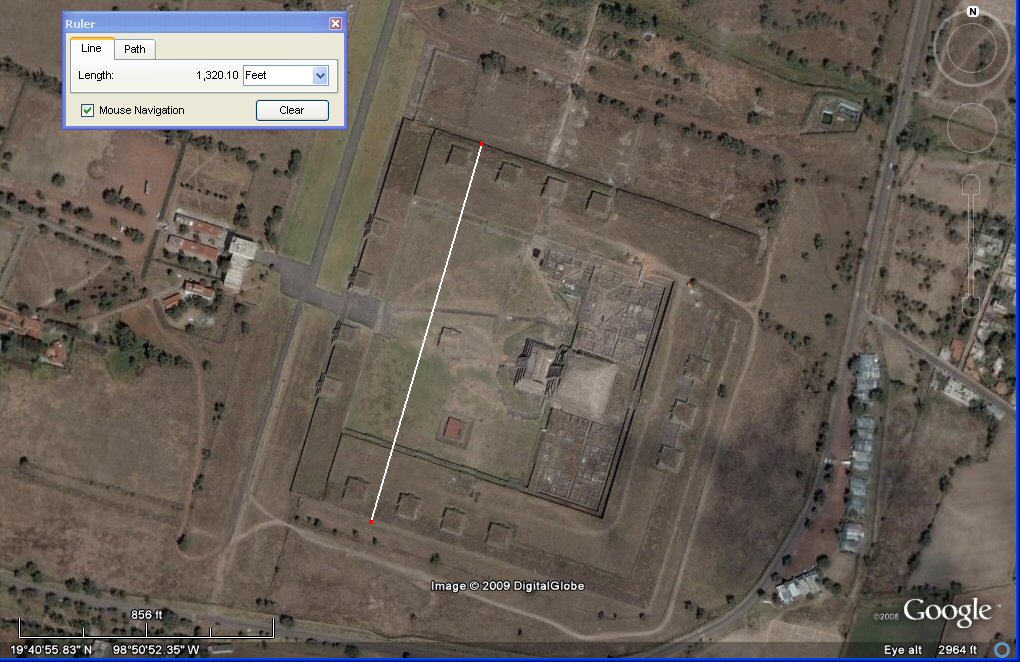
above, the Google Earth satellite measures the width of the entrance wall as 110 feet -
this equals 100 Sumerian feet of 13.2", 40 Sumerian yards of 33.0", 20 Sumerian double yards of 66.0",
or 64 Egyptian royal cubits of 20.62" or 32 Mayan hunabs of 41.25" .
this equals 100 Sumerian feet of 13.2", 40 Sumerian yards of 33.0", 20 Sumerian double yards of 66.0",
or 64 Egyptian royal cubits of 20.62" or 32 Mayan hunabs of 41.25" .
above, close-up of measurement equals 100 Sumerian feet of 13.2" .
above, from the entrance to the first construction is 200 Sumerian feet of 13.2"" .
above, the Google Earth satellite measures the distance from the front of the front pyramid platform steps to the front of the rear pyramid steps as 110 English feet = 100 Sumerian feet.
above, the Google Earth satellite measures the distance from the front of the front pyramid platform base to the front of the rear pyramid base as 110 English feet = 100 Sumerian feet.
above, the Google Earth satellite measures the depth of the pyramid complex as 220 English feet
= 200 Sumerian feet of 13.2"
= 200 Sumerian feet of 13.2"
above, the Google Earth satellite measures the width of the front pyramid platform base as 165 English feet
= 100 Sumerian cubits of 19.8" which is also 150 Sumerian feet of 19.8", 60 Sumerian yards of 33.0",
96 Egyptian royal cubits of 20.62" or 48 Mayan hunabs of 41.25".
= 100 Sumerian cubits of 19.8" which is also 150 Sumerian feet of 19.8", 60 Sumerian yards of 33.0",
96 Egyptian royal cubits of 20.62" or 48 Mayan hunabs of 41.25".
above, the Google Earth satellite measures the width of the pyramid platform as 110 English feet = 100 Sumerian feet.
above, the Google Earth satellite measures the width of this base as 297 English feet = 180 Sumerian cubits of 19.8"
above, the Google Earth satellite measures this distance to the front
as 66 English feet = 60 Sumerian feet or 40 Sumerian cubits.
as 66 English feet = 60 Sumerian feet or 40 Sumerian cubits.
above, the Google Earth satellite measures the width of this terrace as 165 English feet
= 100 Sumerian cubits of 19.8".
= 100 Sumerian cubits of 19.8".
above, the Google Earth photo with units in Sumerian feet imposed.
above, the Google Earth satellite measures the width of the complex as 1320 english feet
which is 1200 Sumerian feet of 13.2" or 800 Sumerian cubits of 19.8"
which is 1200 Sumerian feet of 13.2" or 800 Sumerian cubits of 19.8"
above, the Google Earth photo with additional scale bars imposed
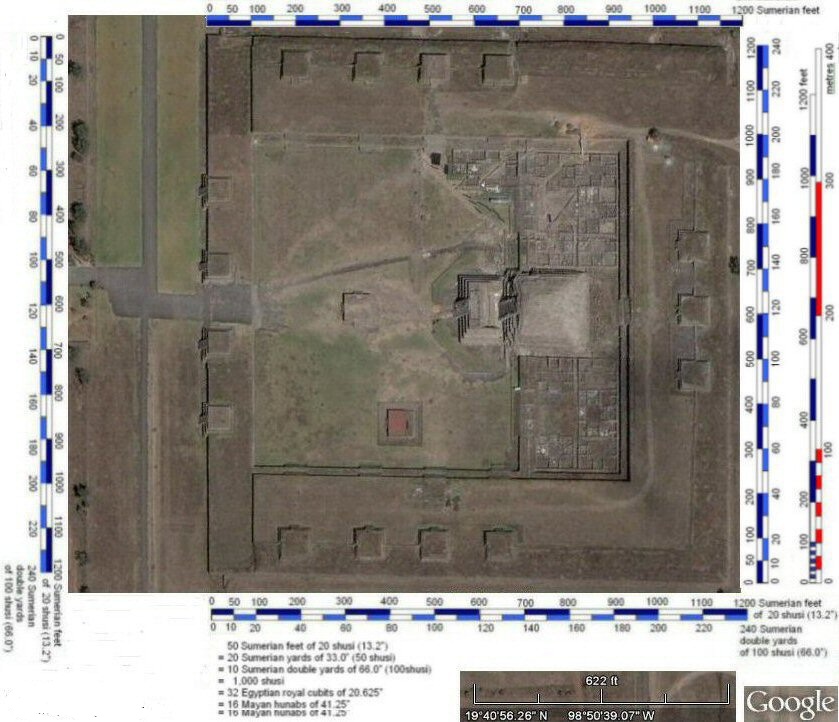
above, the Google Earth photo with scaled grid at 100 Sumerian feet intervals.
above, the Google Earth photo with scaled grid at 50 Sumerian feet intervals.
From the satellite images, the complex appears to measure 1200 Sumerian feet by 1150 Sumerian feet. Although there are many instances of multiples of 100 Sumerian feet suggestng a grid of 100 Sumerian feet was used in the planning, the odd shape of 1200 x 1150 Sumerian feet suggests it was planned on a grid of 50 Sumerian feet.
A unit of 50 Sumerian feet of 13.2" would be 20 Sumerian yards of 50 shusi, or 10 double yards of 100 shusi, or simply, 1,000 Sumerian shusi of 0.66". It would also be 32 Egyptian royal cubits of 20.625" or 16 Mayan hunabs of 41.25". Surprisingly it also means that 32 Egyptian royal cubits were equal to 1,000 Sumerian shusi, seeming to confirm that all the above measurements although attributed to varying countries as far apart as Sumeria, Egypt and Mexico, were originally part of a unified system as seen at Teotihuacan.
From the satellite images, the complex appears to measure 1200 Sumerian feet by 1150 Sumerian feet. Although there are many instances of multiples of 100 Sumerian feet suggestng a grid of 100 Sumerian feet was used in the planning, the odd shape of 1200 x 1150 Sumerian feet suggests it was planned on a grid of 50 Sumerian feet.
A unit of 50 Sumerian feet of 13.2" would be 20 Sumerian yards of 50 shusi, or 10 double yards of 100 shusi, or simply, 1,000 Sumerian shusi of 0.66". It would also be 32 Egyptian royal cubits of 20.625" or 16 Mayan hunabs of 41.25". Surprisingly it also means that 32 Egyptian royal cubits were equal to 1,000 Sumerian shusi, seeming to confirm that all the above measurements although attributed to varying countries as far apart as Sumeria, Egypt and Mexico, were originally part of a unified system as seen at Teotihuacan.
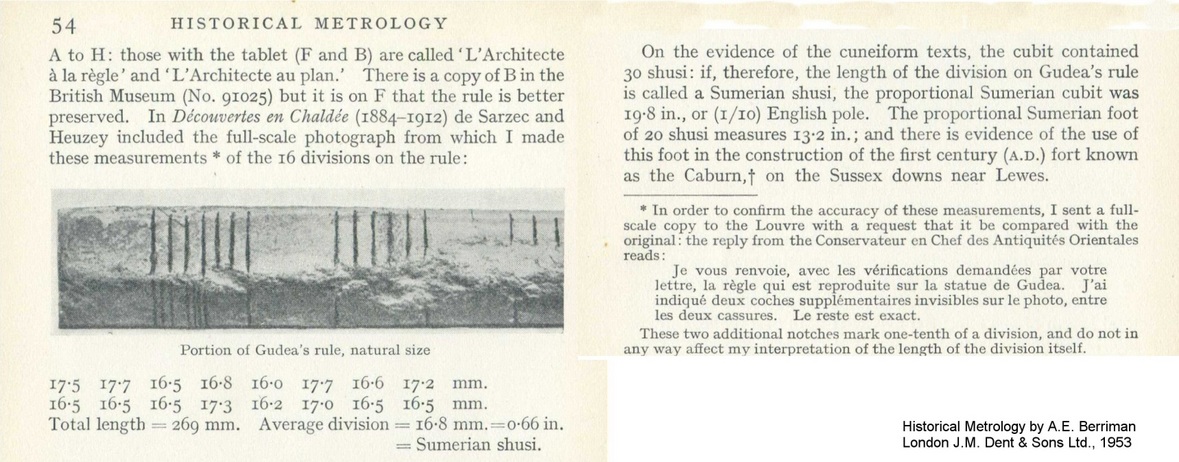


above, a portion of the ruler known as "Gudea's rule" preserved in the Louvre shows intervals in Sumerian "shusi" of 0.66" which Berriman demonstrated formed 20 to the Sumerian foot of 13.2" and 30 to the Sumerian cubit of 19.8".
50 shusi made the Sumerian yard of 33.0" and 100 shusi made the Sumerian "double yard".
50 shusi made the Sumerian yard of 33.0" and 100 shusi made the Sumerian "double yard".
Teotihuacan cubits and measuring units.
This essay follows on from earlier studies of the ancient irrigation canals in Bolivia and Tabasco/Veracruz which suggest a consistent unit of 19.8" (Sumerian cubit of 30 shusi) and 20.625" (Egyptian royal cubit) were used in these regions.
The "Sumerian" cubit was related to the "Egyptian" cubit in the ratio of 24/25 which in practical terms meant that a block of 100 x 100 Sumerian cubits could be divided in 1/10ths or 1/2's and remain in Sumerian cubits, or by 1/3rds for Sumerian yards of 50 shusi or by halves, quarters or eights for 'Egyptian' cubits.
For that reason, it is not unusual to find both 'Sumerian' cubits and 'Egyptian' cubits present at the same locations.
Since the Spanish Conquistadors also brought with them a yard or 'vara' of 33" which obviously had its origin in the Sumerian yard, it might be difficult to identify some irrigation channels or plots which could have been constructed post conquest as compared to those which were pre-conquest in origin.
The object of this page is to look at the stone momuments of Teotihuacan to see if they were constructed in known units such as the "Sumerian" or "Egyptian" cubits.
This essay follows on from earlier studies of the ancient irrigation canals in Bolivia and Tabasco/Veracruz which suggest a consistent unit of 19.8" (Sumerian cubit of 30 shusi) and 20.625" (Egyptian royal cubit) were used in these regions.
The "Sumerian" cubit was related to the "Egyptian" cubit in the ratio of 24/25 which in practical terms meant that a block of 100 x 100 Sumerian cubits could be divided in 1/10ths or 1/2's and remain in Sumerian cubits, or by 1/3rds for Sumerian yards of 50 shusi or by halves, quarters or eights for 'Egyptian' cubits.
For that reason, it is not unusual to find both 'Sumerian' cubits and 'Egyptian' cubits present at the same locations.
Since the Spanish Conquistadors also brought with them a yard or 'vara' of 33" which obviously had its origin in the Sumerian yard, it might be difficult to identify some irrigation channels or plots which could have been constructed post conquest as compared to those which were pre-conquest in origin.
The object of this page is to look at the stone momuments of Teotihuacan to see if they were constructed in known units such as the "Sumerian" or "Egyptian" cubits.

above, Hugh Harleston jnr found Teotihuacan to be built in measures of 1.059 metres which would be 2 x cubits of 20.85" making one hunab
(compare to 2 x Egyptian Royal cubits of 20.625" making 1 hunab)
A study by Saburo Sugiyama, (Barnes & Noble, May 2005), professor at Aichi Prefectural University in Japan and research professor at Arizona State University, (above) highlights the difficulties of establishing a fixed unit of measurement for Teotihuacan. The ruined state of the momuments has been a factor, also the fact that reconstruction has taken place and is still taking place etc.
Prof Sugiyama proposed a unit of 830 mm for Teotihuacan. This would be a yard of 32.68" and very interestingly compares to the "megalithic yard" of 32.64" found by Prof A. Thom for the Megalithic Sites in Britain.
He gives the measured width of a balustrade as 1.6 metres which would be 2 x 32.68" yards.
He gives the distance between sculptured heads as 3.29 metres which would be 4 x 32.38"
He gives the width of a staircase as 13.06 metres. This could be 26 Sumerian cubits of 19.8" (13.07 metres) or 25 Egyptian Royal Cubits of 20.625" (13.09 metres)
He gives the width of the square pyramid's lowest platform as 65 metres. This would be 124 Egyptian Royal Cubits.
Prof Sugiyama quotes a study by Drewitt (1969, 1987) and Drucker (1971,1974, 1977's) which found a unit of 805 mm (31.692").
The Sumerian basic units were a "shusi" of 0.66", link of 12 shusi (7.92"), foot of 20 shusi (13.2") cubit of 30 shusi (19.8"), yard of 50 shusi (33.0") and double yard of 100 shusi (66.0").
For larger distances, the pole of 16.5 feet (15 Sumerian feet) was used, along with a chain of 66 feet (60 Sumerian feet which was 100 links) and furlong of 660 feet (600 Sumerian feet).
Looking back to Drewitt and Druckers figure of 805 mm (31.692") we can readily see that in place of a yard of 50 shusi, they have been calculating in yards of 48 shusi (4 x links) since 48 x 0.66" = 31.68" = 804.7 mm and their study in itself provides evidence of the use of "Sumerian" measurement units at Teotihuacan.
I would suggest it worth reviewing the other measurements from Teotihuacan to see how they also accomodate units of Sumerian cubits or Egyptian Royal Cubits and some suggested measurements from Google Earth are given below.
(compare to 2 x Egyptian Royal cubits of 20.625" making 1 hunab)
A study by Saburo Sugiyama, (Barnes & Noble, May 2005), professor at Aichi Prefectural University in Japan and research professor at Arizona State University, (above) highlights the difficulties of establishing a fixed unit of measurement for Teotihuacan. The ruined state of the momuments has been a factor, also the fact that reconstruction has taken place and is still taking place etc.
Prof Sugiyama proposed a unit of 830 mm for Teotihuacan. This would be a yard of 32.68" and very interestingly compares to the "megalithic yard" of 32.64" found by Prof A. Thom for the Megalithic Sites in Britain.
He gives the measured width of a balustrade as 1.6 metres which would be 2 x 32.68" yards.
He gives the distance between sculptured heads as 3.29 metres which would be 4 x 32.38"
He gives the width of a staircase as 13.06 metres. This could be 26 Sumerian cubits of 19.8" (13.07 metres) or 25 Egyptian Royal Cubits of 20.625" (13.09 metres)
He gives the width of the square pyramid's lowest platform as 65 metres. This would be 124 Egyptian Royal Cubits.
Prof Sugiyama quotes a study by Drewitt (1969, 1987) and Drucker (1971,1974, 1977's) which found a unit of 805 mm (31.692").
The Sumerian basic units were a "shusi" of 0.66", link of 12 shusi (7.92"), foot of 20 shusi (13.2") cubit of 30 shusi (19.8"), yard of 50 shusi (33.0") and double yard of 100 shusi (66.0").
For larger distances, the pole of 16.5 feet (15 Sumerian feet) was used, along with a chain of 66 feet (60 Sumerian feet which was 100 links) and furlong of 660 feet (600 Sumerian feet).
Looking back to Drewitt and Druckers figure of 805 mm (31.692") we can readily see that in place of a yard of 50 shusi, they have been calculating in yards of 48 shusi (4 x links) since 48 x 0.66" = 31.68" = 804.7 mm and their study in itself provides evidence of the use of "Sumerian" measurement units at Teotihuacan.
I would suggest it worth reviewing the other measurements from Teotihuacan to see how they also accomodate units of Sumerian cubits or Egyptian Royal Cubits and some suggested measurements from Google Earth are given below.
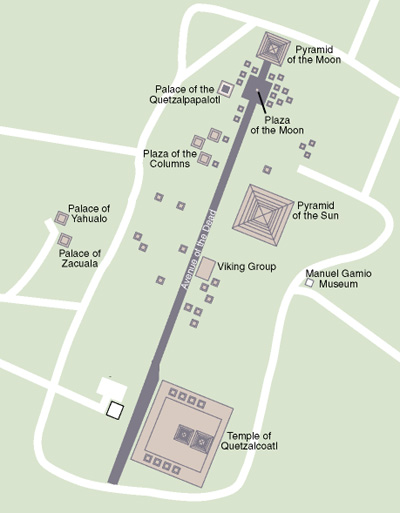
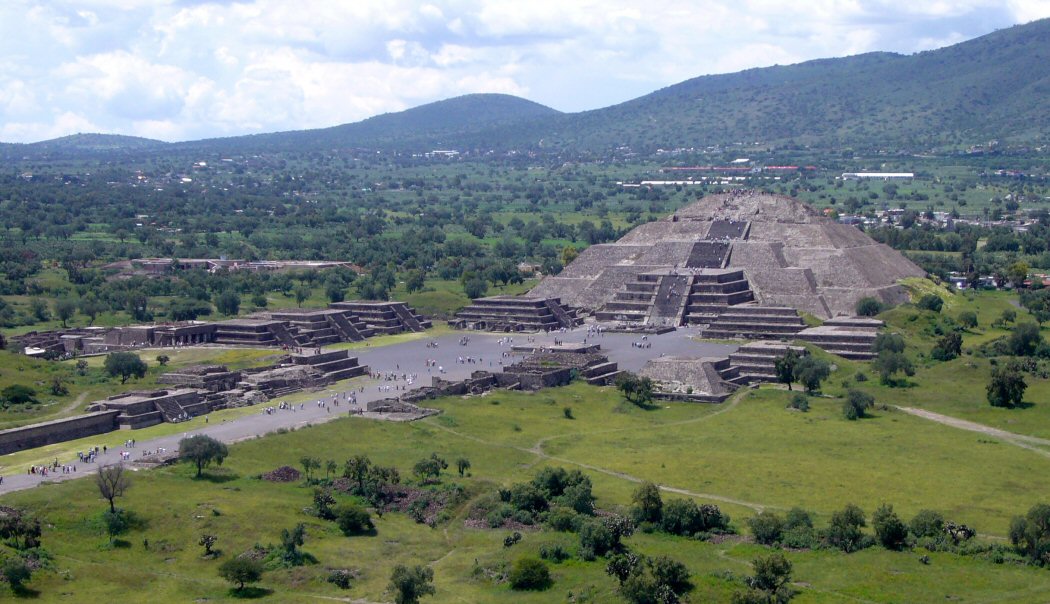
above, Teotihuacan Pyramid of the Moon.
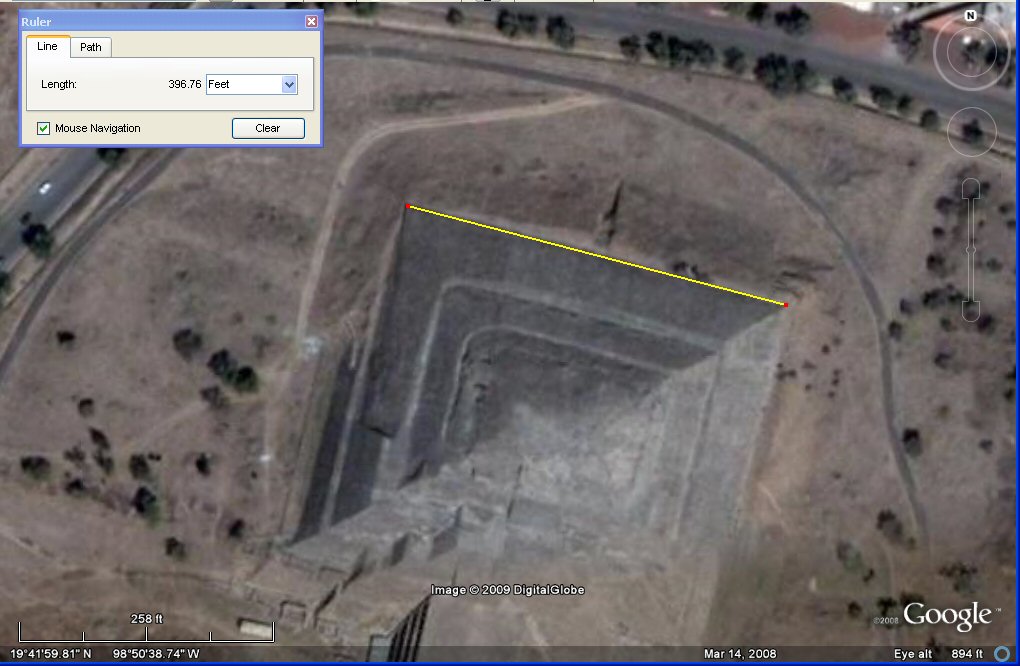
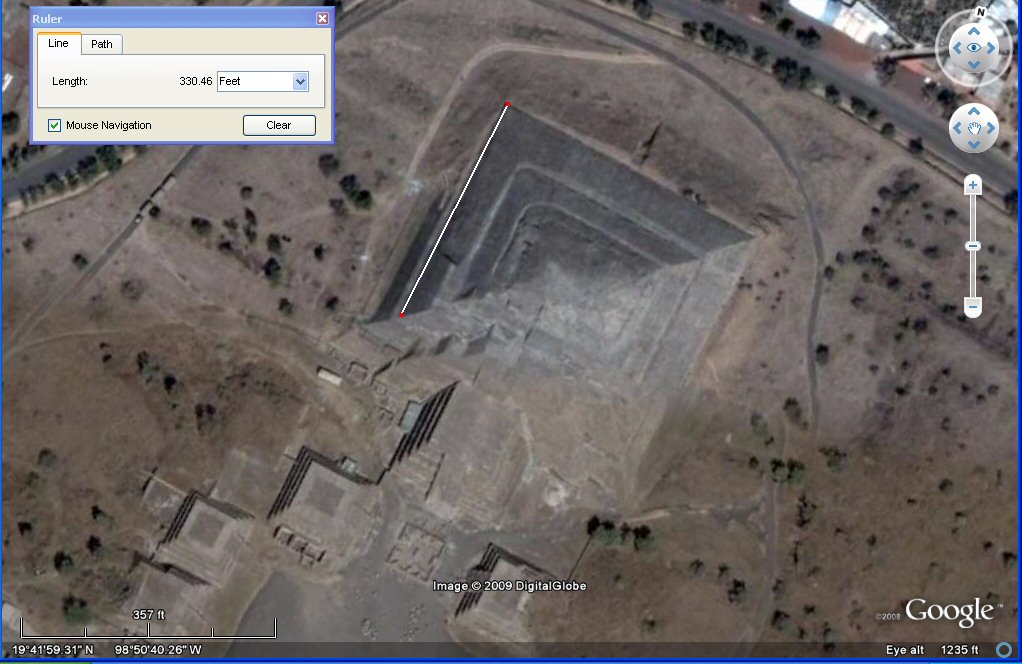

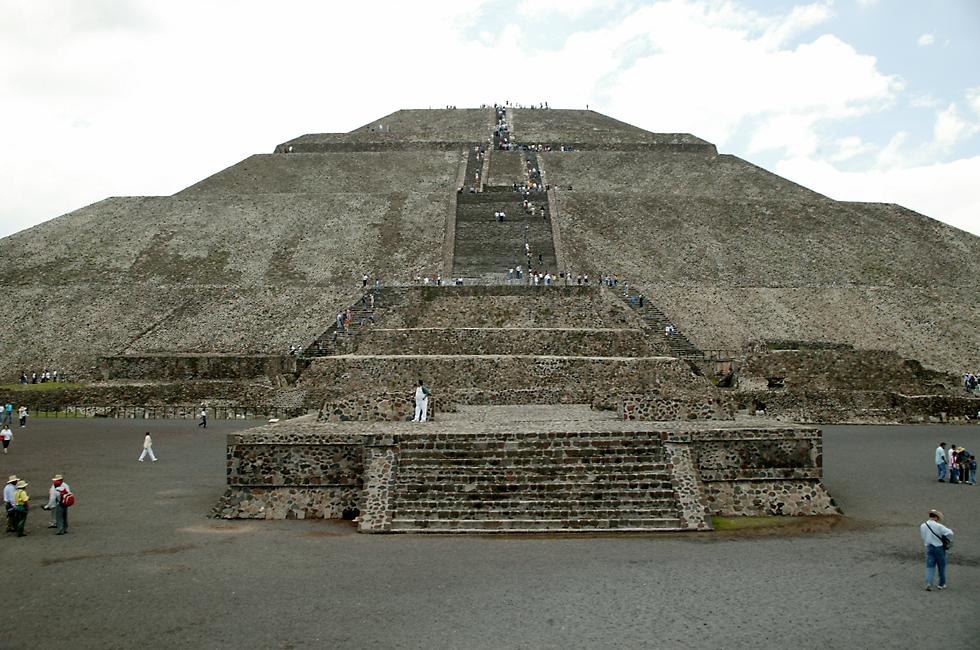
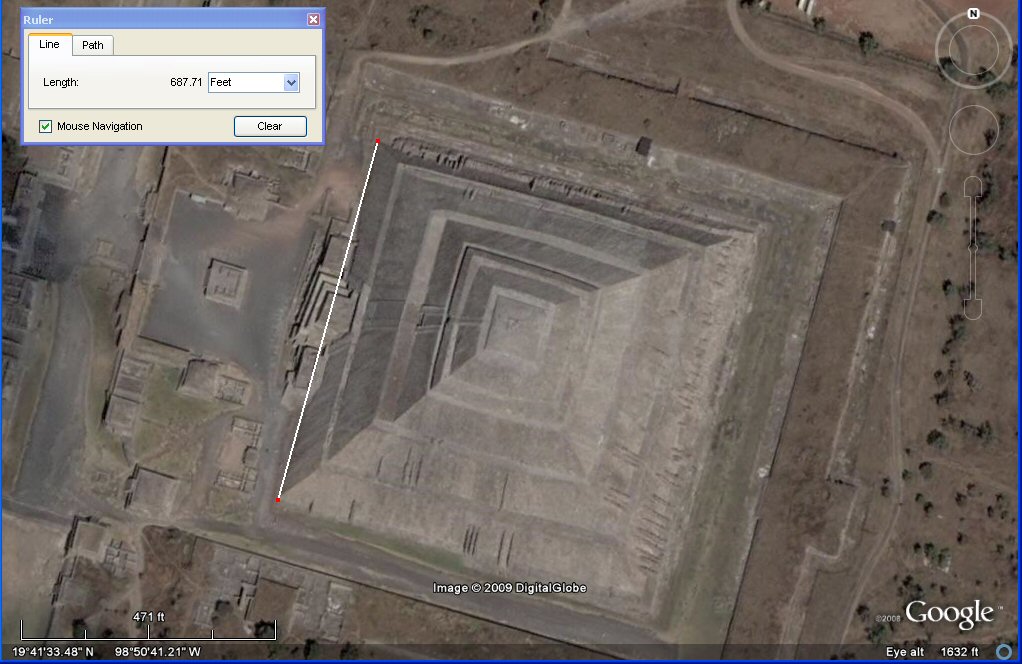


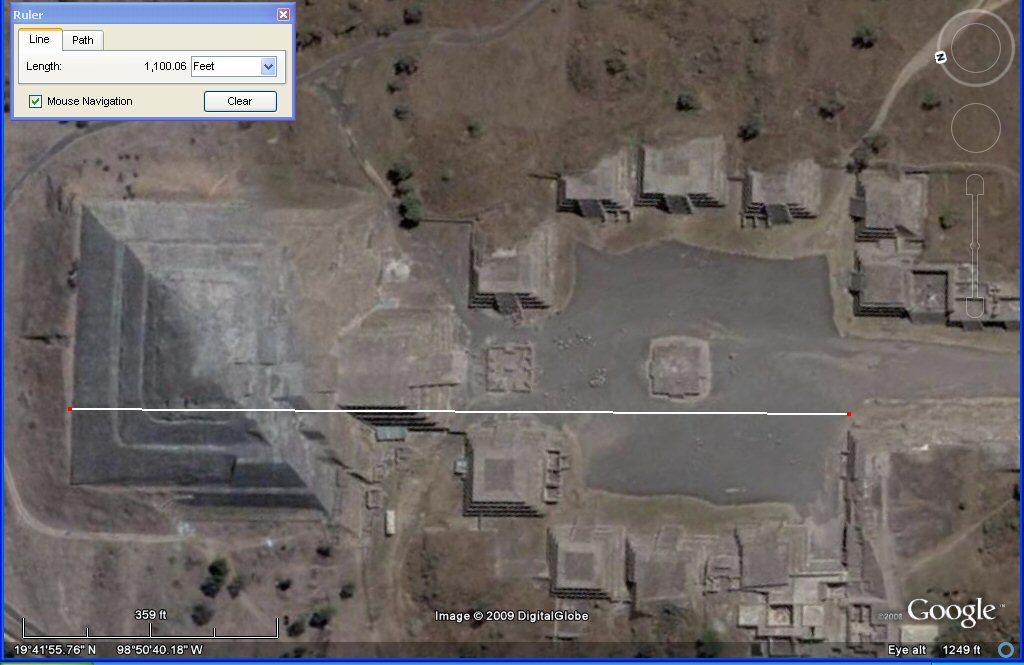
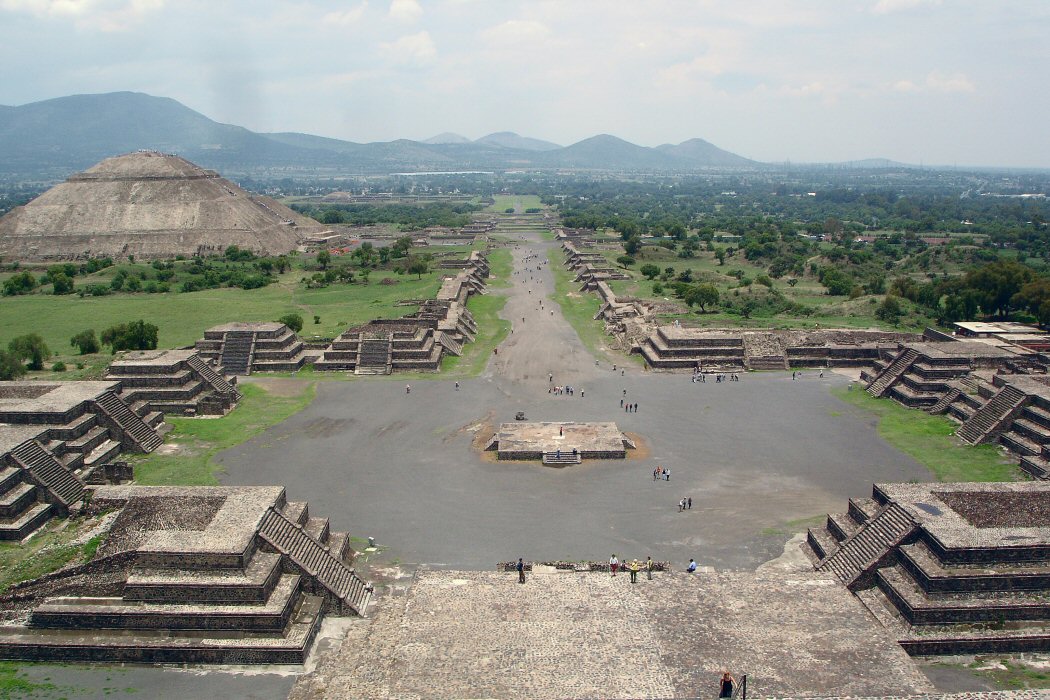
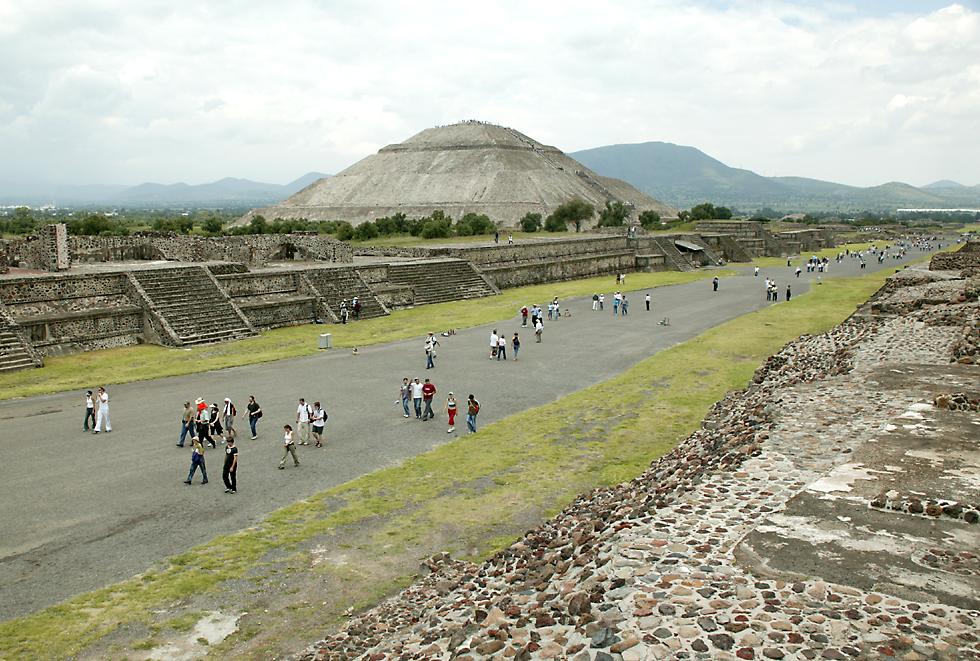
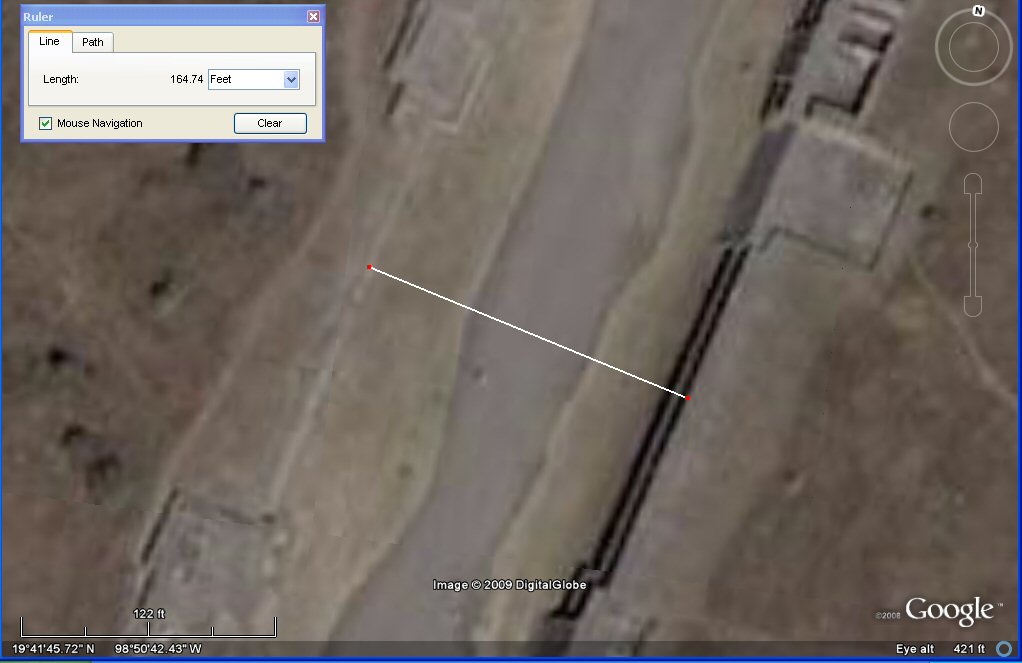

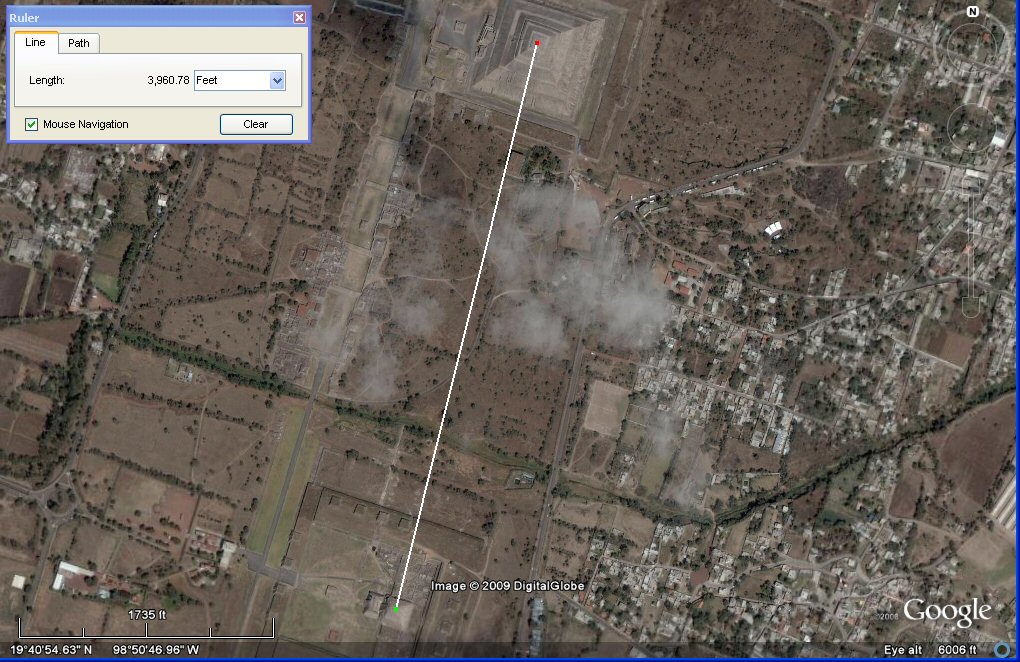
above, intended measurement 396 feet which is 360 Sumerian feet, 240 Sumerian cubits or 600 links, pyramid of the Moon.
above, this part of the pyramid measures 330 feet which is 300 Sumerian feet, 200 Sumerian cubits or 500 links, pyramid of the Moon. The pyramid has been built up in different phases, each phase enclosing an earlier phase and phase 2 dates to 150 A.D. Different measurements can also be obtained by measuring different levels or platforms of the pyramids, such as below.
The overall depth of the pyramid from back to front combined with the platform in front is quoted in "Mesoamerican Archaeology" p107 as being 168 metres. That would be equivalent to 200 Sumerian yards of 33", or 100 Sumerian "double yards" of 66" making 10,000 shusi.
The overall depth of the pyramid from back to front combined with the platform in front is quoted in "Mesoamerican Archaeology" p107 as being 168 metres. That would be equivalent to 200 Sumerian yards of 33", or 100 Sumerian "double yards" of 66" making 10,000 shusi.
above, Teotihuacan Pyramid of the Sun.
above, Teotihuacan Pyramid of the Sun
above, intended measurement 687.5 feet is 250 Sumerian yards of 33.0" (50shusi) or 260 yards of 48 shusi
or 400 Egyptian royal cubits of 20.625", pyramid of the Sun.
or 400 Egyptian royal cubits of 20.625", pyramid of the Sun.
above, intended measurement 687.5 feet is 250 Sumerian yards of 33.0" (50shusi) or 260 yards of 48 shusi
or 400 Egyptian royal cubits of 20.625", pyramid of the Sun.
The base measurement of the Sun Pyramid is quoted (Mesoamerican Archaeology) as 216 metres.
That is said to be 260 Teotihuacan units representing a 260 day calendar, it is also 260 Megalithic yards
The quoted distances of 431 metres and 432 metres are also compatible with round numbers of Megalithic yards as explained above in Mesoamerican Archaeology.
Is it possible that a site such as this could be constructed in units which reflect both Megalithic yards of 32.64" and Sumerian yards of 33.0"?
It certainly is, especially if we consider the Sun Pyramid is meant to relate to the calendar, because the megalithic yard relates to a solar year of 365.24219 days as the Sumerian yard of 33.0" relates to a mathematical year of 360 days.
Were these not indeed Lords of Time!
But it seems more probable that the site would be set out in multiples of units called Sumerian feet (of 13.2"), Sumerian cubits of 19.8" and Sumerian yards of 33.0" and when we produce a map (see below) with scales in Sumerian feet, everything seems to fall into place.
In Sumerian feet, from the front of the Moon pyramid to the nearside of the Citadel (Ciudadela) is 5,000 Sumerian feet, which would also be 2,000 Sumerian yards, 1,000 double-Sumerian yards of 100 shusi, 3,200 Egyptian royal cubits or 1600 Mayan hunabs.
From the southern side of the Sun pyramid enclosure to the near side of the citadel enclosure would be 2,400 Sumerian feet, 1,600 Sumerian cubits, 960 Sumerian yards, 480 Sumerian double-yards, 1,536 Egyptian royal cubits or 768 Mayan hunabs. So if the plan were set out in round numbers it looks like there is a greater preponderance of round numbers in "Sumerian" feet than in "Mayan hunabs", but in the end, they are all part of the same measuring system.
From the rear of the Moon pyramid to the beginning of the avenue is 1,000 Sumerian feet and so on.
or 400 Egyptian royal cubits of 20.625", pyramid of the Sun.
The base measurement of the Sun Pyramid is quoted (Mesoamerican Archaeology) as 216 metres.
That is said to be 260 Teotihuacan units representing a 260 day calendar, it is also 260 Megalithic yards
The quoted distances of 431 metres and 432 metres are also compatible with round numbers of Megalithic yards as explained above in Mesoamerican Archaeology.
Is it possible that a site such as this could be constructed in units which reflect both Megalithic yards of 32.64" and Sumerian yards of 33.0"?
It certainly is, especially if we consider the Sun Pyramid is meant to relate to the calendar, because the megalithic yard relates to a solar year of 365.24219 days as the Sumerian yard of 33.0" relates to a mathematical year of 360 days.
Were these not indeed Lords of Time!
But it seems more probable that the site would be set out in multiples of units called Sumerian feet (of 13.2"), Sumerian cubits of 19.8" and Sumerian yards of 33.0" and when we produce a map (see below) with scales in Sumerian feet, everything seems to fall into place.
In Sumerian feet, from the front of the Moon pyramid to the nearside of the Citadel (Ciudadela) is 5,000 Sumerian feet, which would also be 2,000 Sumerian yards, 1,000 double-Sumerian yards of 100 shusi, 3,200 Egyptian royal cubits or 1600 Mayan hunabs.
From the southern side of the Sun pyramid enclosure to the near side of the citadel enclosure would be 2,400 Sumerian feet, 1,600 Sumerian cubits, 960 Sumerian yards, 480 Sumerian double-yards, 1,536 Egyptian royal cubits or 768 Mayan hunabs. So if the plan were set out in round numbers it looks like there is a greater preponderance of round numbers in "Sumerian" feet than in "Mayan hunabs", but in the end, they are all part of the same measuring system.
From the rear of the Moon pyramid to the beginning of the avenue is 1,000 Sumerian feet and so on.
above, map of Teotihuacan with scale bar in Sumerian feet of 13.2".
above, the satellite confirms the map distance mentioned above, 1100 English feet is 1,000 Sumerian feet of 13.2".
Avenue of the Dead with the Sun Pyramid in the background to the left.
Avenue of the Dead with the Sun Pyramid in the background.
Avenue of the Dead satellite view.
above, Bruce Rux in "Archaeology of the Underworld" found the boulevard to be 48 hunabs wide where the hunab was 1.059 metres or 2 x Egyptian Royal Cubits.
above, Bruce Rux in "Archaeology of the Underworld" found the boulevard to be 48 hunabs wide where the hunab was 1.059 metres or 2 x Egyptian Royal Cubits.


Avenue of the Dead satellite view.
Avenue of the Dead width is 165 feet which is 100 cubits or 96 Egyptian royal cubits
(or 48 hunabs where the hunab was 2 x Egyptian Royal Cubits).
(or 48 hunabs where the hunab was 2 x Egyptian Royal Cubits).
The satellite measures the intended distance between the pyramid of the Sun and the pyramid of the Moon as 2,640 feet which would be 2400 Sumerian feet. In Sumerian units, it would also be 1600 cubits, 4000 links or 4800 shusi. In the units of Drewitt and Drucker which was 4 x links or 48 shusi, it would be 1,000 of these units, confirming that Drewitt and Drucker had made a correct assessment, but using different multiples of shusi.
The satellite measures the intended distance distance between the pyramid of the Sun and the pyramid in the Temple of Quetzalcoatl (also called the "Citadel") as 3,960 feet which would be 3600 Sumerian feet. In Sumerian units it would also be 2400 cubits, 6000 links or 72000 shusi. In the units of Drewitt and Drucker which was 4 x links or 48 shusi, it would be 1,500 of these units, confirming again that Drewitt and Drucker had made a correct assessment, but using different multiples of shusi.
Both the above distances can be more readily understood as 2400 and 3600 Sumerian feet respectively.
Teotihuacan measuring unit at the citadel
Both the above distances can be more readily understood as 2400 and 3600 Sumerian feet respectively.
Teotihuacan measuring unit at the citadel
Coordinates: 19°41′33″N 98°50′37.68″W19.6925°N 98.8438°W
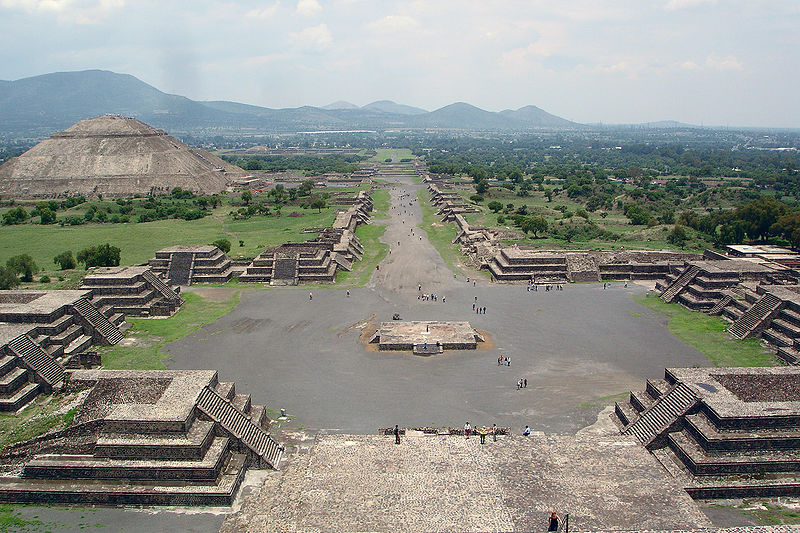
View of the Avenue of the Dead and the Pyramid of the Sun, from the Pyramid of the Moon
Country
Mexico
Type Cultural
Criteria
I, II, III, IV, VI
Region ** North America
Inscription history
Inscription 1987 (11th Session)
Mexico
Type Cultural
Criteria
I, II, III, IV, VI
Region ** North America
Inscription history
Inscription 1987 (11th Session)

The view from the Pyramid of the Sun
Teotihuacan – also written Teotihuacán, with a Spanish orthographic accent on the last syllable – is an enormous archaeological site in the Basin of Mexico, just 30 miles northeast of Mexico City, containing some of the largest pyramidal structures built in the pre-Columbian Americas. Apart from the pyramidal structures, Teotihuacan is also known for its large residential complexes, the Avenue of the Dead, and numerous colorful, well-preserved murals. Additionally, Teotihuacan produced a thin orange pottery style that spread through Mesoamerica.
The city is thought to have been established around 100 BCE and continued to be built until about 250 CE.The city may have lasted until sometime between the 7th and 8th centuries CE. At its zenith, perhaps in the first half of the 1st millennium CE, Teotihuacan was the largest city in the pre-Columbian Americas. At this time it may have had more than 200,000 inhabitants, placing it among the largest cities of the world in this period. Teotihuacan was even home to multi-floor apartment compounds built to accommodate this large population. The civilization and cultural complex associated with the site is also referred to as Teotihuacan or Teotihuacano.
Although it is a subject of debate whether Teotihuacan was the center of a state empire, its influence throughout Mesoamerica is well documented; evidence of Teotihuacano presence can be seen at numerous sites in Veracruz and the Maya region. The Aztecs may have been influenced by this city. The ethnicity of the inhabitants of Teotihuacan is also a subject of debate. Possible candidates are the Nahua, Otomi or Totonacethnic groups. Scholars have also suggested that Teotihuacan was a multiethnic state.
The city and the archaeological site are located in what is now the San Juan Teotihuacán municipality in the State of México, Mexico, approximately 40 kilometres (25 mi) northeast of Mexico City. The site covers a total surface area of 83 km² and was designated a UNESCO World Heritage Site in 1987. It is the most visited archaeological site in Mexico.
Name
The name Teōtīhuacān was given by the Nahuatl-speaking Aztec centuries after the fall of the city. The term has been glossed as "birthplace of the gods", reflecting Nahua creation myths that were said to occur in Teotihuacan. Nahuatl scholar Thelma D. Sullivan interprets the name as "place of those who have the road of the gods."
The name is pronounced Nahuatl pronunciation: [te.oːtiːˈwakaːn] in Nahuatl, with the accent on the syllable wa. By normal Nahuatl orthographic conventions, a written accent would not appear in that position. Both this pronunciation and Spanish Spanish pronunciation: [te.otiwaˈkan]
are used, and both spellings appear in this article.
Teotihuacan – also written Teotihuacán, with a Spanish orthographic accent on the last syllable – is an enormous archaeological site in the Basin of Mexico, just 30 miles northeast of Mexico City, containing some of the largest pyramidal structures built in the pre-Columbian Americas. Apart from the pyramidal structures, Teotihuacan is also known for its large residential complexes, the Avenue of the Dead, and numerous colorful, well-preserved murals. Additionally, Teotihuacan produced a thin orange pottery style that spread through Mesoamerica.
The city is thought to have been established around 100 BCE and continued to be built until about 250 CE.The city may have lasted until sometime between the 7th and 8th centuries CE. At its zenith, perhaps in the first half of the 1st millennium CE, Teotihuacan was the largest city in the pre-Columbian Americas. At this time it may have had more than 200,000 inhabitants, placing it among the largest cities of the world in this period. Teotihuacan was even home to multi-floor apartment compounds built to accommodate this large population. The civilization and cultural complex associated with the site is also referred to as Teotihuacan or Teotihuacano.
Although it is a subject of debate whether Teotihuacan was the center of a state empire, its influence throughout Mesoamerica is well documented; evidence of Teotihuacano presence can be seen at numerous sites in Veracruz and the Maya region. The Aztecs may have been influenced by this city. The ethnicity of the inhabitants of Teotihuacan is also a subject of debate. Possible candidates are the Nahua, Otomi or Totonacethnic groups. Scholars have also suggested that Teotihuacan was a multiethnic state.
The city and the archaeological site are located in what is now the San Juan Teotihuacán municipality in the State of México, Mexico, approximately 40 kilometres (25 mi) northeast of Mexico City. The site covers a total surface area of 83 km² and was designated a UNESCO World Heritage Site in 1987. It is the most visited archaeological site in Mexico.
Name
The name Teōtīhuacān was given by the Nahuatl-speaking Aztec centuries after the fall of the city. The term has been glossed as "birthplace of the gods", reflecting Nahua creation myths that were said to occur in Teotihuacan. Nahuatl scholar Thelma D. Sullivan interprets the name as "place of those who have the road of the gods."
The name is pronounced Nahuatl pronunciation: [te.oːtiːˈwakaːn] in Nahuatl, with the accent on the syllable wa. By normal Nahuatl orthographic conventions, a written accent would not appear in that position. Both this pronunciation and Spanish Spanish pronunciation: [te.otiwaˈkan]
are used, and both spellings appear in this article.
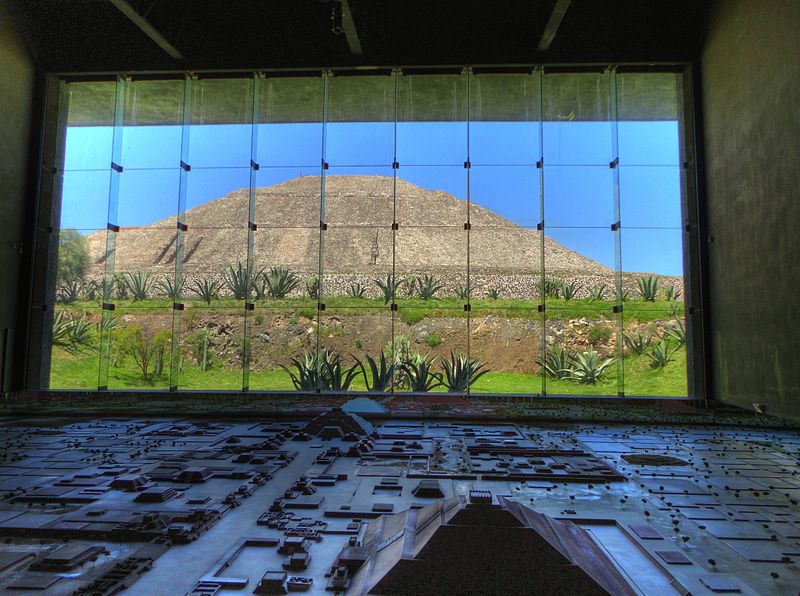
Sun Pyramid and the Teotihuacán Diorama at the Teotihuacán Museum.
The original name of the city is unknown, but it appears in hieroglyphic texts from the Maya region as puh, or "Place of Reeds". This suggests that the Maya of the Classic period understood Teotihuacan as a Place of Reeds similar to other Postclassic Central Mexican settlements that took the name Tollan, such as Tula-Hidalgo and Cholula. This naming convention led to much confusion in the early 20th century, as scholars debated whether Teotihuacan or Tula-Hidalgo was the Tollan described by 16th–century chronicles. It now seems clear that Tollan may be understood as a generic Nahua term applied to any large settlement. In the Mesoamerican concept of urbanism, Tollan and other language equivalents serve as a . metaphor, linking the bundles of reeds and rushes that formed part of the lacustrine environment of the Valley of Mexico and the large gathering of people in a city .
The original name of the city is unknown, but it appears in hieroglyphic texts from the Maya region as puh, or "Place of Reeds". This suggests that the Maya of the Classic period understood Teotihuacan as a Place of Reeds similar to other Postclassic Central Mexican settlements that took the name Tollan, such as Tula-Hidalgo and Cholula. This naming convention led to much confusion in the early 20th century, as scholars debated whether Teotihuacan or Tula-Hidalgo was the Tollan described by 16th–century chronicles. It now seems clear that Tollan may be understood as a generic Nahua term applied to any large settlement. In the Mesoamerican concept of urbanism, Tollan and other language equivalents serve as a . metaphor, linking the bundles of reeds and rushes that formed part of the lacustrine environment of the Valley of Mexico and the large gathering of people in a city .
HISTORY
Teotihuacan and other important Classic Era settlements
Origins and foundation
The early history of Teotihuacan is quite mysterious, and the origin of its founders is debated. For many years, archaeologists believed it was built by the Toltec. This belief was based on colonial period texts, such as the Florentine Codex, which attributed the site to the Toltecs. However, the Nahuatl word "Toltec" generally means "craftsman of the highest level" and may not always refer to the Toltec civilization centered at Tula, Hidalgo. Since Toltec civilization flourished centuries after Teotihuacan, the people could not have been the city's founders.
In the Late Formative period, a number of urban centers arose in central Mexico. The most prominent of these appears to have been Cuicuilco, on the southern shore of Lake Texcoco. Scholars have speculated that the eruption of the Xitle volcano may have prompted a mass emigration out of the central valley and into the Teotihuacan valley. These settlers may have founded and/or accelerated the growth of Teotihuacan.
Other scholars have put forth the Totonac people as the founders of Teotihuacan. There is evidence that at least some of the people living in Teotihuacan came from areas influenced by the Teotihuacano civilization, including the Zapotec, Mixtec and Maya peoples. The culture and architecture of Teotihuacan was influenced by the Olmec people, who are considered to be the "mother civilization" of Mesoamerica.[citation needed]
The earliest buildings at Teotihuacan date to about 200 BCE. The largest pyramid, the Pyramid of the Sun, was completed by 100 CE.
Zenith
The city reached its peak in 450 CE, when it was the center of a powerful culture whose influence extended through much of the Mesoamerican region. At its peak, the city covered over 30 km² (over 11½ square miles), and probably housed a population of over 150,000 people, possibly as many as 250,000. Various districts in the city housed people from across the Teotihuacano region of influence, which spread south as far as Guatemala.Notably absent from the city are fortifications and military structures.
Origins and foundation
The early history of Teotihuacan is quite mysterious, and the origin of its founders is debated. For many years, archaeologists believed it was built by the Toltec. This belief was based on colonial period texts, such as the Florentine Codex, which attributed the site to the Toltecs. However, the Nahuatl word "Toltec" generally means "craftsman of the highest level" and may not always refer to the Toltec civilization centered at Tula, Hidalgo. Since Toltec civilization flourished centuries after Teotihuacan, the people could not have been the city's founders.
In the Late Formative period, a number of urban centers arose in central Mexico. The most prominent of these appears to have been Cuicuilco, on the southern shore of Lake Texcoco. Scholars have speculated that the eruption of the Xitle volcano may have prompted a mass emigration out of the central valley and into the Teotihuacan valley. These settlers may have founded and/or accelerated the growth of Teotihuacan.
Other scholars have put forth the Totonac people as the founders of Teotihuacan. There is evidence that at least some of the people living in Teotihuacan came from areas influenced by the Teotihuacano civilization, including the Zapotec, Mixtec and Maya peoples. The culture and architecture of Teotihuacan was influenced by the Olmec people, who are considered to be the "mother civilization" of Mesoamerica.[citation needed]
The earliest buildings at Teotihuacan date to about 200 BCE. The largest pyramid, the Pyramid of the Sun, was completed by 100 CE.
Zenith
The city reached its peak in 450 CE, when it was the center of a powerful culture whose influence extended through much of the Mesoamerican region. At its peak, the city covered over 30 km² (over 11½ square miles), and probably housed a population of over 150,000 people, possibly as many as 250,000. Various districts in the city housed people from across the Teotihuacano region of influence, which spread south as far as Guatemala.Notably absent from the city are fortifications and military structures.
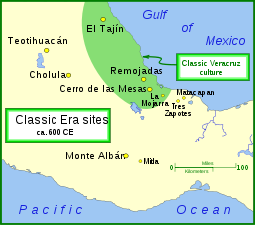
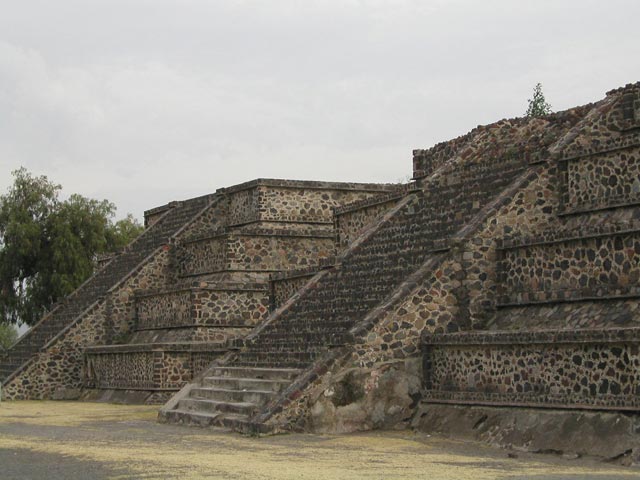
Platform along the Avenue of the Dead showing the talud-tablero architectural style
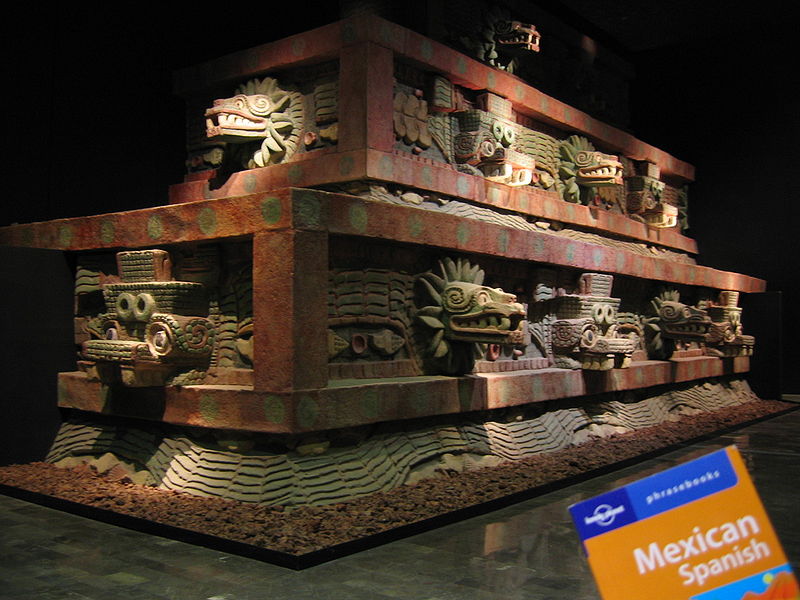
Restored partion of Teotihucan architecture showing the typical Mesoamerican use of red paint complemented on gold and jade decoration upon marble and granite.
The nature of political and cultural interactions between Teotihuacan and the centers of the Maya region (as well as elsewhere in Mesoamerica) has been a long-standing and significant area for debate. Substantial exchange and interaction occurred over the centuries from the Terminal Preclassic to the Mid-Classic period. "Teotihuacan-inspired ideologies" and motifs persisted at Maya centers into the Late Classic, long after Teotihuacan itself had declined. However, scholars debate the extent and degree of Teotihuacano influence. Some believe that it had direct and militaristic dominance; others that adoption of "foreign" traits was part of a selective, conscious and bi-directional cultural diffusion. New discoveries have suggested that Teotihuacan was not much different in its interactions with other centers from the later empires, such as the Toltec and Aztec. It is believed that Teotihuacan had a major influence on the Preclassic and Classic Maya, most likely by conquering several Maya centers and regions, including Tikal and the region of Peten, and influencing Maya culture.
Architectural styles prominent at Teotihuacan are found widely dispersed at a number of distant Mesoamerican sites, which some researchers have interpreted as evidence for Teotihuacan's far-reaching interactions and political or militaristic dominance. A style particularly associated with Teotihuacan is known as cultural diffusionin which an inwards-sloping external side of a structure (talud) is surmounted by a rectangular panel (tablero). Variants of the generic style are found in a number of Maya region sites, cultural diffusionthe Preclassic. Analyses have traced the development into local variants of the talud-tablero style at sites such as Tikal, where its use precedes the 5th-century appearance of iconographic motifs shared with Teotihuacan. The talud-tablero style disseminated through Mesoamerica generally from the end of the Preclassic period, and not specifically, or only, via Teotihuacano influence. It is unclear how or from where the style spread into the Maya region.
The city was a center of industry, home to many potters, jewelers and craftsmen. Teotihuacan is known for producing a great number of obsidian artifacts. No ancient Teotihuacano non-.ideographic texts are known to exist (or known to have existed). Inscriptions from Maya cities show that Teotihuacan nobility traveled to, and perhaps conquered, local rulers as far away as Honduras. Maya inscriptions note an individual nicknamed by scholars as "Spearthrower Owl", apparently ruler of Teotihuacan, who reigned for over 60 years and installed his relatives as rulers of Tikal and Uaxactun in Guatemala
The nature of political and cultural interactions between Teotihuacan and the centers of the Maya region (as well as elsewhere in Mesoamerica) has been a long-standing and significant area for debate. Substantial exchange and interaction occurred over the centuries from the Terminal Preclassic to the Mid-Classic period. "Teotihuacan-inspired ideologies" and motifs persisted at Maya centers into the Late Classic, long after Teotihuacan itself had declined. However, scholars debate the extent and degree of Teotihuacano influence. Some believe that it had direct and militaristic dominance; others that adoption of "foreign" traits was part of a selective, conscious and bi-directional cultural diffusion. New discoveries have suggested that Teotihuacan was not much different in its interactions with other centers from the later empires, such as the Toltec and Aztec. It is believed that Teotihuacan had a major influence on the Preclassic and Classic Maya, most likely by conquering several Maya centers and regions, including Tikal and the region of Peten, and influencing Maya culture.
Architectural styles prominent at Teotihuacan are found widely dispersed at a number of distant Mesoamerican sites, which some researchers have interpreted as evidence for Teotihuacan's far-reaching interactions and political or militaristic dominance. A style particularly associated with Teotihuacan is known as cultural diffusionin which an inwards-sloping external side of a structure (talud) is surmounted by a rectangular panel (tablero). Variants of the generic style are found in a number of Maya region sites, cultural diffusionthe Preclassic. Analyses have traced the development into local variants of the talud-tablero style at sites such as Tikal, where its use precedes the 5th-century appearance of iconographic motifs shared with Teotihuacan. The talud-tablero style disseminated through Mesoamerica generally from the end of the Preclassic period, and not specifically, or only, via Teotihuacano influence. It is unclear how or from where the style spread into the Maya region.
The city was a center of industry, home to many potters, jewelers and craftsmen. Teotihuacan is known for producing a great number of obsidian artifacts. No ancient Teotihuacano non-.ideographic texts are known to exist (or known to have existed). Inscriptions from Maya cities show that Teotihuacan nobility traveled to, and perhaps conquered, local rulers as far away as Honduras. Maya inscriptions note an individual nicknamed by scholars as "Spearthrower Owl", apparently ruler of Teotihuacan, who reigned for over 60 years and installed his relatives as rulers of Tikal and Uaxactun in Guatemala
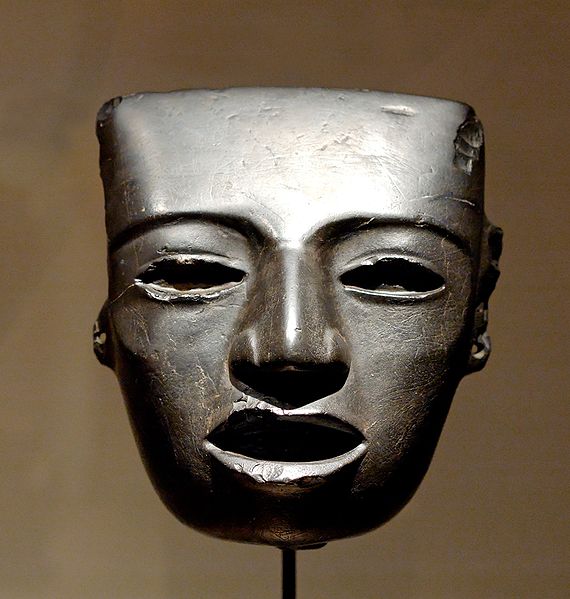
Stone mask discovered at Teotihuacan, 3rd to 7th century CE.
Scholars have based interpretations about the culture at Teotihuacan on archaeology, the murals that adorn the site (and others, like the Wagner Murals, found in private collections), and hieroglyphic inscriptions made by the Maya describing their encounters with Teotihuacano conquerors. The creation of murals, perhaps tens of thousands of murals, reached its height between 450 and 650 CE. The painters' artistry was unrivaled in Mesoamerica. It has been compared with those of painters in Renaissance Florence, Italy.
Collapse
Scholars had thought that invaders attacked the city in the 7th or 8th century, sacking and burning it. More recent evidence, however, seems to indicate that the burning was limited to the structures and dwellings associated primarily with the elite class. Some think this suggests that the burning was from an internal uprising. They say the invasion theory is flawed because early archaeological work on the city was focused exclusively on the palaces and temples, places used by the elites. Because all of these sites showed burning, archaeologists concluded that the whole city was burned. Instead, it is now known that the destruction was centered on major civic structures along the Avenue of the Dead. Some statues seem to have been destroyed in a methodical way, with their fragments dispersed.
Evidence for population decline beginning around the 6th century lends some support to the internal unrest hypothesis. The decline of Teotihuacan has been correlated to lengthy droughts related to the climate changes of 535-536 CE. This theory of ecological decline is supported by archaeological remains that show a rise in the percentage of juvenile skeletons with evidence of malnutrition during the 6th century. This finding does not conflict with either of the above theories, since both increased warfare and internal unrest can also be effects of a general period of drought and famine. Other nearby centers such as Cholula, Xochicalco, and Cacaxtla competed to fill the power void left by Teotihuacan's decline. They may have aligned themselves against Teotihuacan to reduce its influence and power. The art and architecture at these sites emulates Teotihuacan forms, but also demonstrates an eclectic mix of motifs and iconography from other parts of Mesoamerica, particularly the Maya region.
Teotihuacan culture
Ethnicity
Archaeological evidence suggests that Teotihuacan was a multi-ethnic city, with distinct quarters occupied by Otomi, Zapotec, Mixtec, Maya and Nahua peoples. The Totonacs have always maintained that they were the ones who built it. The Aztecs repeated that story, but it has not been corroborated by archaeological findings.
Scholars have based interpretations about the culture at Teotihuacan on archaeology, the murals that adorn the site (and others, like the Wagner Murals, found in private collections), and hieroglyphic inscriptions made by the Maya describing their encounters with Teotihuacano conquerors. The creation of murals, perhaps tens of thousands of murals, reached its height between 450 and 650 CE. The painters' artistry was unrivaled in Mesoamerica. It has been compared with those of painters in Renaissance Florence, Italy.
Collapse
Scholars had thought that invaders attacked the city in the 7th or 8th century, sacking and burning it. More recent evidence, however, seems to indicate that the burning was limited to the structures and dwellings associated primarily with the elite class. Some think this suggests that the burning was from an internal uprising. They say the invasion theory is flawed because early archaeological work on the city was focused exclusively on the palaces and temples, places used by the elites. Because all of these sites showed burning, archaeologists concluded that the whole city was burned. Instead, it is now known that the destruction was centered on major civic structures along the Avenue of the Dead. Some statues seem to have been destroyed in a methodical way, with their fragments dispersed.
Evidence for population decline beginning around the 6th century lends some support to the internal unrest hypothesis. The decline of Teotihuacan has been correlated to lengthy droughts related to the climate changes of 535-536 CE. This theory of ecological decline is supported by archaeological remains that show a rise in the percentage of juvenile skeletons with evidence of malnutrition during the 6th century. This finding does not conflict with either of the above theories, since both increased warfare and internal unrest can also be effects of a general period of drought and famine. Other nearby centers such as Cholula, Xochicalco, and Cacaxtla competed to fill the power void left by Teotihuacan's decline. They may have aligned themselves against Teotihuacan to reduce its influence and power. The art and architecture at these sites emulates Teotihuacan forms, but also demonstrates an eclectic mix of motifs and iconography from other parts of Mesoamerica, particularly the Maya region.
Teotihuacan culture
Ethnicity
Archaeological evidence suggests that Teotihuacan was a multi-ethnic city, with distinct quarters occupied by Otomi, Zapotec, Mixtec, Maya and Nahua peoples. The Totonacs have always maintained that they were the ones who built it. The Aztecs repeated that story, but it has not been corroborated by archaeological findings.
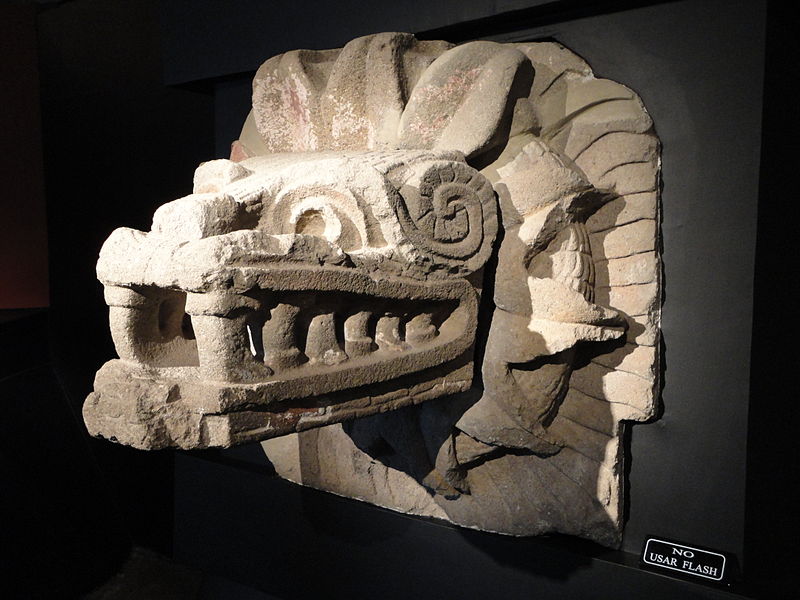
A detail found on the Quetzalcóatl Pyramid on the Ciudadela, now displayed at the Teotihuacán Museum.
In 2001 , Terrence Kaufman presented linguistic evidence suggesting that an important ethnic group in Teotihuacan was of Totonacan and/or Mixe–Zoquean linguistic affiliation. He uses this to explain general influences from Totonacan and Mixe–Zoquean languages in many other Mesoamerican languages, whose people did not have any known history of contact with either of the above-mentioned groups. Other scholars maintain that the largest population group must have been of Otomi ethnicity, because the Otomi language is known to have been spoken in the area around Teotihuacan both before and after the classic period and not during the midddle period. Religion
The religion of Teotihuacan was similar to that of other Mesoamerican cultures. Many of the same gods were worshiped, including the Feathered Serpent (the Aztecs' Quetzalcoatl) and Rain God (the Aztecs' Tlaloc.) The dominant civic architecture is the pyramid. Politics were based on the state religion; religious leaders were the political leaders.
Teotihuacanos practiced human sacrifice: human bodies and animal sacrifices have been found during excavations of the pyramids at Teotihuacan. Scholars believe that the people offered human sacrifices as part of a dedication when buildings were expanded or constructed. The victims were probably enemy warriors captured in battle and brought to the city for ritual sacrifice to ensure the city could prosper. Some men were decapitated, some had their hearts removed, others were killed by being hit several times over the head, and some were buried alive. Animals that were considered sacred and represented mythical powers and military were also buried alive, imprisoned in cages: cougars, a wolf, eagles, a falcon, an owl, and even venomous snakes.
Residency
Teotihuacan was a mix of residential and work areas. Elite homes were usually compounds which housed multiple elite families (one home was found that was capable of housing 60-100 families). Elite residences were typically made of plaster, each wall in every section elaborately decorated with murals. These compounds or apartment complexes were typically found within the city center. Different sections of the city housed particular ethnic groups and immigrants. These areas are called barrios, meaning neighborhoods. Typically, these sections of the city were speaking multiple languages.
Archaeological site
Knowledge of the huge ruins of Teotihuacan was never completely lost. After the fall of the city, various squatters lived on the site. During Aztec times, the city was a place of pilgrimage and identified with the myth of Tollan, the place where the sun was created. Teotihuacan astonished the Spanish conquistadoresduring the post-conquest era. Today Teotihuacan is one of the most noted archaeological attractions in Mexico.
Excavations and investigations
In the late 17th century Carlos de Sigüenza y Góngora (1645–1700) did some excavations around the Pyramid of the Sun. Minor archaeological excavations were conducted in the 19th century. In 1905 archaeologist Leopoldo Batres (es:Leopoldo Batres) led a major project of excavation and restoration. The Pyramid of the Sun was restored to celebrate the centennial of Mexican War of Independence in 1910. Excavations at the Ciudadela were carried out in the 1920s, supervised by Manuel Gamio. Other sections of the site were excavated in the 1940s and 50s. The first site-wide project of restoration and excavation was carried out by INAH from 1960–65 and supervised by Jorge Acosta. This undertaking had the goals of clearing the Avenue of the Dead, consolidating the structures facing it, and excavating the Palace of Quetzalpapalotl .
During the installation of a "sound and light" show in 1971, workers discovered the entrance to a tunnel and cave system underneath the Pyramid of the Sun. Although scholars long thought it to be a natural cave, more recent examinations have established the tunnel was entirely manmade. The interior of Pyramid of the Sun has never been fully excavated.
In 1980-1982, another major program of excavation and restoration was carried out at the Pyramid of the Feathered Serpent and the Avenue of the Dead complex. Most recently a series of excavations at the Pyramid of the Moon have greatly expanded evidence of cultural practices.
In 2001 , Terrence Kaufman presented linguistic evidence suggesting that an important ethnic group in Teotihuacan was of Totonacan and/or Mixe–Zoquean linguistic affiliation. He uses this to explain general influences from Totonacan and Mixe–Zoquean languages in many other Mesoamerican languages, whose people did not have any known history of contact with either of the above-mentioned groups. Other scholars maintain that the largest population group must have been of Otomi ethnicity, because the Otomi language is known to have been spoken in the area around Teotihuacan both before and after the classic period and not during the midddle period. Religion
The religion of Teotihuacan was similar to that of other Mesoamerican cultures. Many of the same gods were worshiped, including the Feathered Serpent (the Aztecs' Quetzalcoatl) and Rain God (the Aztecs' Tlaloc.) The dominant civic architecture is the pyramid. Politics were based on the state religion; religious leaders were the political leaders.
Teotihuacanos practiced human sacrifice: human bodies and animal sacrifices have been found during excavations of the pyramids at Teotihuacan. Scholars believe that the people offered human sacrifices as part of a dedication when buildings were expanded or constructed. The victims were probably enemy warriors captured in battle and brought to the city for ritual sacrifice to ensure the city could prosper. Some men were decapitated, some had their hearts removed, others were killed by being hit several times over the head, and some were buried alive. Animals that were considered sacred and represented mythical powers and military were also buried alive, imprisoned in cages: cougars, a wolf, eagles, a falcon, an owl, and even venomous snakes.
Residency
Teotihuacan was a mix of residential and work areas. Elite homes were usually compounds which housed multiple elite families (one home was found that was capable of housing 60-100 families). Elite residences were typically made of plaster, each wall in every section elaborately decorated with murals. These compounds or apartment complexes were typically found within the city center. Different sections of the city housed particular ethnic groups and immigrants. These areas are called barrios, meaning neighborhoods. Typically, these sections of the city were speaking multiple languages.
Archaeological site
Knowledge of the huge ruins of Teotihuacan was never completely lost. After the fall of the city, various squatters lived on the site. During Aztec times, the city was a place of pilgrimage and identified with the myth of Tollan, the place where the sun was created. Teotihuacan astonished the Spanish conquistadoresduring the post-conquest era. Today Teotihuacan is one of the most noted archaeological attractions in Mexico.
Excavations and investigations
In the late 17th century Carlos de Sigüenza y Góngora (1645–1700) did some excavations around the Pyramid of the Sun. Minor archaeological excavations were conducted in the 19th century. In 1905 archaeologist Leopoldo Batres (es:Leopoldo Batres) led a major project of excavation and restoration. The Pyramid of the Sun was restored to celebrate the centennial of Mexican War of Independence in 1910. Excavations at the Ciudadela were carried out in the 1920s, supervised by Manuel Gamio. Other sections of the site were excavated in the 1940s and 50s. The first site-wide project of restoration and excavation was carried out by INAH from 1960–65 and supervised by Jorge Acosta. This undertaking had the goals of clearing the Avenue of the Dead, consolidating the structures facing it, and excavating the Palace of Quetzalpapalotl .
During the installation of a "sound and light" show in 1971, workers discovered the entrance to a tunnel and cave system underneath the Pyramid of the Sun. Although scholars long thought it to be a natural cave, more recent examinations have established the tunnel was entirely manmade. The interior of Pyramid of the Sun has never been fully excavated.
In 1980-1982, another major program of excavation and restoration was carried out at the Pyramid of the Feathered Serpent and the Avenue of the Dead complex. Most recently a series of excavations at the Pyramid of the Moon have greatly expanded evidence of cultural practices.
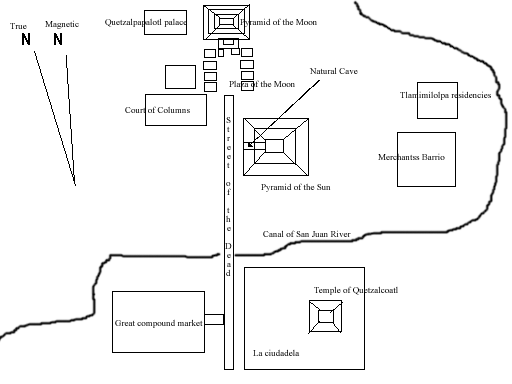
The layout of the city
Site layout
The city's broad centralavenue, called "Avenue of the Dead" (a translation from its Nahuatl name Miccoatli), is flanked by impressive ceremonial architecture, including the immense Pyramid of the Sun (second largest in the New World after the Great Pyramid of Cholula) and the Pyramid of the Moon . Along the Avenue of the Dead are many smaller talud-tablero platforms. The Aztecs believed they were tombs, inspiring the name of the avenue. Now scholars have established these were ceremonial platforms that were topped with temples.
Further down the Avenue of the Dead is the area known as the Citadel, containing the ruined Temple of the Feathered Serpent. This area was a large plaza surrounded by temples that formed the religious and political center of the city. The name "Citadel" was given to it by the Spanish, who believed it was a fort. Most of the common people lived in large apartment buildings spread across the city. Many of the buildings contained workshops where artisans produced pottery and other goods.
The geographical layout of Teotihuacan is a good example of the Mesoamerican tradition of planning cities,settlements and buildings as a representation of the view of the Universe. Its urban grid is aligned to precisely 15.5º east of North. One theory says this is due to the fact that the sun rose at that same angle during the same summer day each year. Settlers used the alignment to calibrate their sense of time or as a marker for planting crops or performing certain rituals. Another theory is that there are numerous ancient sites in Mesoamerica that seem to be oriented with the tallest mountain in their given area. This appears to be the case at Teotihuacan, although the mountain to which it is oriented is not visible from within the Teotihuacan complex due to a closer mountain ridge. Pecked-cross circles throughout the city and in the surrounding regions indicate how the people managed to maintain the urban grid over long distances. It also enabled them to orient the Pyramids to the distant mountain that was out of sight.
The Ciudadela was completed during the Miccaotli phase and the Pyramid of the Sun underwent a complex series of additions and renovations. The Great Compound was constructed across the Avenue of the Dead, west of Ciudadela. This was probably the city’s marketplace. The existence of a large market in an urban center of this size is strong evidence of state organization. Teotihuacan was by now simply too large and too complex to have been politically viable as a chiefdom.
The Ciudadela is a great enclosed compound capable of holding 100,000 people. About 700,000 cubic meters (yards) of material was used to construct its buildings. Its central feature is the Temple of Quetzalcoatl, which was flanked by elite apartments. The entire compound was designed to overwhelm visitors.
Threat from development
The archaeological park of Teotihuacan is under threat from development pressures. In 2004, the governor of Mexico state, Arturo Montiel, gave permission for Wal-Mart to build a large store in the third archaeological zone of the park. According to Counterpunch.org, "[P]riceless artifacts uncovered during store construction were reportedly trucked off to a local dump and workers fired when they revealed the carnage to the press." This is aboulute bullshit how could anyone let a power hunary corporation like wal-scum to do such a thing? Can you say pay off? This land has so much importance who and what evil overwhlemed these greedy humans into destroying such artifacts. Pure ingornace and greed. They should be prosecuted and put in jail for life.
Site layout
The city's broad centralavenue, called "Avenue of the Dead" (a translation from its Nahuatl name Miccoatli), is flanked by impressive ceremonial architecture, including the immense Pyramid of the Sun (second largest in the New World after the Great Pyramid of Cholula) and the Pyramid of the Moon . Along the Avenue of the Dead are many smaller talud-tablero platforms. The Aztecs believed they were tombs, inspiring the name of the avenue. Now scholars have established these were ceremonial platforms that were topped with temples.
Further down the Avenue of the Dead is the area known as the Citadel, containing the ruined Temple of the Feathered Serpent. This area was a large plaza surrounded by temples that formed the religious and political center of the city. The name "Citadel" was given to it by the Spanish, who believed it was a fort. Most of the common people lived in large apartment buildings spread across the city. Many of the buildings contained workshops where artisans produced pottery and other goods.
The geographical layout of Teotihuacan is a good example of the Mesoamerican tradition of planning cities,settlements and buildings as a representation of the view of the Universe. Its urban grid is aligned to precisely 15.5º east of North. One theory says this is due to the fact that the sun rose at that same angle during the same summer day each year. Settlers used the alignment to calibrate their sense of time or as a marker for planting crops or performing certain rituals. Another theory is that there are numerous ancient sites in Mesoamerica that seem to be oriented with the tallest mountain in their given area. This appears to be the case at Teotihuacan, although the mountain to which it is oriented is not visible from within the Teotihuacan complex due to a closer mountain ridge. Pecked-cross circles throughout the city and in the surrounding regions indicate how the people managed to maintain the urban grid over long distances. It also enabled them to orient the Pyramids to the distant mountain that was out of sight.
The Ciudadela was completed during the Miccaotli phase and the Pyramid of the Sun underwent a complex series of additions and renovations. The Great Compound was constructed across the Avenue of the Dead, west of Ciudadela. This was probably the city’s marketplace. The existence of a large market in an urban center of this size is strong evidence of state organization. Teotihuacan was by now simply too large and too complex to have been politically viable as a chiefdom.
The Ciudadela is a great enclosed compound capable of holding 100,000 people. About 700,000 cubic meters (yards) of material was used to construct its buildings. Its central feature is the Temple of Quetzalcoatl, which was flanked by elite apartments. The entire compound was designed to overwhelm visitors.
Threat from development
The archaeological park of Teotihuacan is under threat from development pressures. In 2004, the governor of Mexico state, Arturo Montiel, gave permission for Wal-Mart to build a large store in the third archaeological zone of the park. According to Counterpunch.org, "[P]riceless artifacts uncovered during store construction were reportedly trucked off to a local dump and workers fired when they revealed the carnage to the press." This is aboulute bullshit how could anyone let a power hunary corporation like wal-scum to do such a thing? Can you say pay off? This land has so much importance who and what evil overwhlemed these greedy humans into destroying such artifacts. Pure ingornace and greed. They should be prosecuted and put in jail for life.

The Ciudadela, on the opposite side from the Pyramid of the Moon
More recentlyTeotihuacan has become the center of controversy over Resplandor Teotihuacano, a proposed massive light and sound spectacular, which, according to Statesman.com"includes large metallic structures, 2,500 lights and three kilometers of cables."
More recentlyTeotihuacan has become the center of controversy over Resplandor Teotihuacano, a proposed massive light and sound spectacular, which, according to Statesman.com"includes large metallic structures, 2,500 lights and three kilometers of cables."

360° View of the Avenue of the Dead, the Pyramid of the Sun and the Pyramid of the Moon

Panoramic view from the summit of the Pyramid of the Sun, with the Pyramid of the Moonon the far right
TEOTIHUACAN MURAL ART
One of the impressive features of Teotihuacan is the polychrome mural art, some surprisingly well preserved. The mural art constitutes a significant data source with respect to Teotihuacan culture. Mural painting and ceramics are the principal surviving art forms at Teotihuacan, and murals are an important aspect of its architecture. The great number of known murals at Teotihuacan is illustrative of their importance. Most of the murals were painted on a plaster medium, a medium with good preservation, with a true fresco technique (Littmann 1973:175). Due to their greater preservation, paintings from lower walls are better known.
TEOTIHUACAN MURAL ART
One of the impressive features of Teotihuacan is the polychrome mural art, some surprisingly well preserved. The mural art constitutes a significant data source with respect to Teotihuacan culture. Mural painting and ceramics are the principal surviving art forms at Teotihuacan, and murals are an important aspect of its architecture. The great number of known murals at Teotihuacan is illustrative of their importance. Most of the murals were painted on a plaster medium, a medium with good preservation, with a true fresco technique (Littmann 1973:175). Due to their greater preservation, paintings from lower walls are better known.
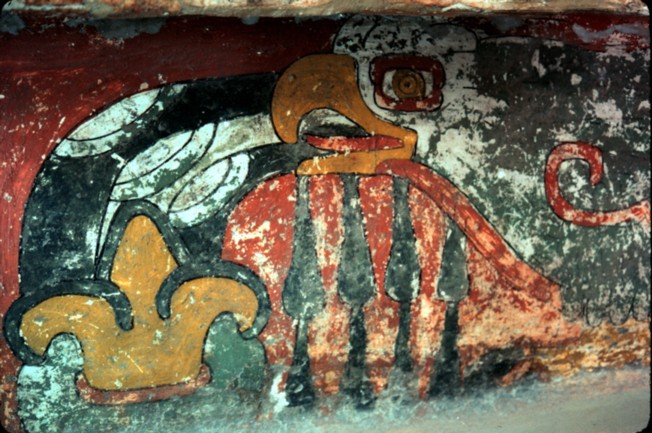
Teotihuacan mural art is characterizable as pictographic visual communication. There is a great diversity in the complexity and kinds of signs used in the mural art, varying from naturalistic to geometrical, to abstract. Depictions include quetzals, jaguars, doves, fish, felines, serpents, shelled animals, shells, sea creatures, water lilies, and seeds. Flowers, shells, and feathers abound, as does the depiction of humans, animals, and compound forms, while utilitarian objects and domestic scenes are rare (Langley 1986:31). The art includes stylized representations based on living organisms found in the natural world. Anthropomorphs and animals can be composites and there are also compound forms with no actual correspondence to nature. Many signs are surrounded by concentric borders and create the effect of cartouches.
Some pictographic signs represent natural objects and function nominatively while others are associated with activities. In the Temple of Agriculture mural small human figures are depicted presenting items to two composite mountain-platform forms which are anthropomorphized with earplugs, necklaces and nose plugs. Settings such as this have been interpreted as ceremonial and ritualistic. Other murals have a playful quality.
Some pictographic signs represent natural objects and function nominatively while others are associated with activities. In the Temple of Agriculture mural small human figures are depicted presenting items to two composite mountain-platform forms which are anthropomorphized with earplugs, necklaces and nose plugs. Settings such as this have been interpreted as ceremonial and ritualistic. Other murals have a playful quality.
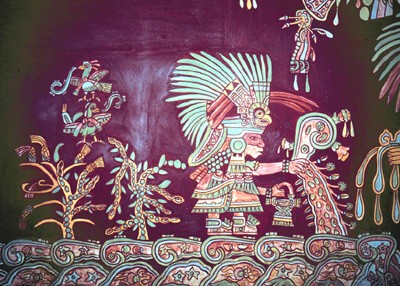
Tepantitla recreation in the National Museum of Anthropolgy, Mexico, D.F.
Sound scrolls, from simple spirals to complex compound scrolls with bordering and enclosed signs, emanate from beings and natural objects, including shells. Streaming motifs, decorated like the sound scrolls, emanate from the mouths of creatures and fall from the hands of people and anthropomorphic forms. Insignia such as rattles, bags, standards, headdresses and shields are used in the composition of anthropomorphic forms. Individual attributes such as rank, function, and affiliation may have been recorded, and persons and places were probably named (Langley 1986:174).
The Great Goddess of Teotihuacan (or Teotihuacan Spider Woman) is a proposed goddess of the pre-Columbian Teotihuacan civilization, in what is now Mexico.
==Didgure.[1] Pasztory concluded that the figures represented a vegetation and fertility goddess that was a predecessor of the much later Aztec goddess Xochiquetzal. In 1983, Karl Taube christened this goddess the "Teotihuacan Spider Woman". The more neutral description of this deity as the "Great Goddess" has since gained currency.
The Great Goddess has since been identified at locations other than Tepantitla – including Teotihuacan's Tetitla
compound (see photo below), the Palace of the Jaguars, and the Temple of Agriculture – as well as on several vessel.
Sound scrolls, from simple spirals to complex compound scrolls with bordering and enclosed signs, emanate from beings and natural objects, including shells. Streaming motifs, decorated like the sound scrolls, emanate from the mouths of creatures and fall from the hands of people and anthropomorphic forms. Insignia such as rattles, bags, standards, headdresses and shields are used in the composition of anthropomorphic forms. Individual attributes such as rank, function, and affiliation may have been recorded, and persons and places were probably named (Langley 1986:174).
The Great Goddess of Teotihuacan (or Teotihuacan Spider Woman) is a proposed goddess of the pre-Columbian Teotihuacan civilization, in what is now Mexico.
==Didgure.[1] Pasztory concluded that the figures represented a vegetation and fertility goddess that was a predecessor of the much later Aztec goddess Xochiquetzal. In 1983, Karl Taube christened this goddess the "Teotihuacan Spider Woman". The more neutral description of this deity as the "Great Goddess" has since gained currency.
The Great Goddess has since been identified at locations other than Tepantitla – including Teotihuacan's Tetitla
compound (see photo below), the Palace of the Jaguars, and the Temple of Agriculture – as well as on several vessel.
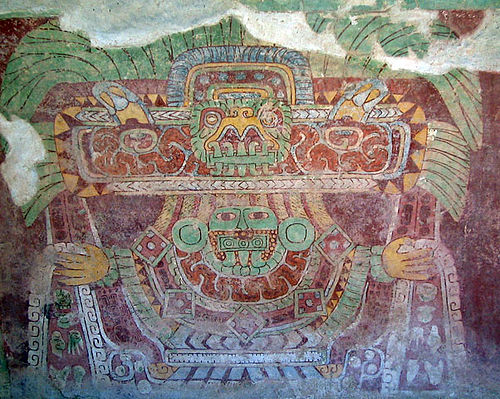
Actual mural from the Tetitla compound showing a similar portrait.
•
The Great Goddess
In the Tepantitla and Tetitla murals, the Great Goddess wears a frame headdress that includes the face of a green bird, generally identified as an owl or quetzal. She is shown among several spiders and with a yellow body coloration, further distinguishing her from other Mesoamerican deities. Her single most distinguishing feature is a nosepiece consisting of a rectangular bar with three circles. Immediately below this bar hang three or five "fangs". The outer fangs curl away from the center, while the middle fang points down.
In the depiction from the Tepantitla compound, the Great Goddess appears with vegetation growing out of her head, perhaps a world treeor hallucinogenic morning glory vines. Spiders and butterflies appear on the vegetation and water drips from its branches and flows from the hands of the Great Goddess. Water also appears to be flowing from her lower body. It was these many representations of water that led Caso to declare this to be a representation of the rain god, Tlaloc.
Below this depiction, separated from it by two interwoven serpents and a talud-tablero, is a scene showing dozens of small human figures, usually wearing only a loincloth and often showing a speech scroll
(see photo below). Several of these figures are swimming in the criss-crossed rivers flowing from a mountain at the bottom of the scene. Caso interpreted this scene as the afterlife realm of Tlaloc although this interpretation has also been challenged, most recently by María Teresa Uriarte, who finds that "this mural represents Teotihuacan as [the] prototypical civilized city associated with the beginning of time and the calendar".
•
The Great Goddess
In the Tepantitla and Tetitla murals, the Great Goddess wears a frame headdress that includes the face of a green bird, generally identified as an owl or quetzal. She is shown among several spiders and with a yellow body coloration, further distinguishing her from other Mesoamerican deities. Her single most distinguishing feature is a nosepiece consisting of a rectangular bar with three circles. Immediately below this bar hang three or five "fangs". The outer fangs curl away from the center, while the middle fang points down.
In the depiction from the Tepantitla compound, the Great Goddess appears with vegetation growing out of her head, perhaps a world treeor hallucinogenic morning glory vines. Spiders and butterflies appear on the vegetation and water drips from its branches and flows from the hands of the Great Goddess. Water also appears to be flowing from her lower body. It was these many representations of water that led Caso to declare this to be a representation of the rain god, Tlaloc.
Below this depiction, separated from it by two interwoven serpents and a talud-tablero, is a scene showing dozens of small human figures, usually wearing only a loincloth and often showing a speech scroll
(see photo below). Several of these figures are swimming in the criss-crossed rivers flowing from a mountain at the bottom of the scene. Caso interpreted this scene as the afterlife realm of Tlaloc although this interpretation has also been challenged, most recently by María Teresa Uriarte, who finds that "this mural represents Teotihuacan as [the] prototypical civilized city associated with the beginning of time and the calendar".
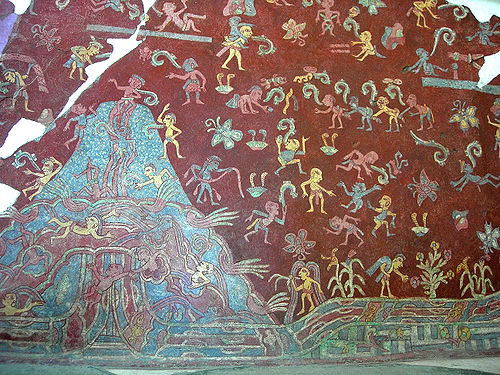
A portion of the actual mural from the Tepantitla compound which appears under the Great Goddess portrait. There are many interpretations of this scene.
Domain
The Great Goddess is thought to have been a goddess of the underworld, darkness, the earth, water, war, and possibly even creation itself. To the ancient civilizations of Mesoamerica, the jaguar, the owl, and especially the spider were considered creatures of darkness, often found in caves and during the night. The fact that the Great Goddess is frequently depicted with all of these creatures further supports the idea of her underworld connections.
In many murals, the Great Goddess is shown with many of the scurrying arachnids in the background, on her clothing, or hanging from her arms. She is often seen with shields decorated with spider webs, further suggesting her relationship with warfare. Her nosepiece is the single most recognizable adornment of the deity, finalizing her transformation into the arachnid-like goddess.
Domain
The Great Goddess is thought to have been a goddess of the underworld, darkness, the earth, water, war, and possibly even creation itself. To the ancient civilizations of Mesoamerica, the jaguar, the owl, and especially the spider were considered creatures of darkness, often found in caves and during the night. The fact that the Great Goddess is frequently depicted with all of these creatures further supports the idea of her underworld connections.
In many murals, the Great Goddess is shown with many of the scurrying arachnids in the background, on her clothing, or hanging from her arms. She is often seen with shields decorated with spider webs, further suggesting her relationship with warfare. Her nosepiece is the single most recognizable adornment of the deity, finalizing her transformation into the arachnid-like goddess.
Other interpretations
While the consensus is that these murals show a single deity or supernatural, there are other interpretations within the archaeological community:
• Annabeth Headrick argues, based on comparisons with other Meso American iconography, religious practices, and creation myths that this figure is actually a "world tree" identified with the Milky Way, growing out of a sacred mountain.
• In a 2006 article in Ancient Mesoamerica, Zoltán Paulinyi argues that the Great Goddess or Spider Woman is "highly speculative" and is a result of fusing up to six unrelated gods and goddesses.
• In "The Olmec Mountain and Tree Creation in Mesoamerican Cosmology", Linda Schele states that the primary Spider Woman mural is "either a Teotihuacan ruler or the Great Goddess"..
• Similarly, in his web article, John Q. Jacobs finds that "While differing on specifics, most authors accept a religious interpretation for many elements of the mural art. I question whether evidence supports this broad interpretation."
While the consensus is that these murals show a single deity or supernatural, there are other interpretations within the archaeological community:
• Annabeth Headrick argues, based on comparisons with other Meso American iconography, religious practices, and creation myths that this figure is actually a "world tree" identified with the Milky Way, growing out of a sacred mountain.
• In a 2006 article in Ancient Mesoamerica, Zoltán Paulinyi argues that the Great Goddess or Spider Woman is "highly speculative" and is a result of fusing up to six unrelated gods and goddesses.
• In "The Olmec Mountain and Tree Creation in Mesoamerican Cosmology", Linda Schele states that the primary Spider Woman mural is "either a Teotihuacan ruler or the Great Goddess"..
• Similarly, in his web article, John Q. Jacobs finds that "While differing on specifics, most authors accept a religious interpretation for many elements of the mural art. I question whether evidence supports this broad interpretation."

A 22 ton sculpture of a water goddess was excavated in the plaza before the Pyramid of the Moon. The stark geometric style epitomizes Teotihuacán stone carving.
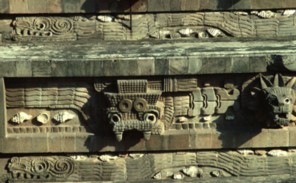
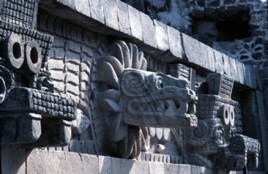
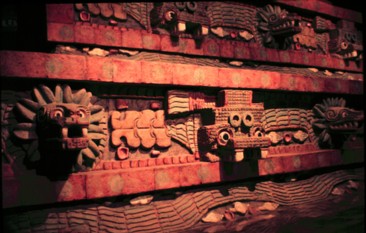

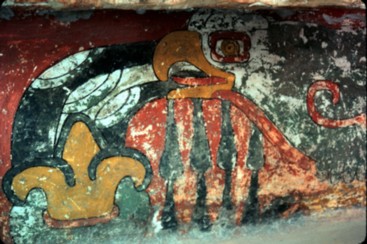


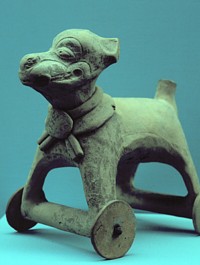
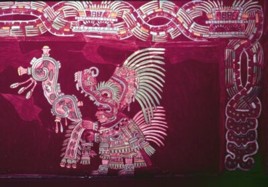
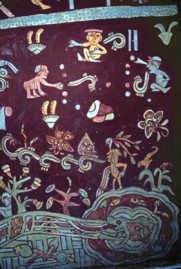
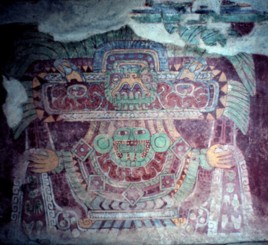
This view of the stepped front facade of the Quetzalcoatl Pyramid illustrates the elements of the repeating design.
Feathered Serpent and Tlaloc masks project from the facade
The Quetzalcoatl Pyramid facade has been partially recreated in the National Museum of Anthropology in Mexico City. Trace amounts of the original paints allowed for a full color recreation.
A large stone statue from the ruins, housed in the Teotihuacan gallery of the Museum of Anthropology.
Most surfaces of the multitude of pyramid facades at Teotihuacan were painted with bright colors.
Vivid fresco murals also decorated the interiors of buildings. Several are recreated in the museum.
Vivid fresco murals also decorated the interiors of buildings. Several are recreated in the museum.
On the same level and a few feet away are found well preserved murals of eagles and jaguars.
Excavations at Teotihuacan have revealed that older structures were infilled and built upon with newer buildings. This view is of an excavated substructure near the Pyramid of the Moon.
Many areas of the city center have several layers of ruins, preserving an older era of building below successive construction.
Many areas of the city center have several layers of ruins, preserving an older era of building below successive construction.
A wheeled toy.
The interpretation of the art, iconography and symbolism at Teotihuacan has remained elusive, or, where proposed, often there are conflicting interpretations
Tepantila mural recreation.
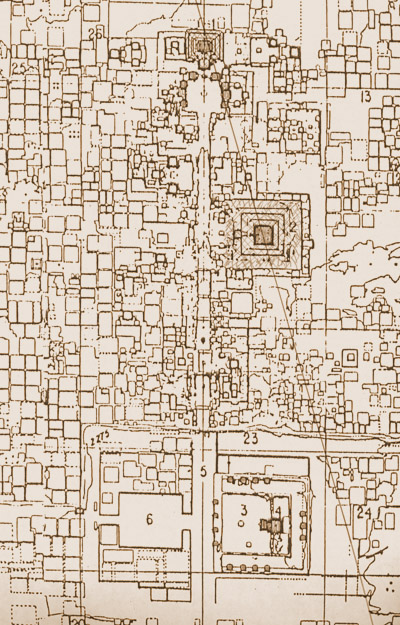
Teotihuacan
The ancient city of Teotihuacan is located just 50 kilometers north-east of the center of Mexico city and is well worth at least one or two days of exploration. There are many restored buildings to explore, as well as artwork and artifacts recovered from the site, as well as the two enormous structures for which the city is best known, the Pyramid of the Moon, shown here, and the even larger Pyramid of the Sun. Unlike the pyramids of Egypt, the pyramids at Teotihuacan aren't build of solid stone, instead they consist of stone and brick rubble covered with layers of cut stone, however they're still an extraordinary achievement, especially since all this was done without the benefit of pack animals, metal tools or the wheel.
The ancient city of Teotihuacan is located just 50 kilometers north-east of the center of Mexico city and is well worth at least one or two days of exploration. There are many restored buildings to explore, as well as artwork and artifacts recovered from the site, as well as the two enormous structures for which the city is best known, the Pyramid of the Moon, shown here, and the even larger Pyramid of the Sun. Unlike the pyramids of Egypt, the pyramids at Teotihuacan aren't build of solid stone, instead they consist of stone and brick rubble covered with layers of cut stone, however they're still an extraordinary achievement, especially since all this was done without the benefit of pack animals, metal tools or the wheel.
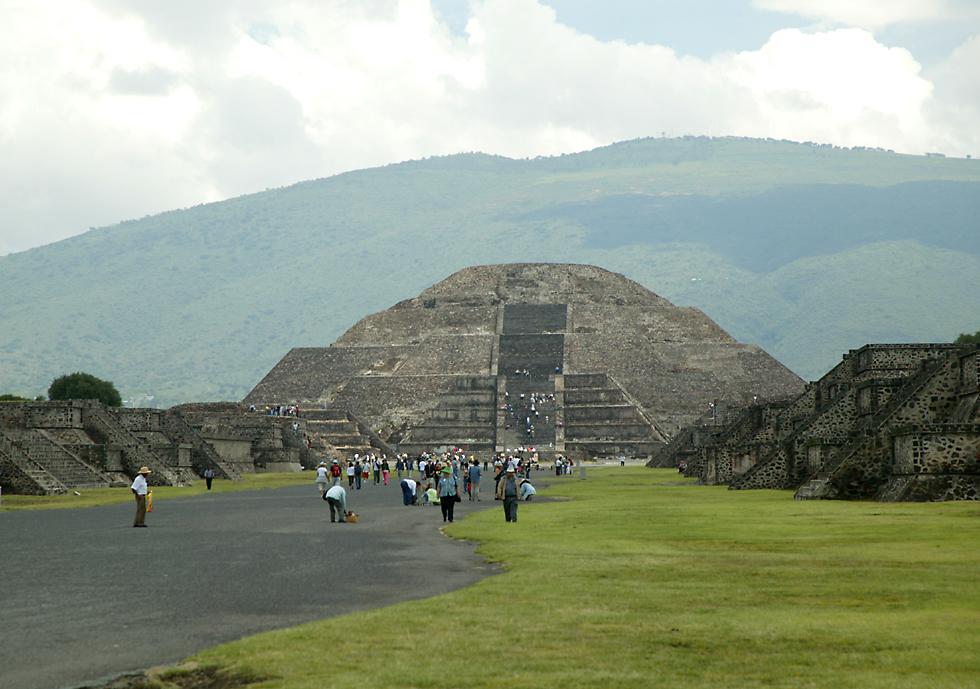
see the Pyramid of the Moon from across the Plaza of the Moon, which is surrounded by 12 temple platforms. Surprisingly, no-one knows who built Teotihuacan; the name itself is from the Aztec Nahuatl language and is thought to mean the "city of the gods". The Aztecs, who founded Mexico city, came on the scene much later and considered the ruins they found at Teotihuacan to be sacred, making their own religious pilgrimages there. Archaeological study has determined that the main construction period started around 300BC, and continued for hundreds of years until the city's violent destruction in the 7th century.

The Pyramid of the Moon photographed from the top of the Pyramid of the Sun. The stairs on both pyramids begin on a stone structure which is attached to the pyramid, but many people consider the Pyramid of the Moon to be more graceful than the earlier Pyramid of the Sun. The large stone altar in the middle of the Plaza of the Moon is thought to have been used for ceremonial dancing. Around the extremities of the plaza you can get a good idea of how the city must have looked to the first Europeans, with most of the buildings, including the pyramids, completely overgrown by a layer of vegetation.
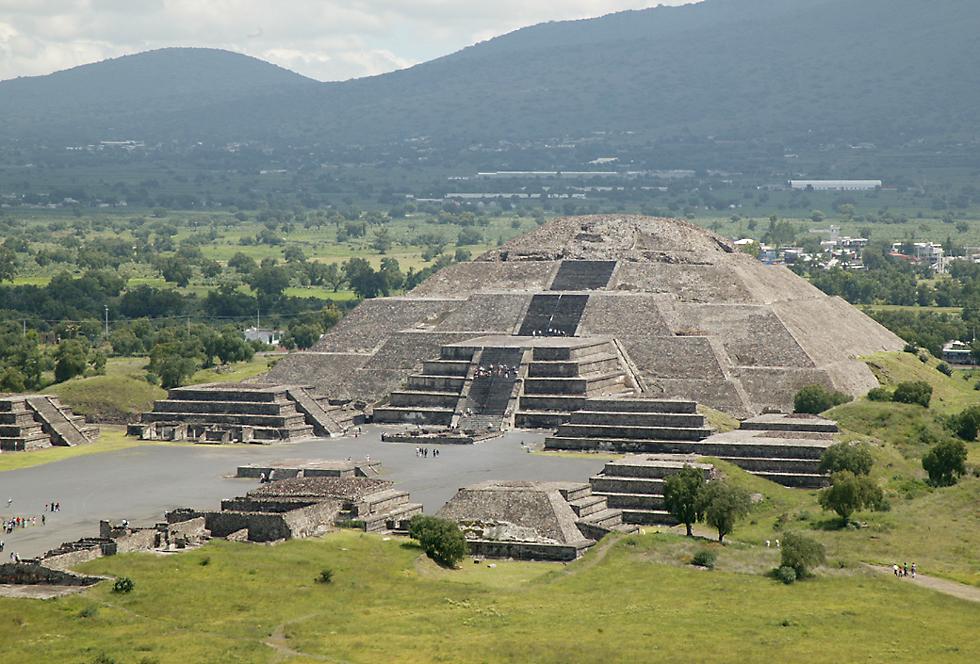
The Palace of Quetzalpapalotl is located a short distance to the south-west of the Pyramid of the Moon. This is thought to be the place where the high priest lived, and is one of a number of former residences of the nobility which have been restored and made open to visitors.
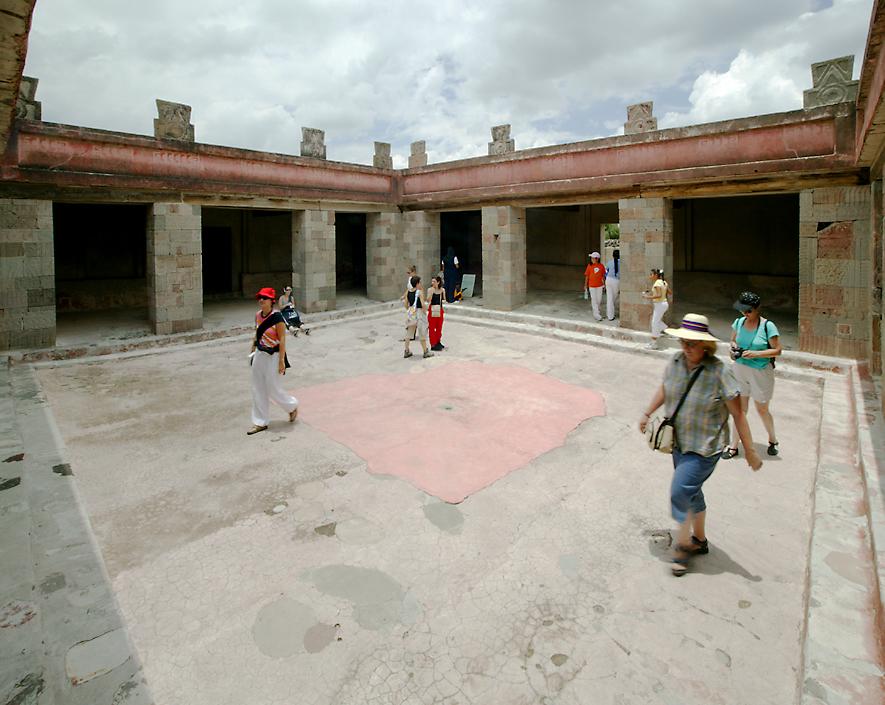
The name Quetzalpapalotl is Nahuatl for the "Quetzal butterfly" and it was applied to this building because of carved images like this one which appear on the columns surrounding the courtyard shown above. Some of these images are thought to represent the quetzal bird, which was revered by pre-European peoples living throughout central America. Some of the images show a creature which is a combination of the quetzal and a butterfly, hence the name.
The black volcanic glass called obsidian forms the eyes of the birds; it seems rather odd that the pieces of stone used to make the pillars are cut into irregularly sized and shaped blocks, and also vary in texture and color from each other. I'm not sure if some of the blocks are reconstructions, but even if they are there's still a lot of irregularity in the construction of the pillar.
The black volcanic glass called obsidian forms the eyes of the birds; it seems rather odd that the pieces of stone used to make the pillars are cut into irregularly sized and shaped blocks, and also vary in texture and color from each other. I'm not sure if some of the blocks are reconstructions, but even if they are there's still a lot of irregularity in the construction of the pillar.

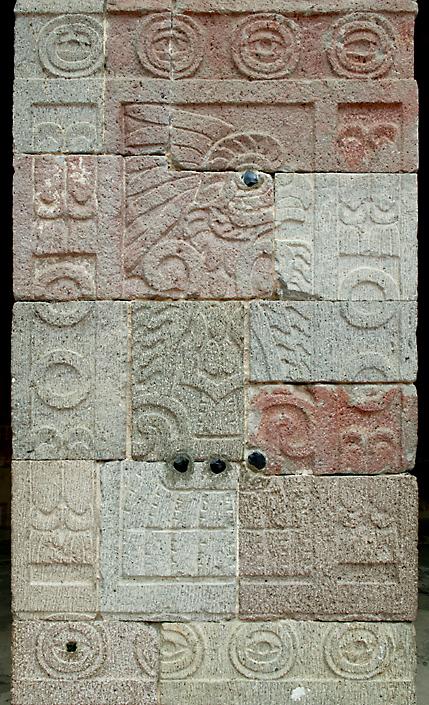
These are the lintels and roof ornaments surrounding the courtyard. There are many painted and carved designs of abstract geometric figures in this palace; like other ancient American peoples, the builders of Teotihuacan were extraordinarily skilled at observing and predicting astronomical events and accurately recording the passage of time. This is one of the very few buildings in the entire city whose roof line is still intact.
in the same small area as the Palace of Quetzalpapalotl. This mural showing pumas with feathered head-dresses is in the appropriately named Palace of the Jaguars. The figure in the five-pointed stars above the pumas is the rain and maize god Tlaloc, probably the most powerful god in ancient central America. From this palace you can enter the subterranean Temple of the Plumed Conch Shells which has murals of shells, perhaps outfitted as musical instruments, together with birds spouting water, painted in green, blue, yellow and red.



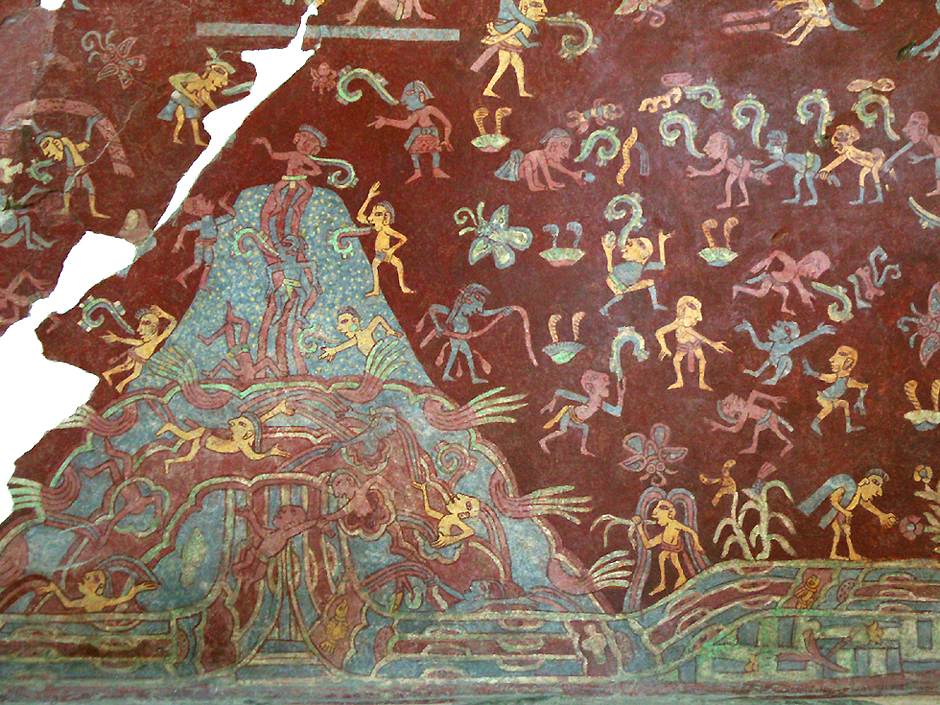
In the last photo of the Pyramid of the Moon you can see a path which leads to the south-east of the pyramid, which takes you to the Palace of Tepantitla, which was also thought to be the residence of a priest. There are an enormous number of murals scattered around the buildings at Teotihuacan; several particularly valuable ones were discovered in this palace in 1942, including this procession of priests in full ceremonial costume.
closeup from the previous mural. As well as paintings of gods and animals like pumas, there are also many frescoes showing people, like the priests in this mural wearing elaborate head-dresses. The strange looking curved shapes in front of this person are actually speech bubbles which signify that he is talking or chanting, though there's no indication of what he is saying - unlike the Maya, the inhabitants of Teotihuacan left no traces of a writing system.
The most famous painting in this palace is called The Paradise of Tlaloc. The god Tlaloc is shown several times in frescoes, and in the one which depicts his "paradise" many people are shown in the middle of a variety of acts - diving and swimming in a river with fish, talking to each other, eating, picking flowers and, near the top right-hand corner of this photograph, holding hands between their legs! As you can see, there's an abundance of speech bubbles, as well as various butterflies and other insects.
Teotihuacan once occupied an area of over 30 square kilometers and had a population of between 150,000 and 200,000 people; in 600 AD it is estimated to have been the sixth largest city in the entire world. It is bisected by this broad road running north and south, which nowadays is called The Avenue of the Dead, because of the mistaken Aztec belief that the buildings which lined it were tombs. The Pyramid of the Moon is at the avenue's northern end and the Pyramid of the Sun, which you can see here, is to its east, about 500 meters south of the Pyramid of the Moon. Look closely and you'll see a large number of people standing on the summit.
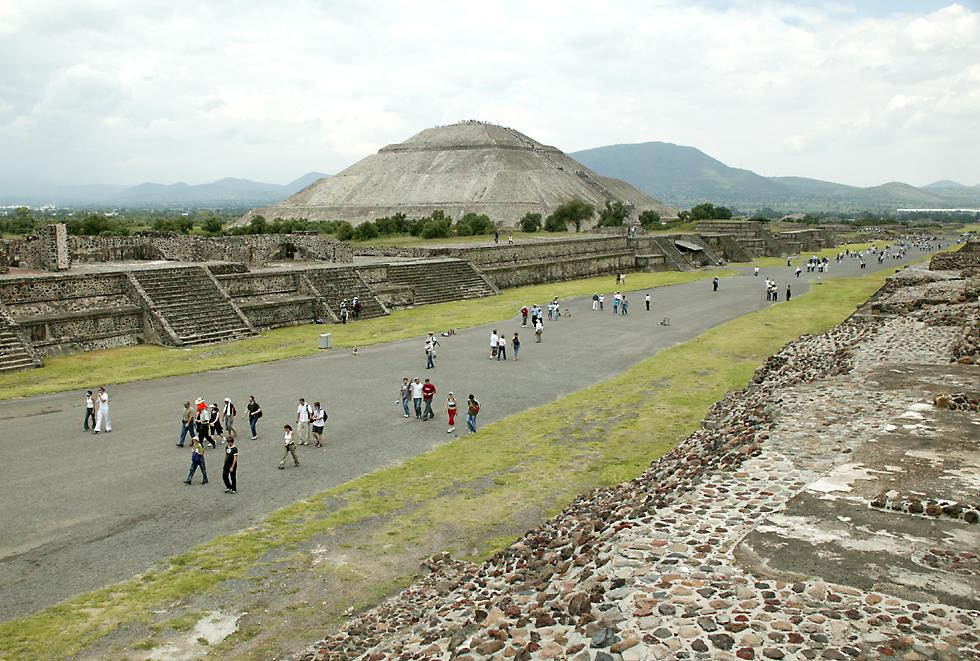
The Pyramid of the Sun, with an estimated weight of three million tons, is much larger than the Pyramid of the Moon, and was also built earlier. Each side is 222 meters long and it's over 70 meters high, making it the third largest pyramid in the world by volume, after the Great Pyramid of Cheops in Egypt and the unrestored pyramid at the Mexican city of Cholula. Unfortunately because of the building method a lot of reconstruction was needed to get it to its current state, and there's considerable uncertainty about its original appearance.
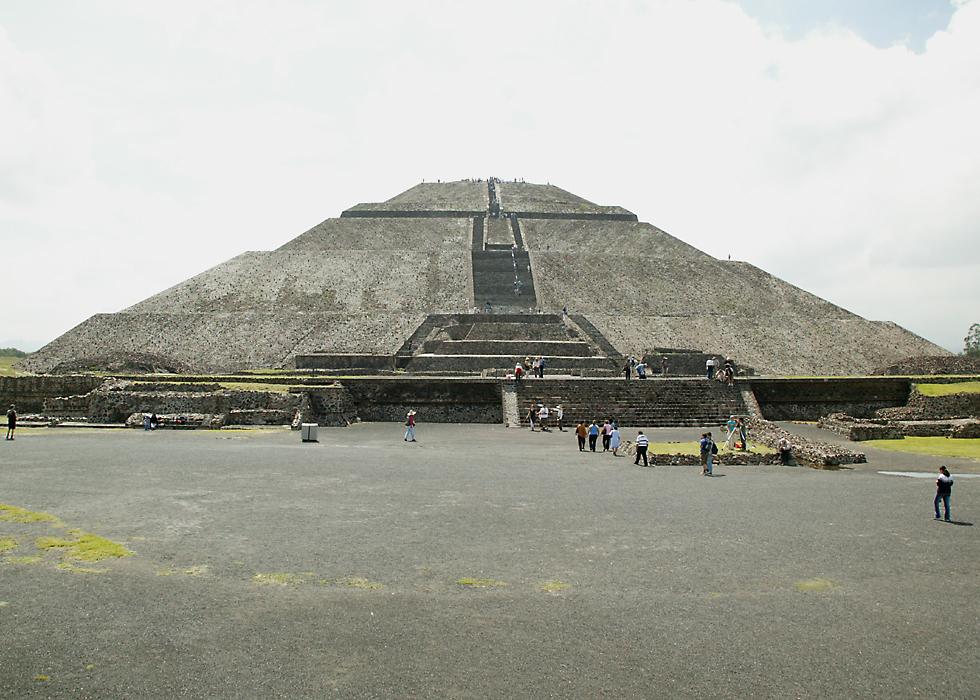
The Aztecs believed that this pyramid was dedicated to the worship of the sun god, and archaelogical research on the site appears to give support to the idea. In 1971 a 100 meter long tunnel was found leading from the pyramid's west side to a cave and a spring with religious items directly beneath its center. It's thought that the pyramid was once covered in a layer of plaster painted red, and that there was a temple at the summit.
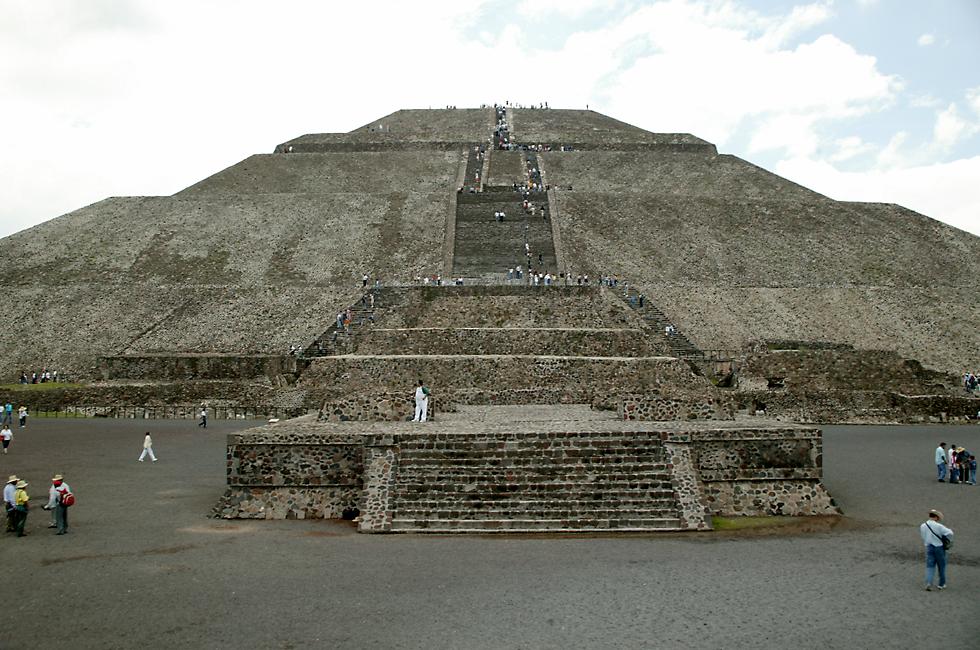
the top, making it quite a long haul - higher than a 21 storey building, and the altitude at this location makes it seem even higher! However the view from the top is excellent and it's worth going up to take in the sights with all of the other tourists and, sometimes, the crystal wielding spiritualists who are still drawn by the mystical power of this place. There are also a surprising number of butterflies up there, participating in the mating behavior known as "hill topping".


Just to the south of the Pyramid of the Sun is the main site museum, which is the primary repository for artifacts discovered here.
There's a sculpture garden outside the museum where stone items are displayed, like this water drain and end piece, looking for all the world like a gargoyle from one of the water drains on a medieval cathedral in Europe.
There's another museum with murals and other items on the far western side of the site near gate two, but unfortunately I didn't have time to visit.
There's a sculpture garden outside the museum where stone items are displayed, like this water drain and end piece, looking for all the world like a gargoyle from one of the water drains on a medieval cathedral in Europe.
There's another museum with murals and other items on the far western side of the site near gate two, but unfortunately I didn't have time to visit.
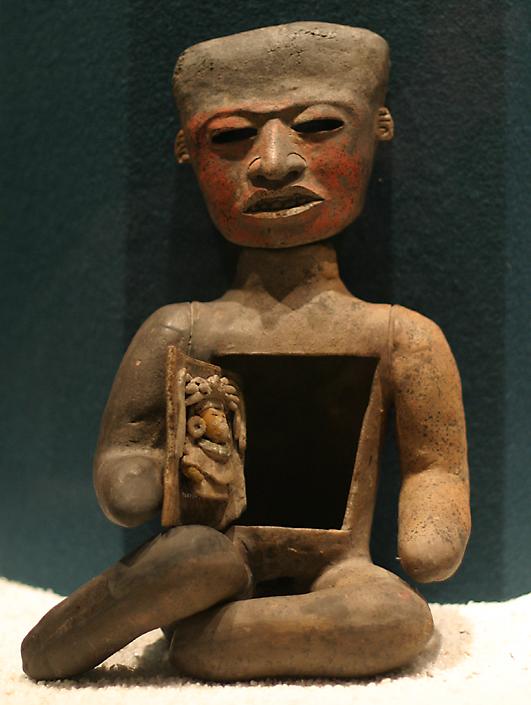
There's a very large collection on display inside the modern looking site museum, including a huge model of the city as it would have been in its heyday, right in front of a gigantic glass wall looking out on the Pyramid of the Sun.
Teotihuacan was the center of a large trading empire which included nearby cities such as Cholula as well as much more distant population centers like Tikal in present-day Guatemala, so there are also displays of trade items found at Teotihuacan which originated from other sites. There's even evidence that different ethnic groups might have had separate living areas within the city.
Central Mexico was a source of obsidian, highly prized here and elsewhere as a material for making sharp knives. There are also tools such as mortars and pestels made from rock, as well as pottery items.
Teotihuacan was the center of a large trading empire which included nearby cities such as Cholula as well as much more distant population centers like Tikal in present-day Guatemala, so there are also displays of trade items found at Teotihuacan which originated from other sites. There's even evidence that different ethnic groups might have had separate living areas within the city.
Central Mexico was a source of obsidian, highly prized here and elsewhere as a material for making sharp knives. There are also tools such as mortars and pestels made from rock, as well as pottery items.
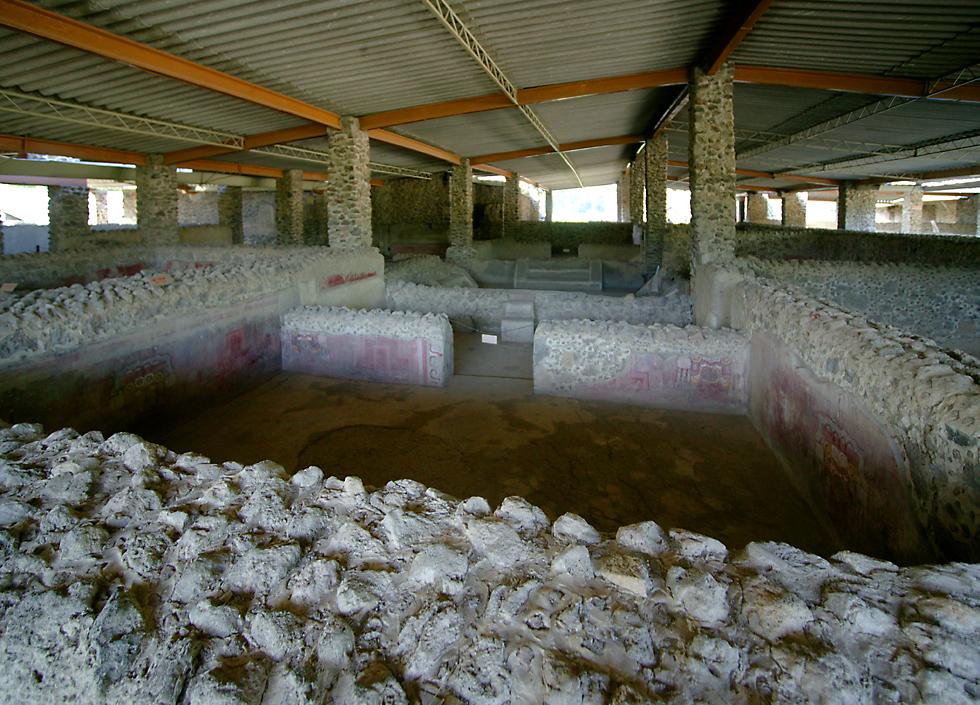
There's a very large collection on display inside the modern looking site museum, including a huge model of the city as it would have been in its heyday, right in front of a gigantic glass wall looking out on the Pyramid of the Sun.
Teotihuacan was the center of a large trading empire which included nearby cities such as Cholula as well as much more distant population centers like Tikal in present-day Guatemala, so there are also displays of trade items found at Teotihuacan which originated from other sites. There's even evidence that different ethnic groups might have had separate living areas within the city.
Central Mexico was a source of obsidian, highly prized here and elsewhere as a material for making sharp knives. There are also tools such as mortars and pestels made from rock, as well as pottery items.
There are a couple of transplanted burial sites found here, showing how the bodies were laid out with some of their possessions. There's also a large collection of pottery containers and figures depicting gods like Tlaloc as well as workers going about their trades, and nobles in their costumes. Some of the figures are very imaginative, like the extraordinary article shown here.
On the far western side of the present-day archaeological site, a little under a kilometer south of the Pyramid of the Sun, is a complex excavated in the 1940s which is now called the Palace of Tetitla. There's nothing much in the way of monumental architecture, but it's famous for the murals which you can see here, which once covered the walls of the many living areas within the complex. Unfortunately, as elsewhere in Teotihuacan, most of the buildings have been demolished nearly down to ground level, but what little remains is remarkable for its wealth of artistry.
Teotihuacan was the center of a large trading empire which included nearby cities such as Cholula as well as much more distant population centers like Tikal in present-day Guatemala, so there are also displays of trade items found at Teotihuacan which originated from other sites. There's even evidence that different ethnic groups might have had separate living areas within the city.
Central Mexico was a source of obsidian, highly prized here and elsewhere as a material for making sharp knives. There are also tools such as mortars and pestels made from rock, as well as pottery items.
There are a couple of transplanted burial sites found here, showing how the bodies were laid out with some of their possessions. There's also a large collection of pottery containers and figures depicting gods like Tlaloc as well as workers going about their trades, and nobles in their costumes. Some of the figures are very imaginative, like the extraordinary article shown here.
On the far western side of the present-day archaeological site, a little under a kilometer south of the Pyramid of the Sun, is a complex excavated in the 1940s which is now called the Palace of Tetitla. There's nothing much in the way of monumental architecture, but it's famous for the murals which you can see here, which once covered the walls of the many living areas within the complex. Unfortunately, as elsewhere in Teotihuacan, most of the buildings have been demolished nearly down to ground level, but what little remains is remarkable for its wealth of artistry.
Here's a mural on one of the best preserved walls, identified as portico 11, mural 3. It shows The Great Goddess, with various motifs to represent agricultural fertility. It's incredible that so much of the rich red, yellow, blue and green has survived in such a damp environment, especially since the surrounding building was derelict and unable to provide much protection. I'm not sure how long articles like this will survive being unearthed - although there was a sign directly above this mural saying "no flash [photography]", the screen in front had not been drawn, and sunlight was falling directly onto it.

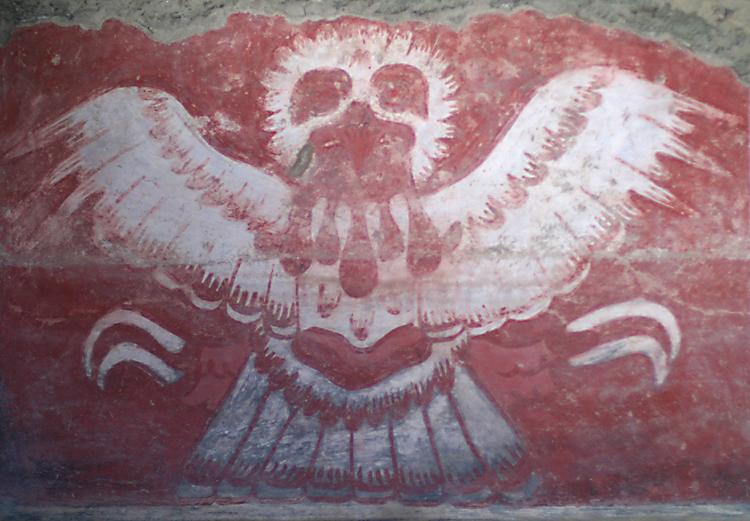
One of several eagle images at this location, other animals include dogs, jaguars, birds and snails.
People are depicted performing ceremonies, and also secular acts like swimming with nets and collecting shell fish At the southern end of the Avenue of the Dead is the 400 meter square sunken complex which the Spaniards called The Citadel, mistaking its high walls and central courtyard for a fortification. In fact Teotihuacan seems to have been a peaceful place until its fiery end came, and there are no clear depictions of warriors or battles amongst its many murals. Rather, the citadel seems to have been a living area for many of the city's elite residents, and possibly a ceremonial area where most of the city's inhabitants could be gathered together.
People are depicted performing ceremonies, and also secular acts like swimming with nets and collecting shell fish At the southern end of the Avenue of the Dead is the 400 meter square sunken complex which the Spaniards called The Citadel, mistaking its high walls and central courtyard for a fortification. In fact Teotihuacan seems to have been a peaceful place until its fiery end came, and there are no clear depictions of warriors or battles amongst its many murals. Rather, the citadel seems to have been a living area for many of the city's elite residents, and possibly a ceremonial area where most of the city's inhabitants could be gathered together.
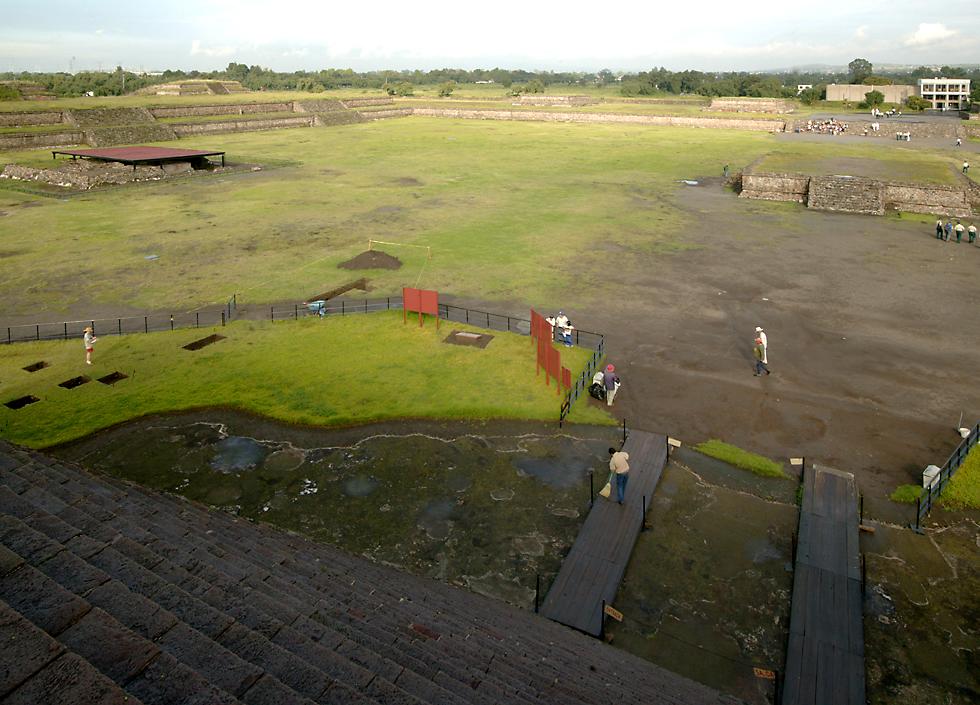
within the citadel is the Temple of Quetzalcoatl, the "plumed serpent", which was undergoing major restoration when I visited in August of 2004. There are actually two temples, the later of which completely covered the earlier one, in typical central American fashion. This is the only structure at Teotihuacan whose stone carvings are still intact. The figure with large eyes and two fangs immediately above the lower worker in this figure is thought to be either the rain god Tlaloc or the fire serpent which carried the sun on its daily journey. The plumed serpent itself is on the right, its head protruding from a necklace of petals, and the three-part item to the left of each plumed serpent head is said to be the rattle at the end of its tail. Conches, scallops and other sea shells appear between the protruding carvings, together with water motifs.

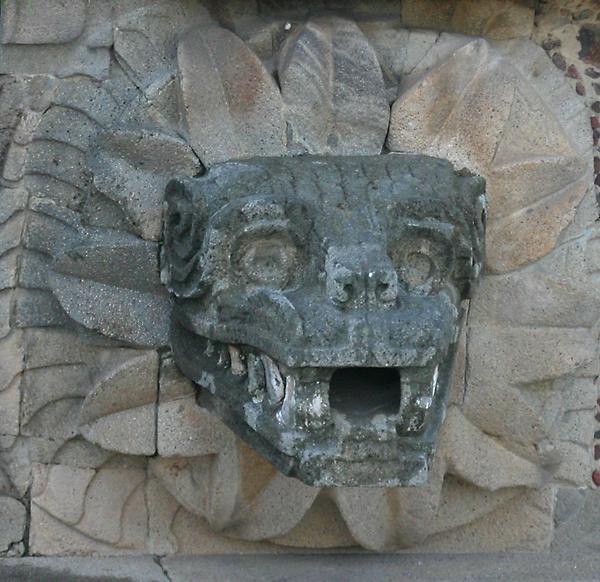
ere's a close up view of the plumed serpent. Quetzalcoatl is usually shown surrounded by 11 petals, which are also interpreted as feathers or plumes.
A steep set of stairs ascends the western side of the Temple of Quetzalcoatl, with more figures of the plumed serpent on either side. The temple is originally thought to have had six tiers, but only four remain. A few traces of color now exist, but it's believed that the entire temple would once have been painted in bright red, white and green.
A steep set of stairs ascends the western side of the Temple of Quetzalcoatl, with more figures of the plumed serpent on either side. The temple is originally thought to have had six tiers, but only four remain. A few traces of color now exist, but it's believed that the entire temple would once have been painted in bright red, white and green.
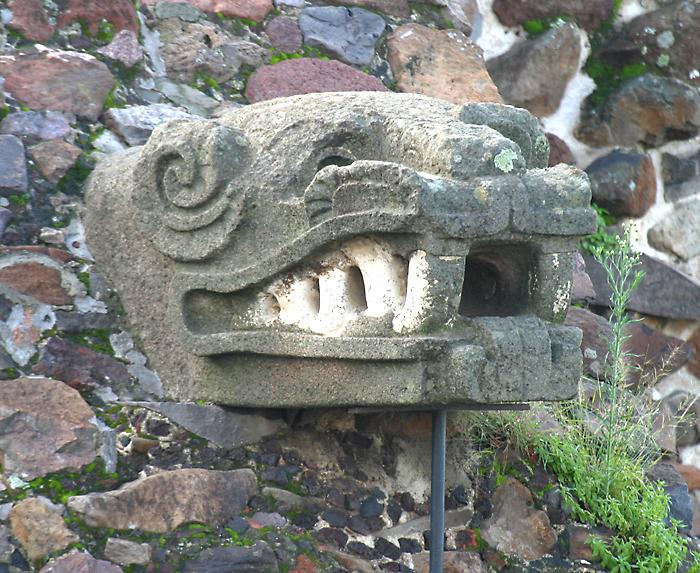
the whole layout of Teotihuacan was like huge clock-face, centred around the Pyramid of the Sun. The Avenue of the Dead, like one hand of a clock, pointed at where the Pleiades would have set on the Southern horizon on the 12 August 3114 BC, whilst the skull beneath the Pyramid of the Sun - like the other hand of the clock, pointed at the place on the horizon where the Pleiades set today."
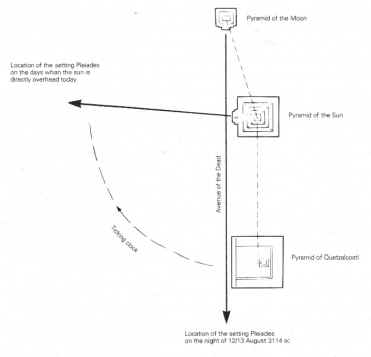
They also found that the 3 pyramids of Teotihuacan were a reflection of Orion's belt, just like the Giza pyramids of Egypt. They were told by elders of the Hopi Indian people that the extraterrestrials that brought the crystal skulls were from Sirius, Orion, and the Pleiades; (strangely enough, these are the three most common sources given by channels today). The information is held in the molecular crystal lattice, as in the silicon chips we use today, but can be accessed by consciousness. The Mitchell-Hedges skull was tested by Hewlett-Packard, who could find no tooling marks on it, and concluded that it would have taken 300 man-years to make.

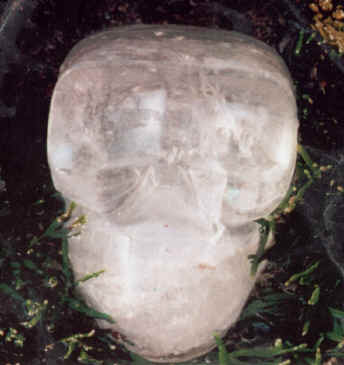
The belt of Orion at Giza: also at Teotihuacan " Ebmnagine", Elmera's (Vikki Cunningham's) alien-esque crystal skull
Originally;
"the skulls were kept inside a pyramid in a formation of tremendous power- known as the Ark. The Ark was composed of the 12 skulls from each of the sacred planets kept in a circle, with a thirteenth skull, the largest, placed in the centre of this formation. This thirteenth skull represents the collective consciousness of all the worlds. It connects up the knowledge of all the sacred planets."
When most people think of pyramids, they think of Egypt. For this reason it can be starting to learn that the world’s second and third largest pyramids are in fact in Mexico. The pyramids are a day trip, about an hour and a half out of the city. Leave early to beat the heat, wear some sunscreen and take plenty of water and food: there are not a lot of either for sale at the pyramids themselves.
There are two main pyramids to climb, the Pyramid of the Sun and the Pyramid of the Moon. Both afford great views of the area and give a small glimpse of the culture that constructed these pyramids so long ago.
Originally;
"the skulls were kept inside a pyramid in a formation of tremendous power- known as the Ark. The Ark was composed of the 12 skulls from each of the sacred planets kept in a circle, with a thirteenth skull, the largest, placed in the centre of this formation. This thirteenth skull represents the collective consciousness of all the worlds. It connects up the knowledge of all the sacred planets."
When most people think of pyramids, they think of Egypt. For this reason it can be starting to learn that the world’s second and third largest pyramids are in fact in Mexico. The pyramids are a day trip, about an hour and a half out of the city. Leave early to beat the heat, wear some sunscreen and take plenty of water and food: there are not a lot of either for sale at the pyramids themselves.
There are two main pyramids to climb, the Pyramid of the Sun and the Pyramid of the Moon. Both afford great views of the area and give a small glimpse of the culture that constructed these pyramids so long ago.
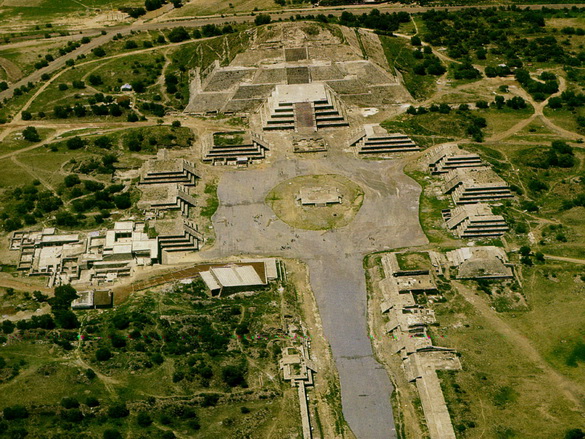
Valley of the Dead Taken While Standing on Pyramid of the Moon

View of Pyramid of the Moon at Teotihuacan From the Pyramid of the Sun
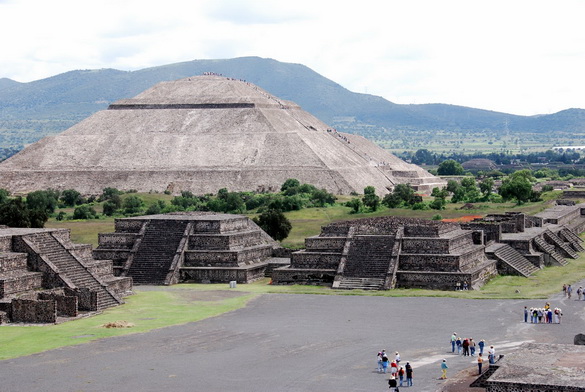
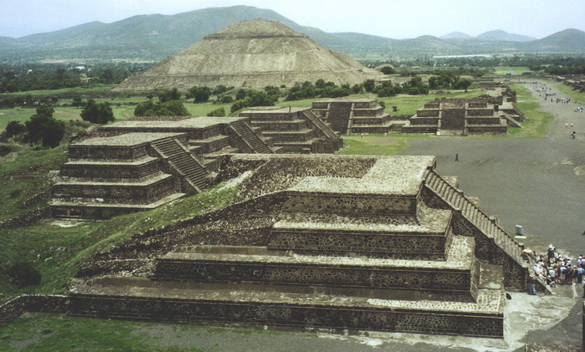
The largest pyramids in Central America
Teotihuacan - Pyramid of the Sun
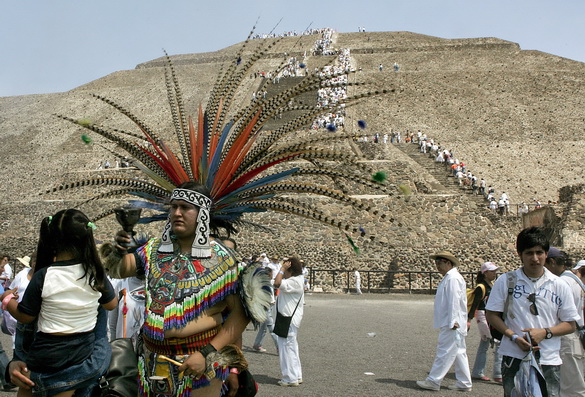
Performs a ritual in front of the Pyramid of the Sun in Teotihuacán
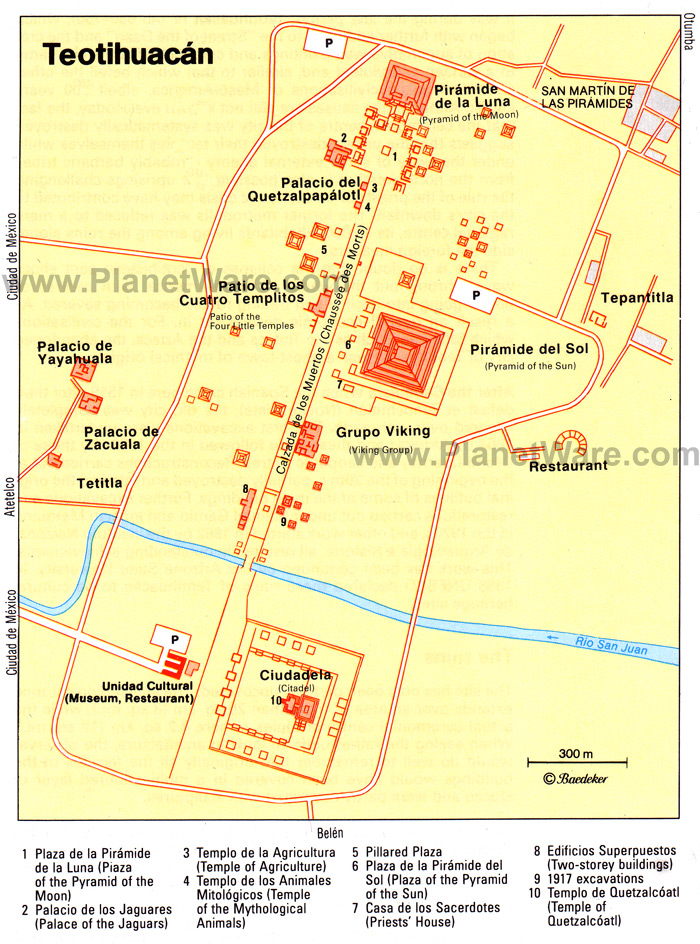
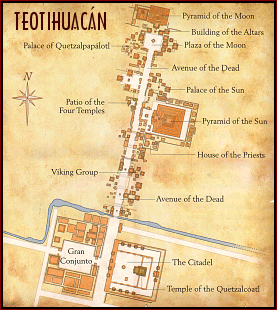
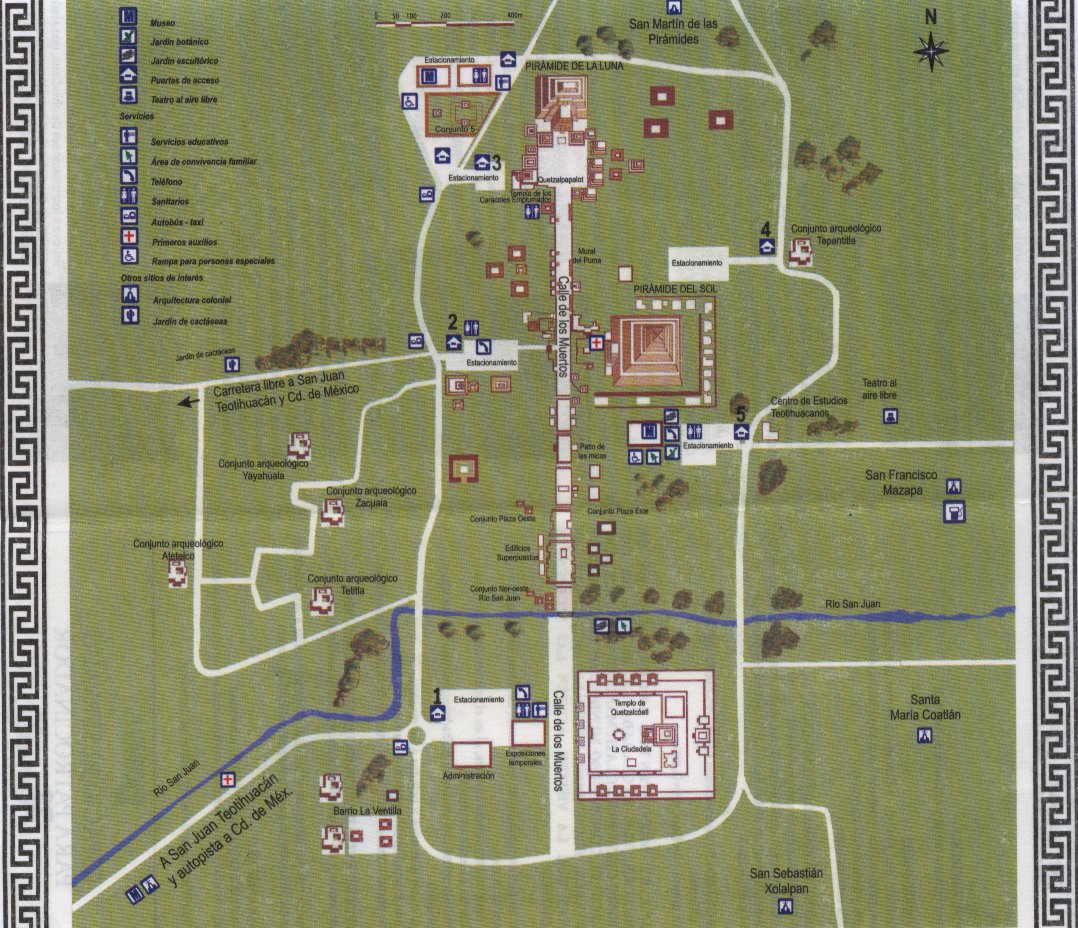
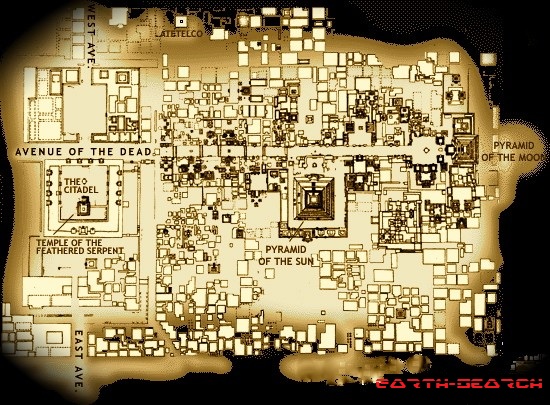

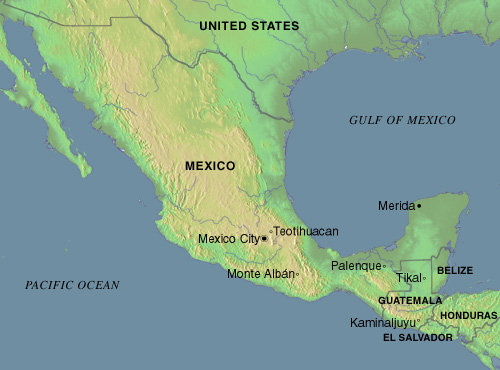
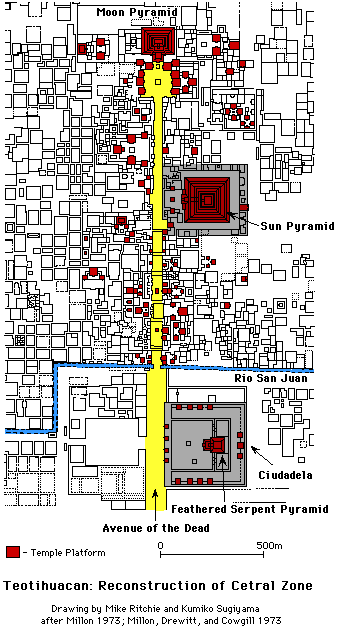
MAPS of TEOTIHUACAN
CLOSING STATEMENT
There are so many wonderful beauties at Teotihuacán and so many wonderful questions to be asked and answered. How could such a great city have their Pyramids and temples all line up with the planets and Orion?? How could a civilization back then know of such precision? Surly this must be evidence of Alien intervention/interaction
There are so many wonderful beauties at Teotihuacán and so many wonderful questions to be asked and answered. How could such a great city have their Pyramids and temples all line up with the planets and Orion?? How could a civilization back then know of such precision? Surly this must be evidence of Alien intervention/interaction
Teotihuacán
Tue, 22nd November, 2011
The wonderful City of Teotihuacán
Please Sign Guestbook
•100 BC - 0 AD Proto-Teotihuacan (two small hamlets in northern pocket of Valley of Mexico, population = 5000)
•0 BC - 150 AD Teotihuacan I - (Avenue of the Dead, Pyramid of the Sun established)
•150 AD - 300 AD Teotihuacan II - (Grid pattern established)
•300 AD - 650 AD Teotihuacan III - (Pinacle of development, population = 85,000-200,000)
•650 AD - 750 AD Teotihuacan IV - Decline and fall
•0 BC - 150 AD Teotihuacan I - (Avenue of the Dead, Pyramid of the Sun established)
•150 AD - 300 AD Teotihuacan II - (Grid pattern established)
•300 AD - 650 AD Teotihuacan III - (Pinacle of development, population = 85,000-200,000)
•650 AD - 750 AD Teotihuacan IV - Decline and fall

Double click here to edit this text.